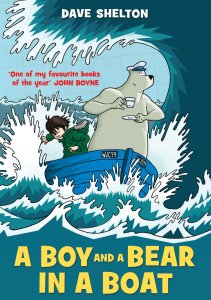I’ve updated my portfolio for 2024. Do have a little look through! (Click on the image below to open it.)
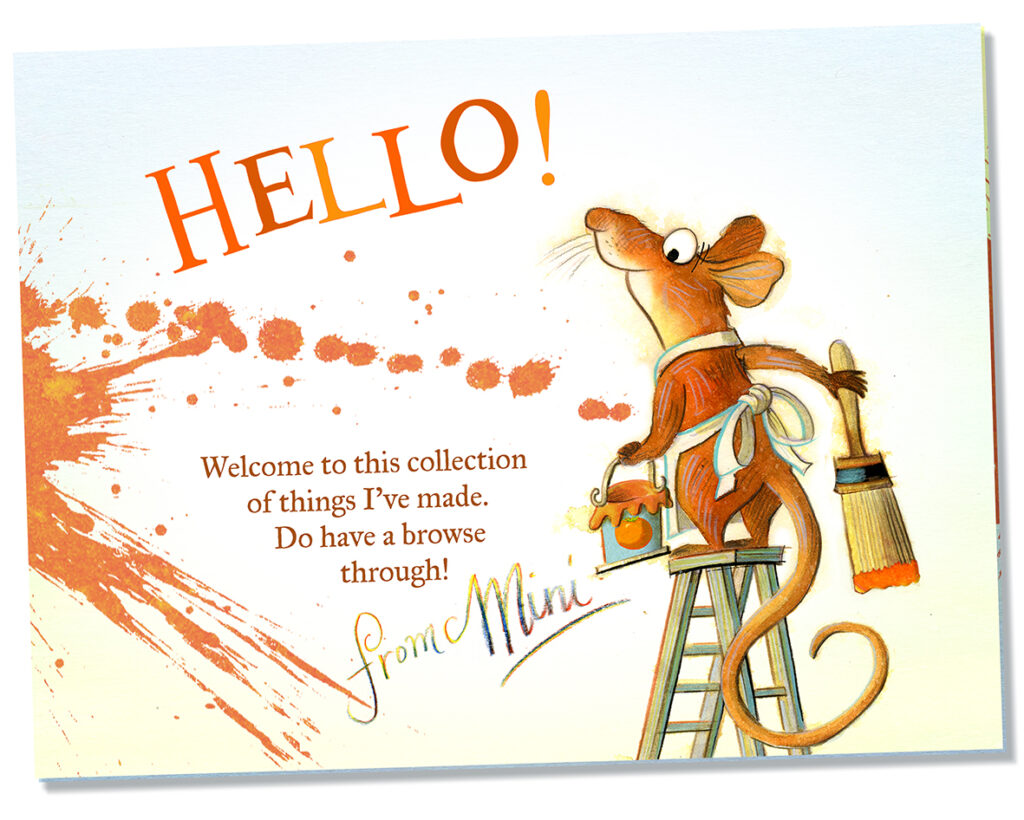

This year, I wasn’t too grabbed by the official Inktober2024 prompts. So I decided for October to do an alphabet: an Alphabestiary of Badly Stuffed Beasts – seen mostly in Natural History Museums over the years. So here they are. Ok, yes, it’s very difficult to stuff a jellyfish or a skeleton..(And they’re in the Shop here on Sketching Weakly.)
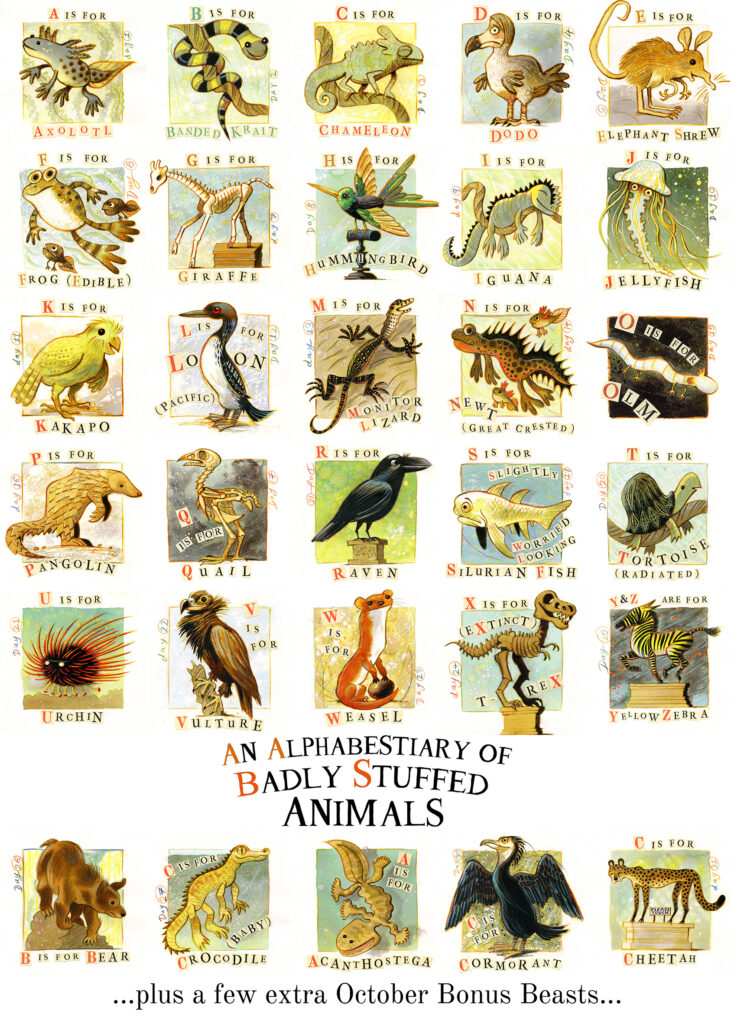
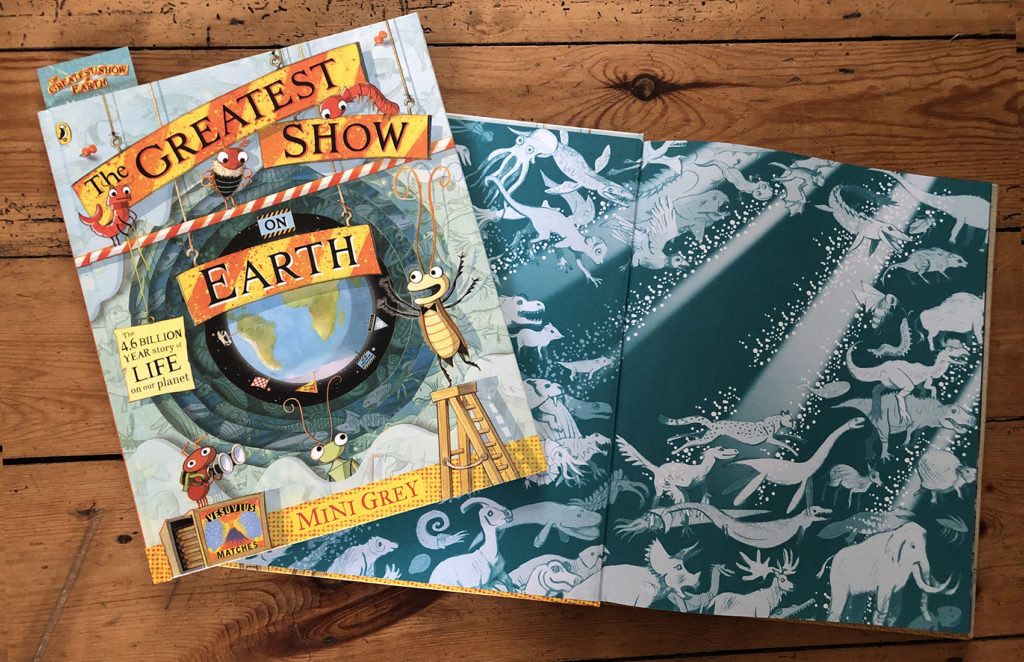
I’m so excited to be able to share with you my new book, The Greatest Show on Earth.
This book began in the Oxford Museum of Natural History, about 10 years ago. I was hanging out with my small son Herbie, and admiring the iguanodon skeleton, when I realized I didn’t know how long ago it was that the dinosaurs went extinct. Or even how old the Earth actually was.
Well, I discovered it’s 4.6 billion years old. But what does that 4.6 billion year timeline look like?
I wanted to tell the whole 4.6 billion years roller-coaster ride story of life on Earth in one book, so my readers could see ALL of this amazing and incredible story. I wanted my readers to be able to see each piece of the story at a glance, but also be able to dive deeper in to discover the unfolding inventions of evolution. I hope this book can bring Earth’s WHOLE story to young readers – in the company of Rod the Roach and his insect Troupe.
So come and take your seats for the ENTIRE history of Planet Earth, as we take a whistle-stop tour: from the birth of Earth, to the age of bacteria; from the era of dinosaurs to the moment of people…and beyond!
Find out more about The Greatest Show on Earth here.
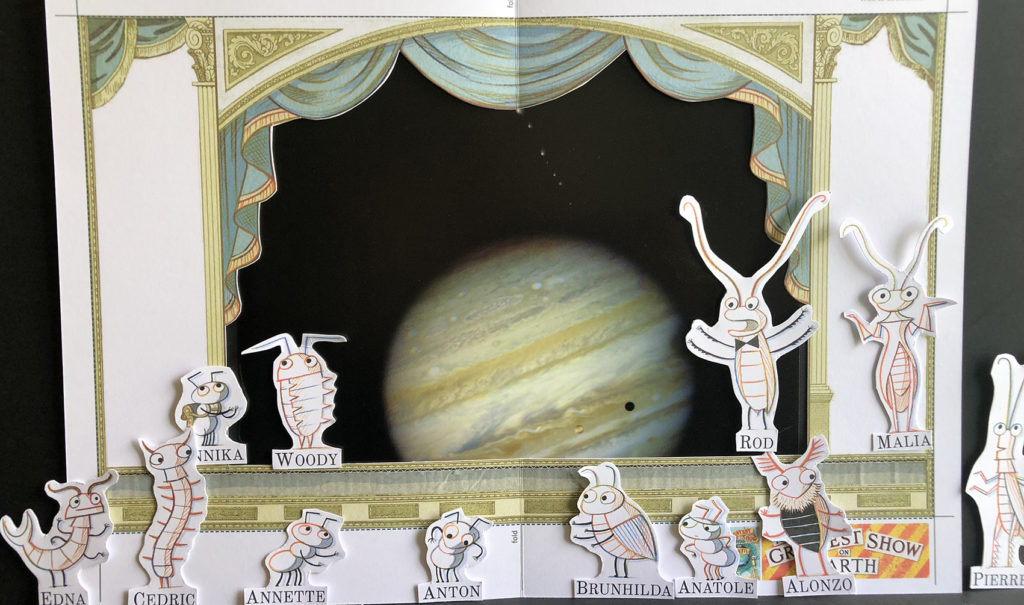
Welcome to Sketching Weakly!
Well Spring is really Springing, and here at Sketching Weakly we’ve been trying to learn to recognise more birds. At the top here you can see some of the birdlife from the cover of Money-Go-Round – written by Roger McGough with pictures by Mini.
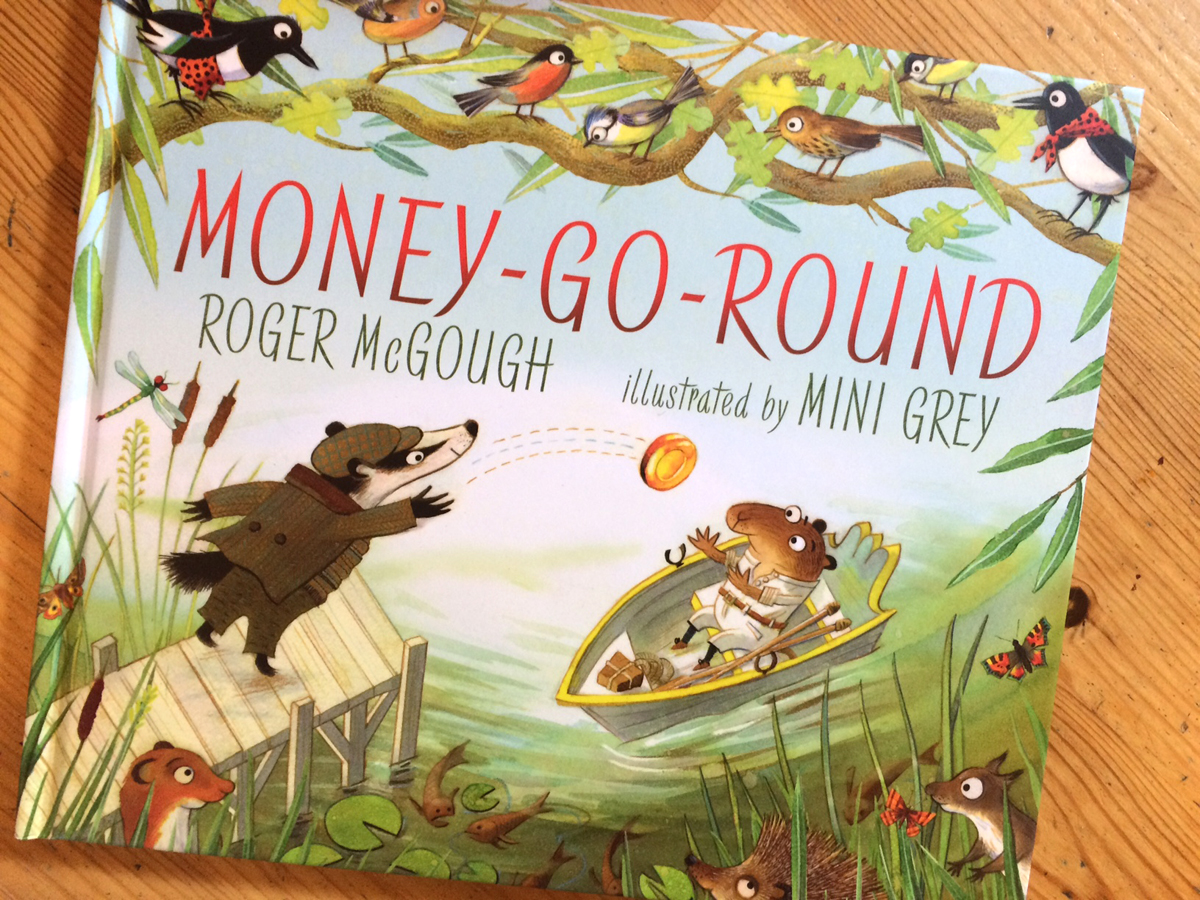
If you want to do a bit of bird-spotting out & about or in your garden, here’s a handy Spotter’s Guide to download and print.
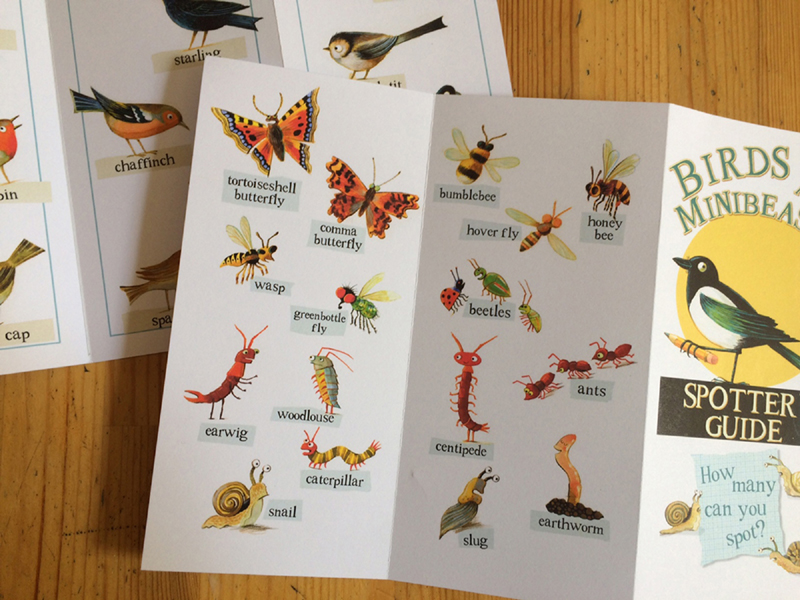
Click on the images below to download a pdf.
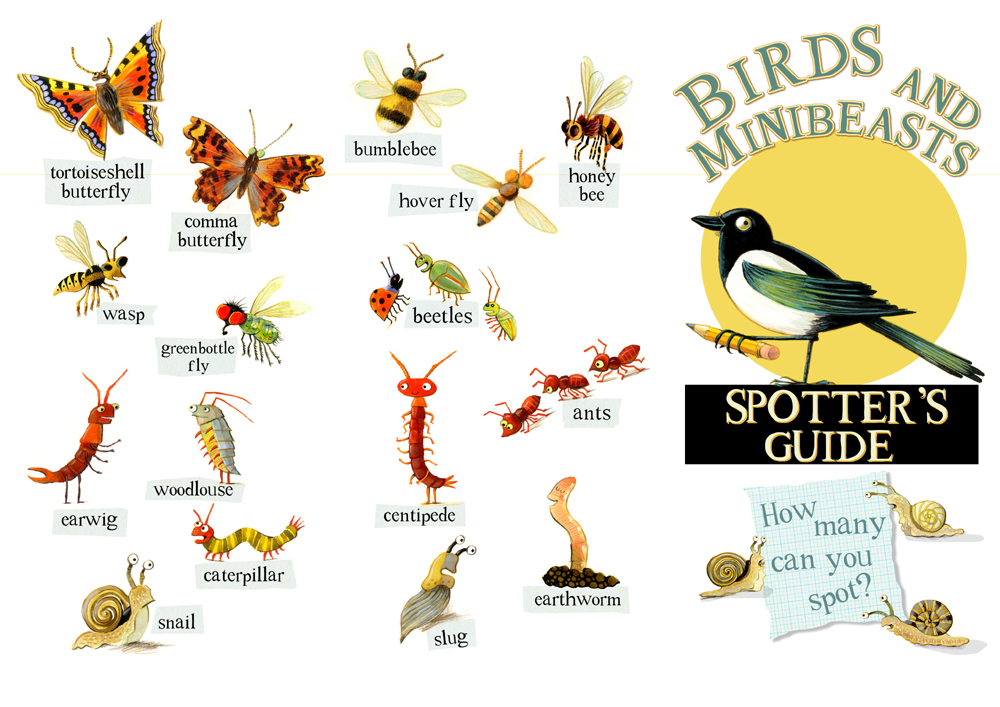
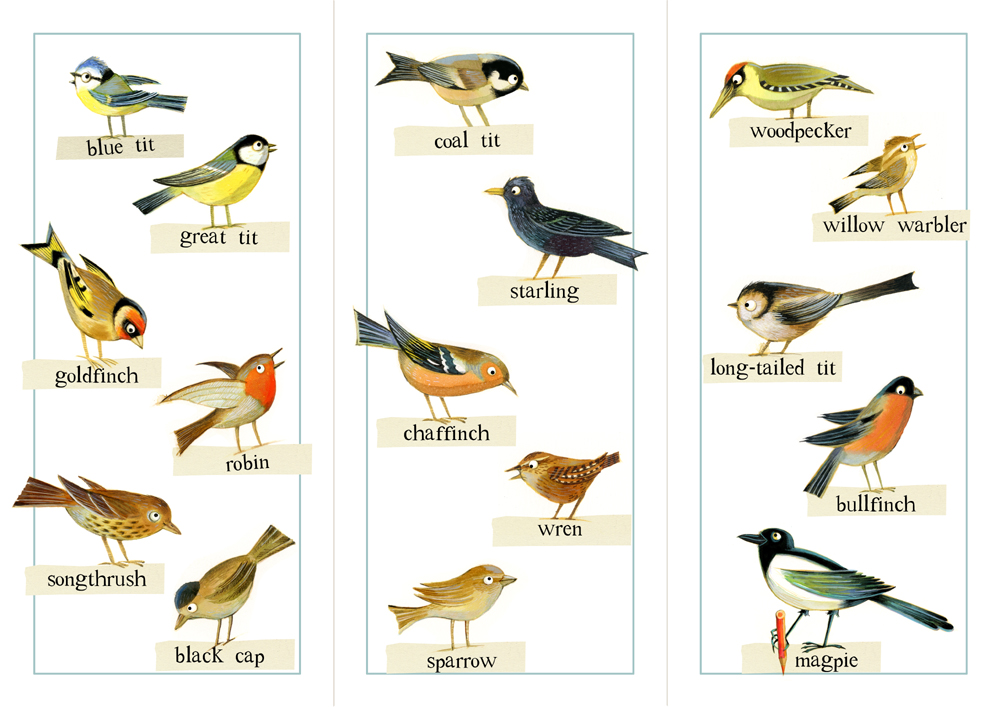
You might be feeling like making something. Here at Sketching Weakly we’ve been trying out making flying birds.
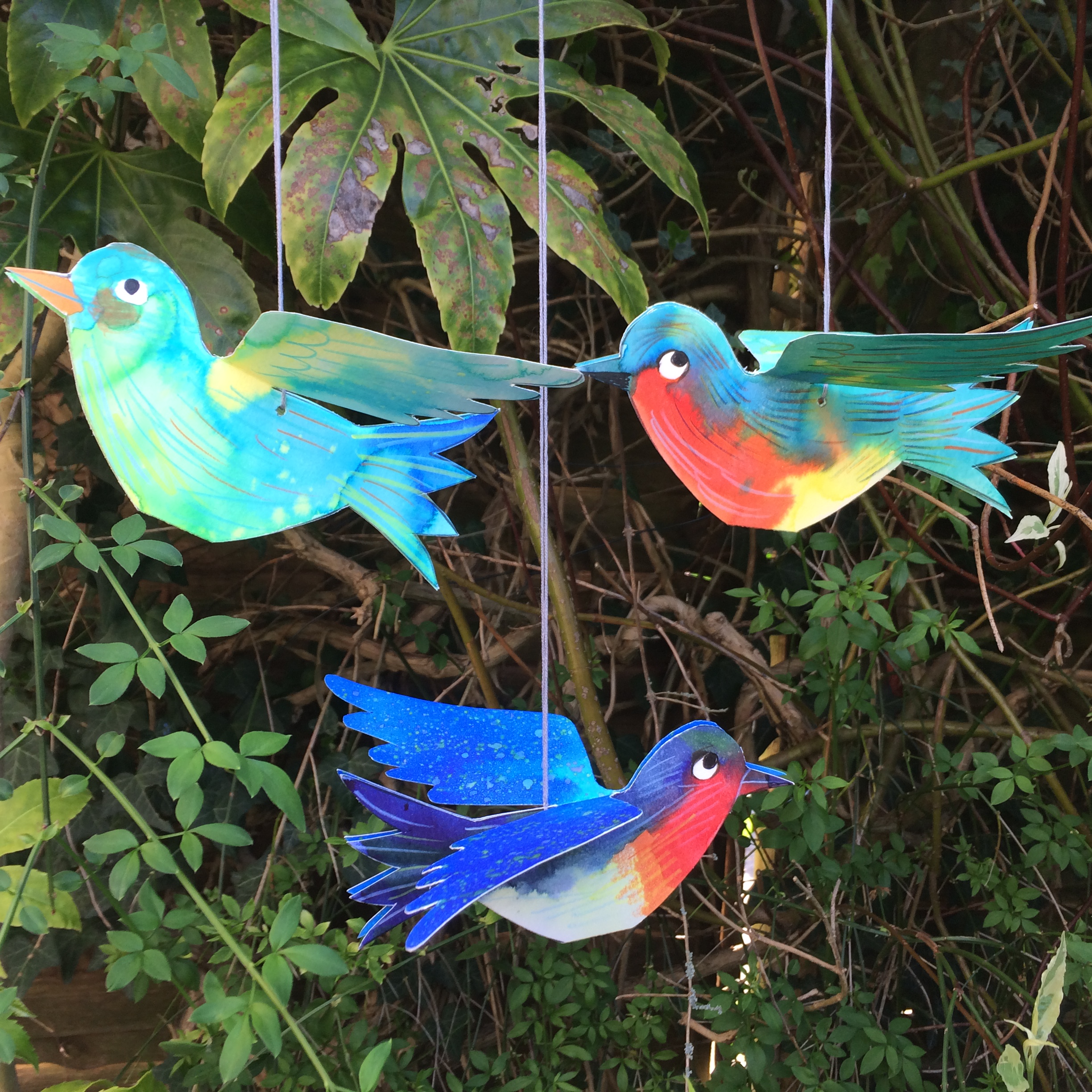

Herbie made realistic ones and Mini just made them up. Here they are being made:
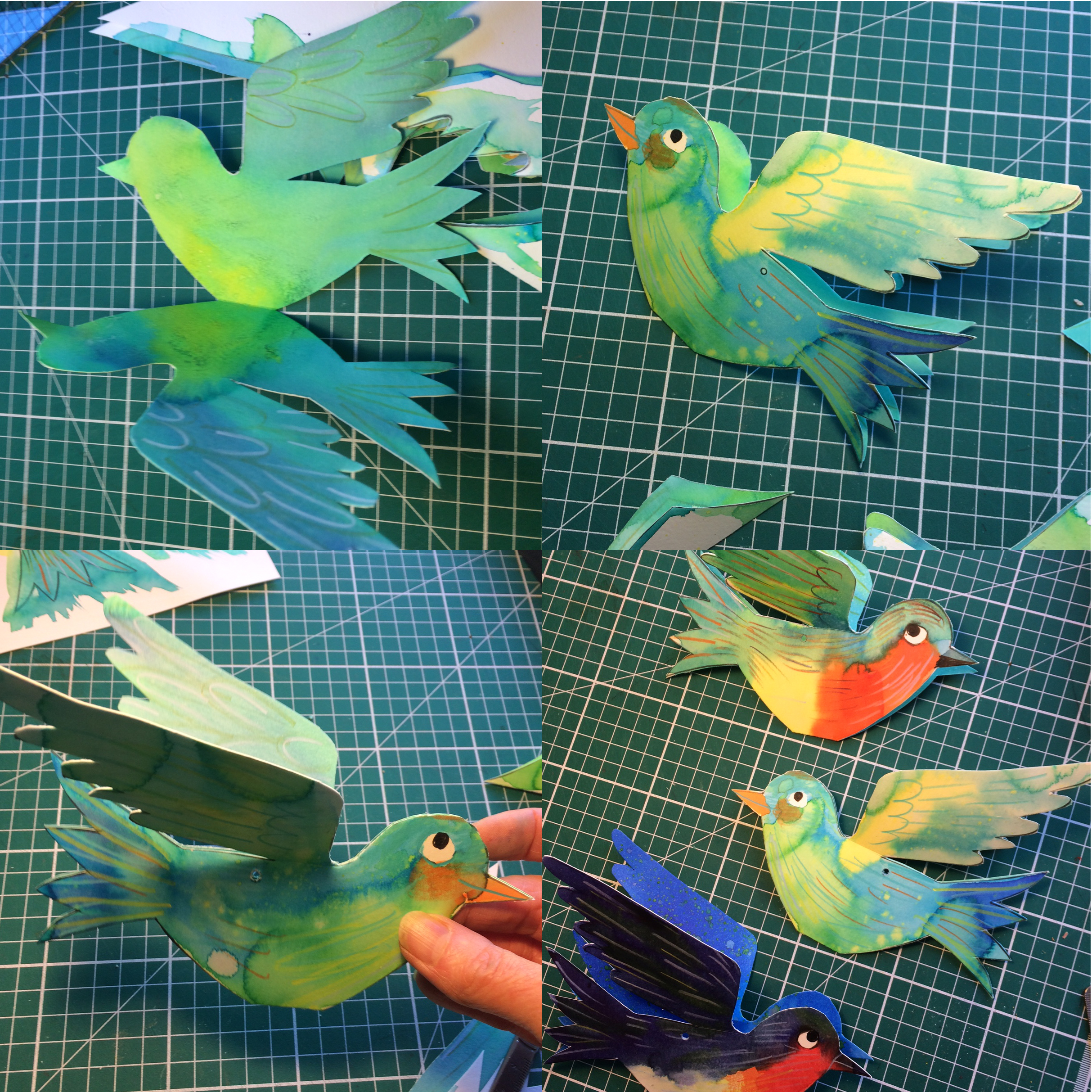
If you want to make some, here’s a pdf you can print out.
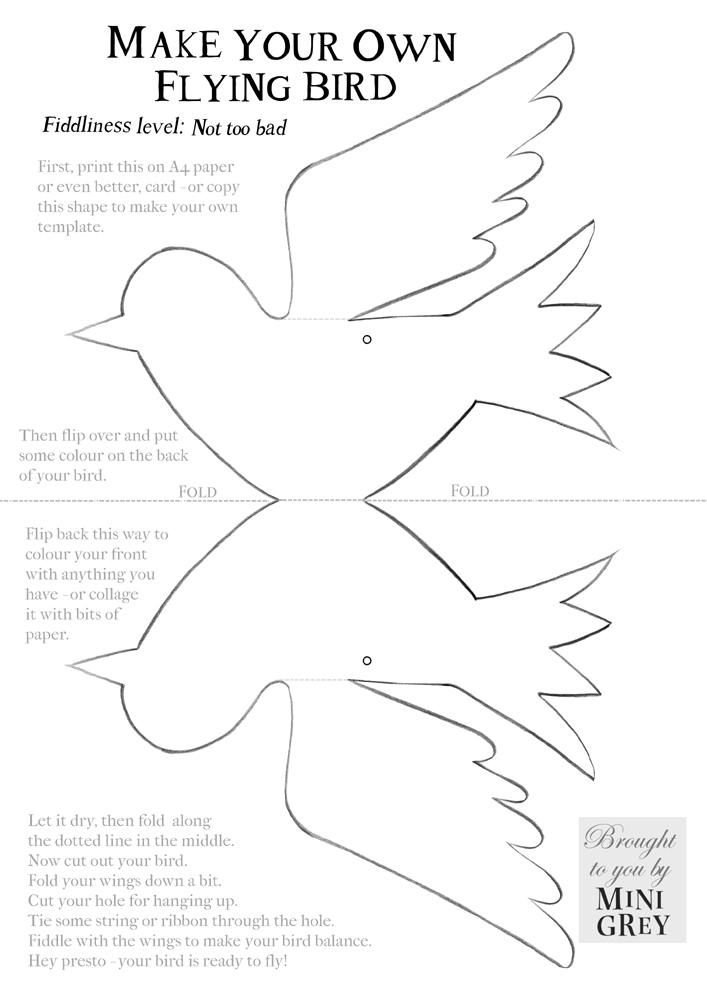
And it’s 75 years since the publication of Astrid Lindgren’s much loved book Pippi Longstocking. Mini has been doing new pictures for the paperbacks of the three Pippi books, and they’re out now.
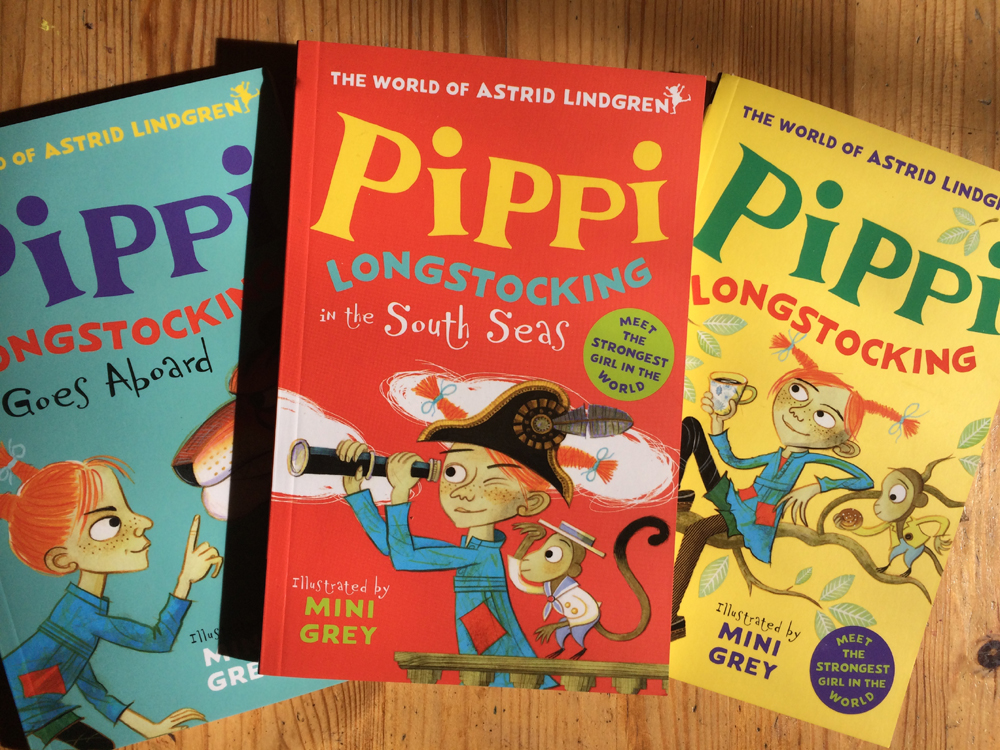
Here’s Mini’s recipe for drawing Pippi.
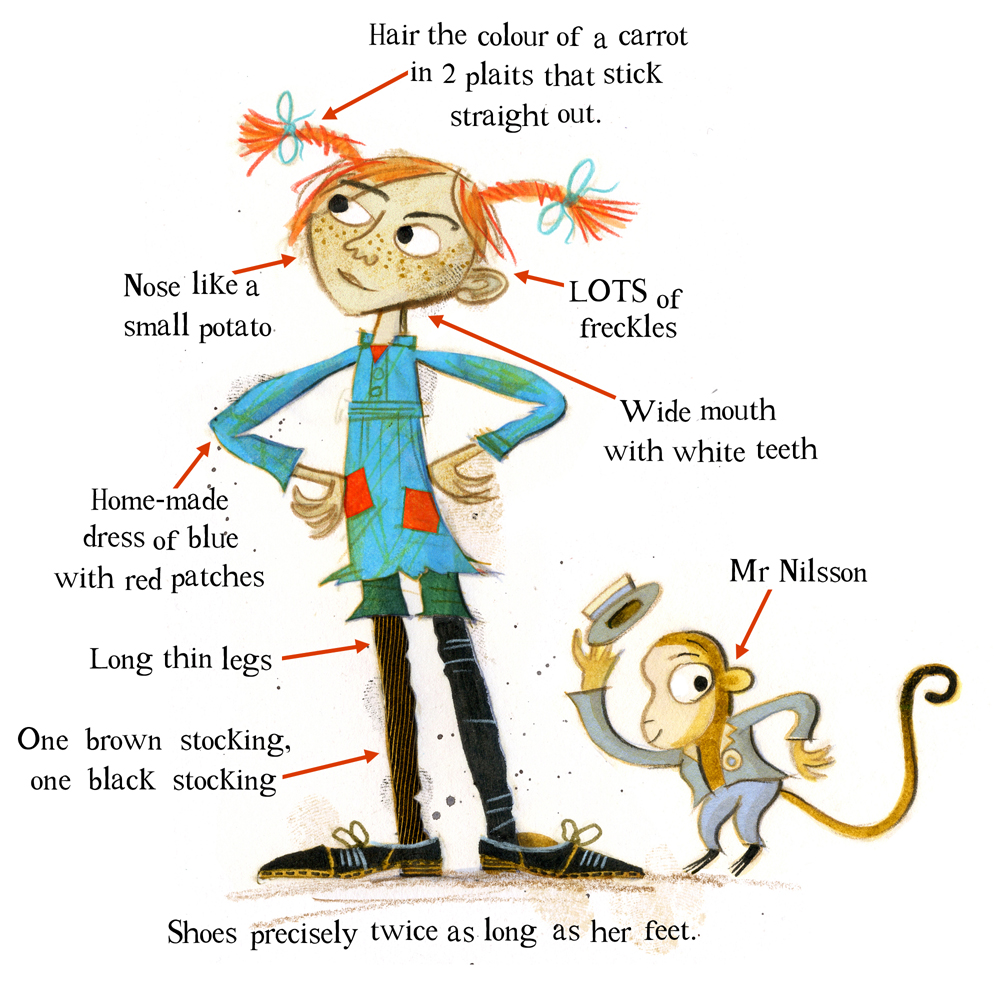
So do go and have a look at more on Sketching Weakly. You can find out about Mini’s books. You can download incredibly fiddly
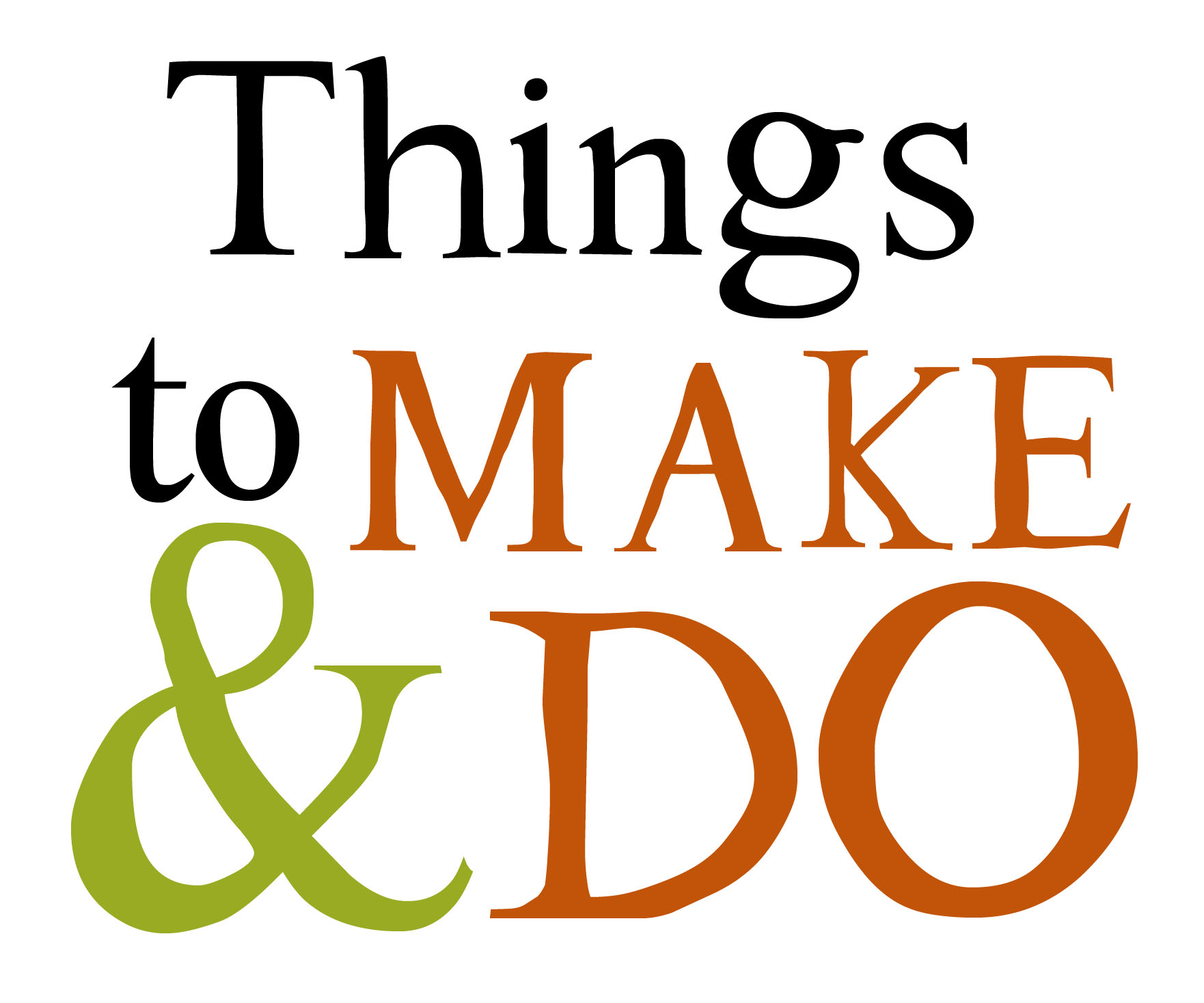
You can send Mini a message.
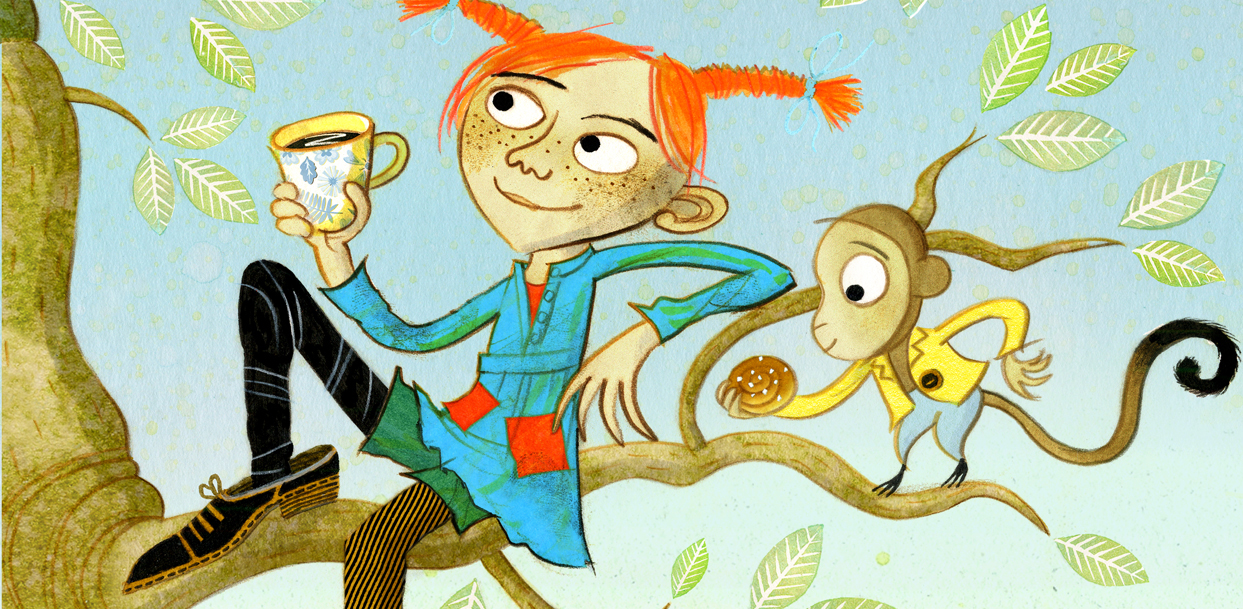
Read Mini’s post about the world of Wind in the Willows.
Read about the making of the Last Wolf.
Find out about the Perils of being a Picture Book Toy.
Are you an insect fan?
Have a look at this post about our arthropod relatives.
Are you still an insect fan? You may want to buy a framed Meet The Relatives print.
Continuing Sketching Weakly’s ongoing mission to Rule the World. This post is continuing from Less Carbon Dioxide, and If Sketching Weakly Ruled the World....
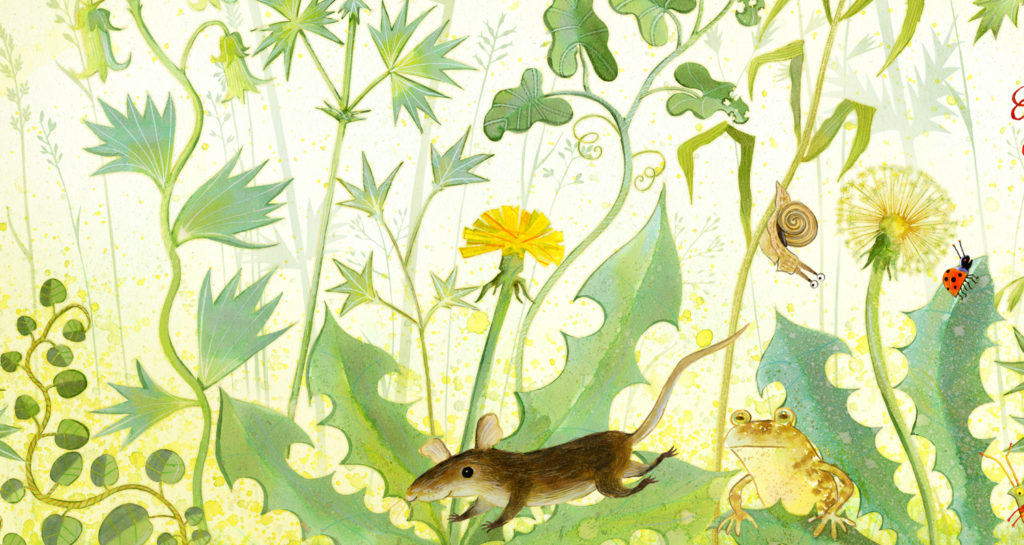
Nature is our climate crash mat. Nature, in so many ways, can help buffer the world against climate change. From forests producing rainfall and sequestering moisture to urban trees cooling and shading their local area, to flood prevention, to pollination, to minibeasts controlling pests on crops, nature can increase our climate-change resilience. And boosting nature is always a WIN-WIN – because you get the flood prevention/rainfall/shade/habitat/etc PLUS the cascades of animal life and beauty that humans love, and the resilience of having more biodiversity to adapt to a changing world..
Climate change is going to hit nature – there will be moving temperature zones, changing habitats – so if animals can’t move, they’ll die out in that area. So we need connected habitat everywhere for our nature to move around to where it needs to be.
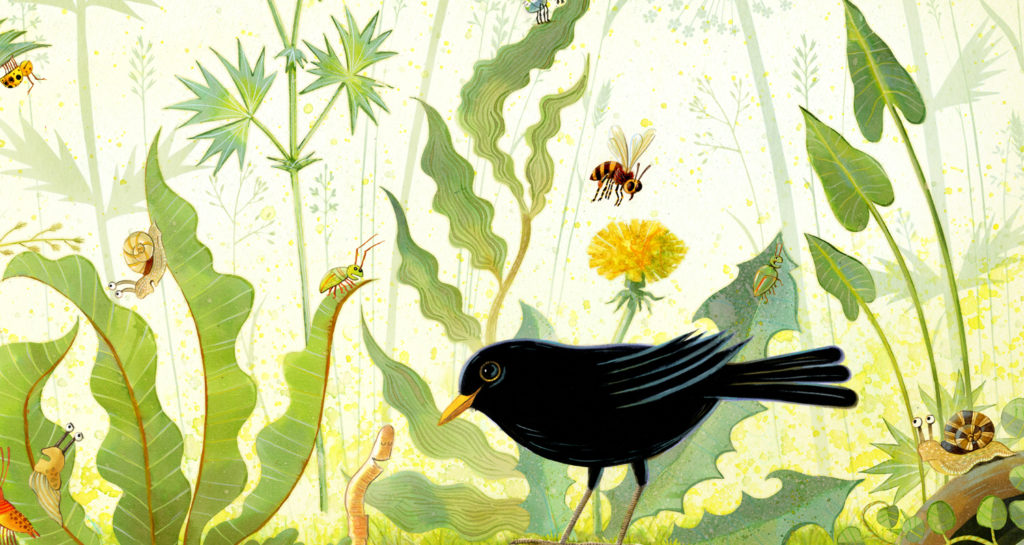
Our relationship with nature has changed. Back in 1532 Henry VIII’s Preservation of Grain Act made it compulsory for every man, woman and child to kill as many creatures as possible that appeared on an official list of ‘vermin’. Virtually all wild animals were on the list: otters, beavers, hedgehogs – even kingfishers. That kind of wildlife massacre would be unthinkable now.
So why does nature still get wallopped?
The main culprits are generally agricultural practices and land-use change. Wild habitat gets converted into farmland. And intensive farming practices leave no space for wild habitat. Roads fragment habitat. Housing developments often feature more car parking space than habitat.
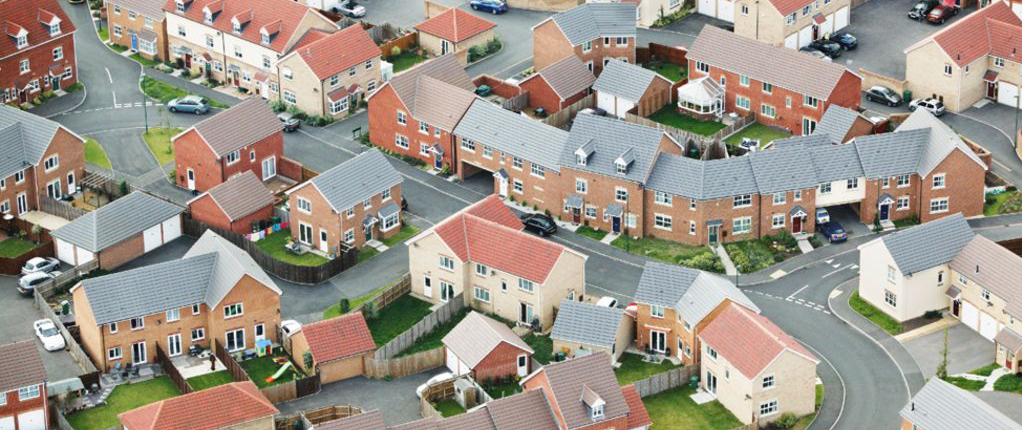
I’d suggest three changes to help create more space for nature. These changes all involve
A National Planning Policy Framework that puts habitat-protection and creation at the heart of planning developments.
An Agriculture Bill that fosters farming practicies that are wildlife-friendly.
A Packaging Revolution that makes it easy to buy products that have been produced in a biodiversity-friendly way.
1. The National Planning Policy Framework: the way we build things
At present, the National Planning Policy Framework (NPPF) has, at its heart,“a presumption in favour of sustainable development, which should be seen as a golden thread running through both plan making and decision taking.” But sustainable development is a slippery concept; in my opinion development is ‘sustainable’ if it can continue for ever at that level with no loss of biodiversity. But if you are gradually increasing the amount of built over land – the end result must be gradual loss of nature. I’d propose a change of emphasis, from a golden thread to a green thread: I propose we build for biodiversity: we put nature at the heart of planning. Established habitat should have extremely high value; destroying ancient woodland and green belt land should be an unthinkably expensive thing to do. We should plan for as little tarmac as possible – cars can be parked on all sorts of surfaces. Developments should conserve established habitat and build around established trees and hedgerows. After all, somebody already lives there. Green belt land should not be converted into built developments: green belt land is exactly the kind of green space most treasured by people as it is close to where settlements of people live. It’s not ours to nibble away at and pave over – it is our gift to future people so they can live close to nature too. It’s ever-tempting to develop green belt land because it’s cheap to convert and will be the type of place that people will like to live – but that takes something we all share and converts it into a one-off profit that is now out of the shared commons – so it is a robbery from all of us and from people of the future.
The present NPPF requires that councils set aside land for building new housing upon for the next 5 years. This just isn’t sustainable UNLESS the land set aside is land that has been built upon already. We need to become the first animal ever to voluntarily limit our own effects on the world, and tread more lightly and imaginatively on our planet.
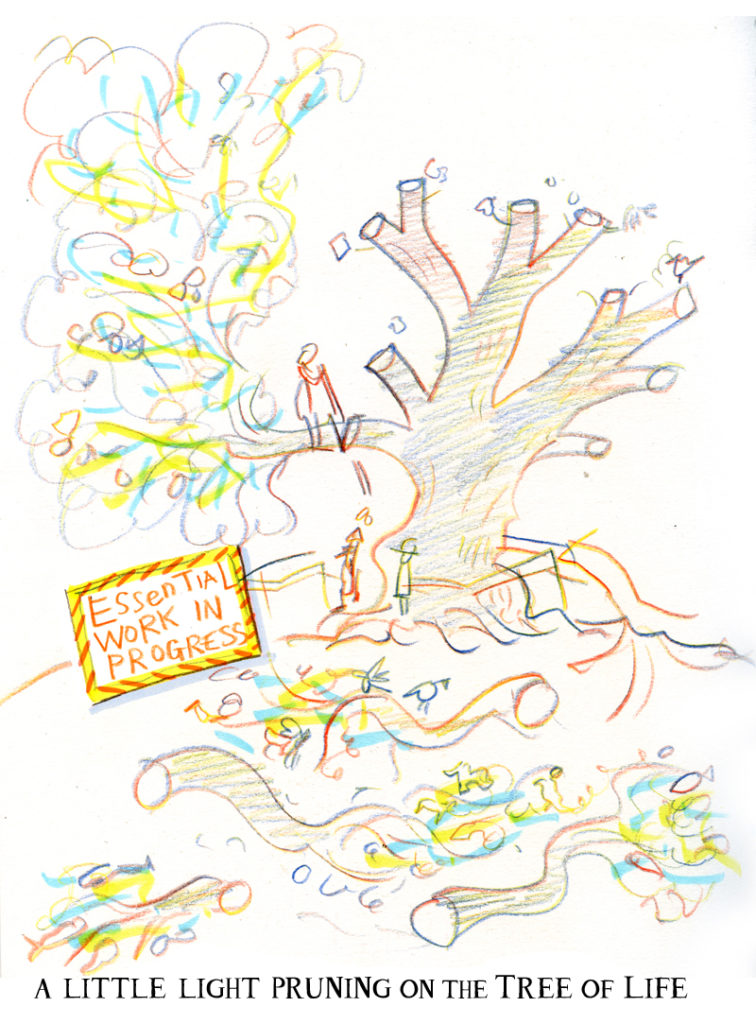
Biodiversity is our Green Infrastructure – it can buffer us egainst extremes of flooding and heat. It is so valuable, but it’s not factored properly into economic decisions – it’s a classic market failure situation. To address this – we need legislation. So I would propose a NPPF with boosting biodiversity at its heart, with a mandate to measure biodiversity and land-use change.

2. The Agriculture Bill: the way we farm animals
Some things happen because it’s free to do them. There are some ways of farming that are absolute planet wreckers. Here are some:
Intensive animal farming: if we saw it we wouldn’t like it. It’s only allowed to happen because it’s invisible. Animals are kept indoors or on feed lots in huge numbers, living miserable lives. These type of industrial ‘farms’ are called Concentrated Animal Feeding Operations, or CAFOs. And they’re not just in other countries: we have them in the UK. These animals are fed planet-wrecking foodstuff like soy grown on deforested land. The animal density makes them a hotspot for disease and the overuse of antibiotics. They’re unpleasant to live near to, and generate huge quantities of animal sewage which has to go somewhere. This is total madness, and just plain cruel. And it’s so we can have cheap food. But this cheap meat has a massive real price-tag in animal suffering, disease and destruction of habitat. I’d include trawling and other intensive fishing practices in this destructive intensive farming group, as well as fish-farming of predator fish like salmon.
We can’t afford to farming these ways any more, it’s time to move to properly sustainable farming practices.
We can can make UK agriculture a model for planet-friedly farming to be really proud of – farmers are already trying to do this, and the UK landscape is incredibly suitable to animal-friendly farming.
So what do we want more of?

Things like:
In the sea: the marine farming of kelp, mussels and oysters that creates habitat for other sea live to thrive.
Farming with biodiversity as its friend, leaving field margins wild and leaving some waste around to feed farmland birds; using natural predators to help control unwanted pests, farming to boost soil health, farming animals where they can live a natural life in the landscape, allowing trees to grow to boost biodiversity and help manage water in the landscape.
Farmers often try to do these things anyway – but they also often have to compete on a level playing field with others who farm intensively to produce food more cheaply.
There’s a new Agriculture Bill travelling through parliament at the moment. Our new agriculture bill needs to reward farming for biodiversity and reward growing our green infrastructure to be our climate change crash mat – and it looks like it broadly will do that, with a ‘payment for public goods’ ethos rather than the EU CAP payment by quantity of land held. But we also have to use the same standards to measure farmed imports that enter our country too, or UK farming will be fatally undermined.

And we can reward nature-friendly farming practices another way at the same time by making it easy to buy planet-friendly products, with….
3. A Packaging Revolution: make ethical buying choices easy to do
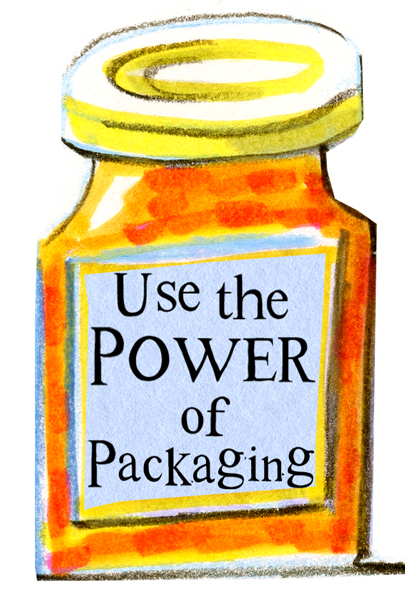
SORROW AT THE SUPERMARKET
I am a hasty impatient shopper who doesn’t have the time and diligence to check out the supply chains for all the products I buy. I want to be able to wander into a supermarket and instantly be able to choose the products that are good for the planet.
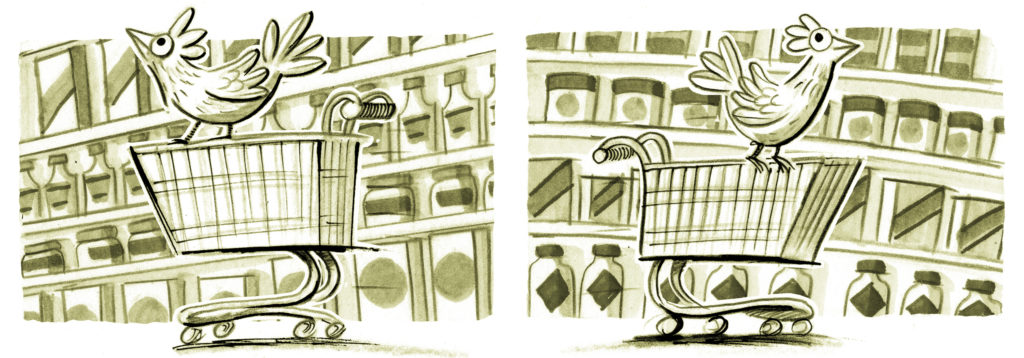
Government action stepped in and revolutionised the packaging of cigarettes. We can all agree that cigarettes are pretty bad for human health. Now cigarette packets look so grim, it’s impossible to buy them without being aware of what you’re buying into. But intensive agricultural practices are killing our planet’s biodiversity. It’s another robbery.
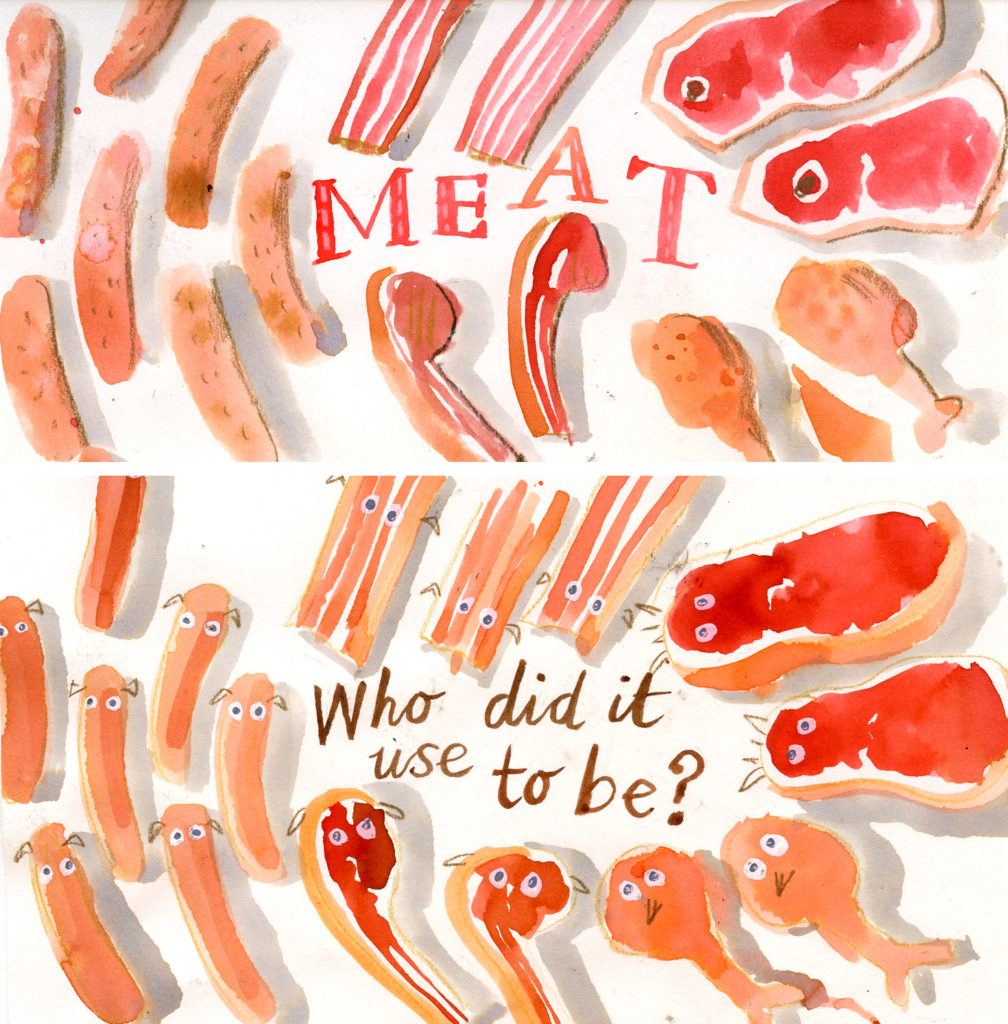
Packaging is hugely influential. There’s been an enormous success in egg-packaging: legislation to require clearly stating the conditions hens were raised in has really boosted demand for free range and barn-raised eggs.
At the moment there are certain symbols you can look for on farmed products: there’s the Soil Association mark, RSPCA-acccreditation, the Red Tractor mark and the Lion Brand symbol. The first two do ensure environmentally-friendly or animal friendly farming. The second two ensure a moderately basic amount of animal welfare and ensure the origin is British. Compassion in World Farming is calling for much more explicit animal-product packaging that really shows the conditions the animals lived in.

But the buyer still has to do a lot of fine-print reading, plus the labelling only applies to animal-products, and I want to buy into farming for biodiversity too.
What if there was a symbol – say an Ethical Earth symbol, that could be put on all packaging?
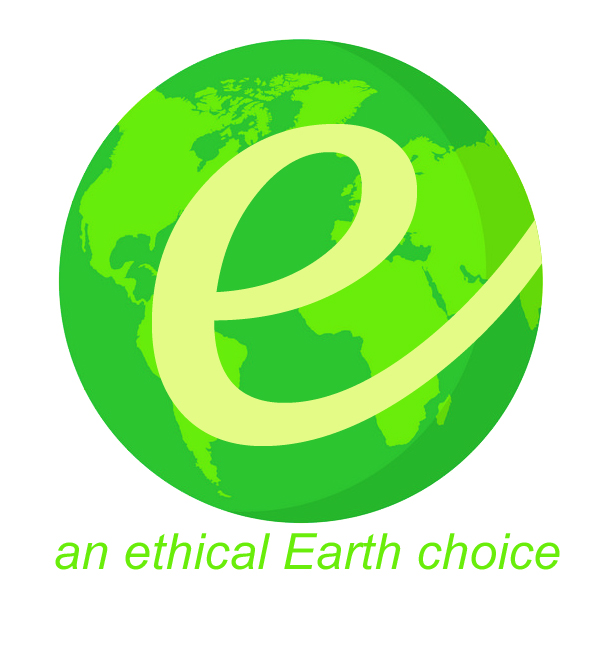
The ethical farming practices to earn the Ethical Earth Symbol would need to be agreed upon by a panel which would need to be unpartisan and have the interests of the planet and its future at heart, and also the interests of the animals farmed. Practices might include: nature-friendly farming with biodiversity as its friend; farming where animals live in a natural way in a natural habitat; farming that boosts biodiversity and creates more habitats on land and at sea. Achieving organic status is very difficult; Ethical Earth status could be less ‘all or nothing’, it could be more ‘every little helps’, with a broad menu of biodiversity friendly farming practices to choose from that would add to gaining Ethical Earth status, without having to tick every box.
And just as importantly, there have to be certain farming practices that disqualify you from achieving the Ethical Earth symbol. These would have to be agreed, but I’d suggest: animals stocking densities beyond a certain level, animals living in conditions where they are unable to express their natural behaviour, animals fed on products that have caused deforestation.

So, if you farm in a nature-friendly way, that boosts habitat and biodiversity, and is not cruel to animals, I should be able to see that easily on your product on the supermarket shelves, and I might be prepare to pay more for it. Cheap food is often just food where the costs have been passed on to everyone and people of the future in degradation. This is possible because packaging hides the truth about where the food came from.
There’s amazing amounts of data available nowadays – it’s possible to track individual animals through supply chains; this could help in the earning of an Ethical Earth symbol. At the same time, to push change harder, there could be an Unethical Earth hazard symbol that you have to put on your packet if you haven’t achieved an Ethical Earth standard. It ought to be possible to request Ethical Earth-rated products only when you do your online shop. Having the Ethical Earth symbol or the symbol of not-having-achieved it could be mandatory on all food packaging, so you could buy Ethical Earth chocolate biscuits – if it’s possible to make such a thing. And that means with my buying choices I’m now supporting producers in other countries who are farming sustainably and not destroying rainforest habitat.
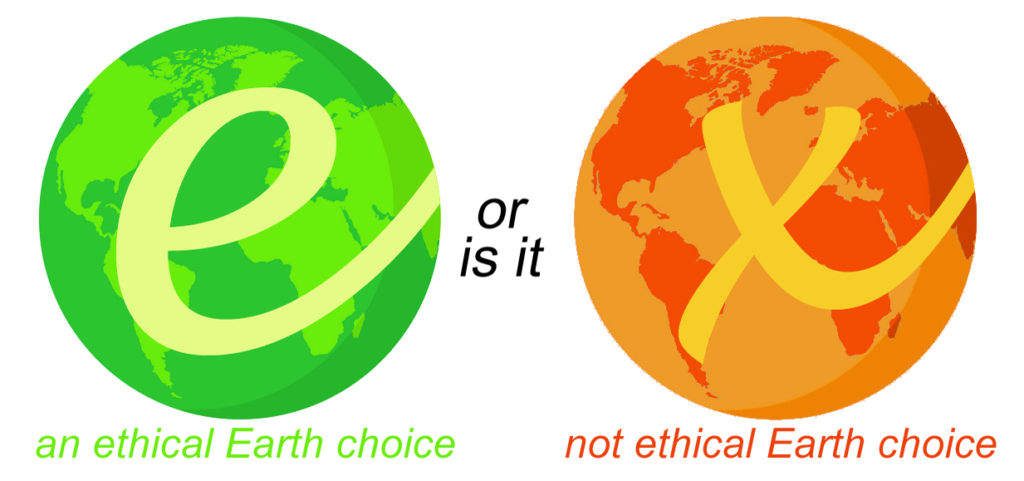
On the supermarket shelves, the world and its biodiversity is on sale. A Packaging Revolution could enable everything you buy to be a vote for what you want more of. When you choose the Ethical Earth symbol – you could be buying into a better planet.
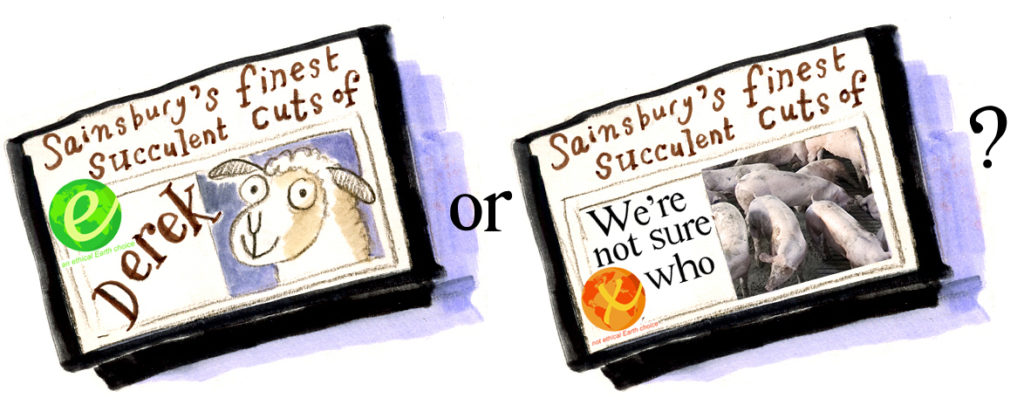
We can’t wait for all the world to agree. We have to lead by example. We have to model how to be good citizens of the Earth – by making less CO2, and do our part in protecting and boosting the nature on these islands, and making it wilder and better. It requires enlighted policy-making by a government that is acting in the interests of Biodiversity and the future inhabitants of Earth.
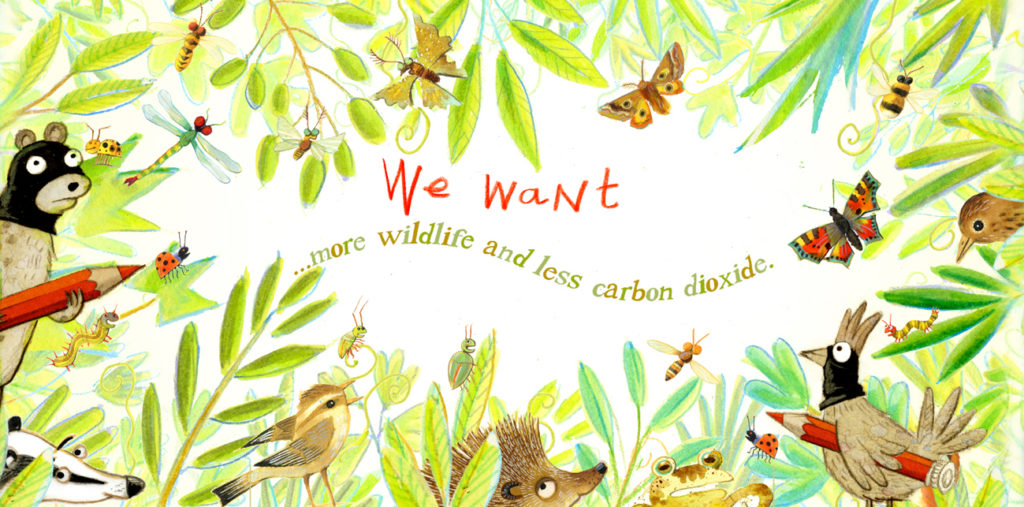
Continuing Sketching Weakly’s mission to Rule the World. This post follows on from If Sketching Weakly Ruled the World, and precedes More Nature.
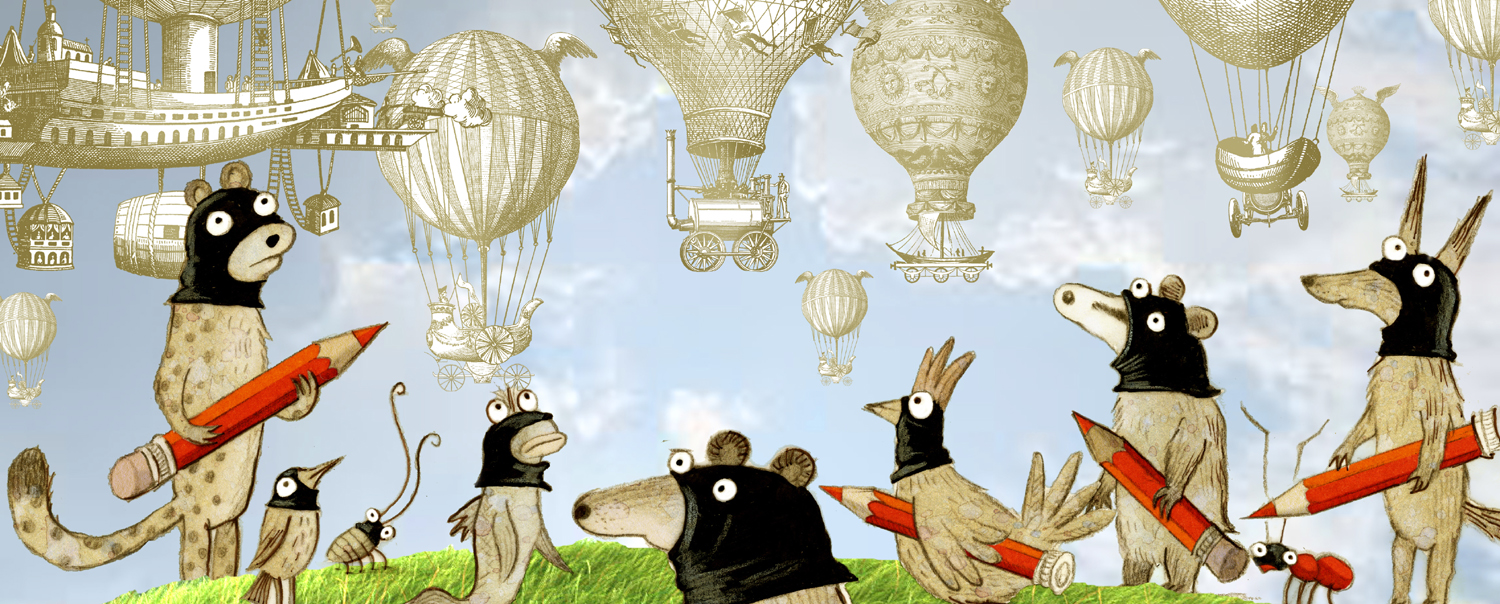
I was lucky enough to be part of the Oxford Citizen’s Assembly on Climate Change. It was an amazing and enlightening experience. Often, how to change individual behaviour seemed to be the issue, especially as the majority of emissions were coming from buildings (space heating) and travel.
How do we change behaviour? By making the desired behaviour the easiest option and/or the cheapest option, so that making the right choices is a no-brainer.
To change individual behaviour there needs to be a catalyst for change. Back in June 2007 it was OK to smoke in restaurants and pubs. That seems absolutely unthinkable today. There has been an enormous change in smoking behaviour. And that happened because on July 1st 2007 a ban on smoking in enclosed public spaces came into force by government legislation. Before it happened there was huge resistance, but from the perspective of now it was enlightened legislation that changed public health for the better. The ban was simple and clear, and after it had happened it was accepted. It is that kind of legislation we need now, to defeat our twin demons of carbon dioxide and biodiversity loss.
Pricing carbon can make change in behaviour happen. But we know a rise in prices for fuel is unpopular – see President Macron’s struggle with the Gilets Jaunes. So it seems that carbon pricing is avoided as a strategy – it’s a bit of an elephant in the room. Grand Green New Deals are proposed, but they never seem to directly tackle the issue that is essentially free to emit carbon dioxide into our shared atmosphere.
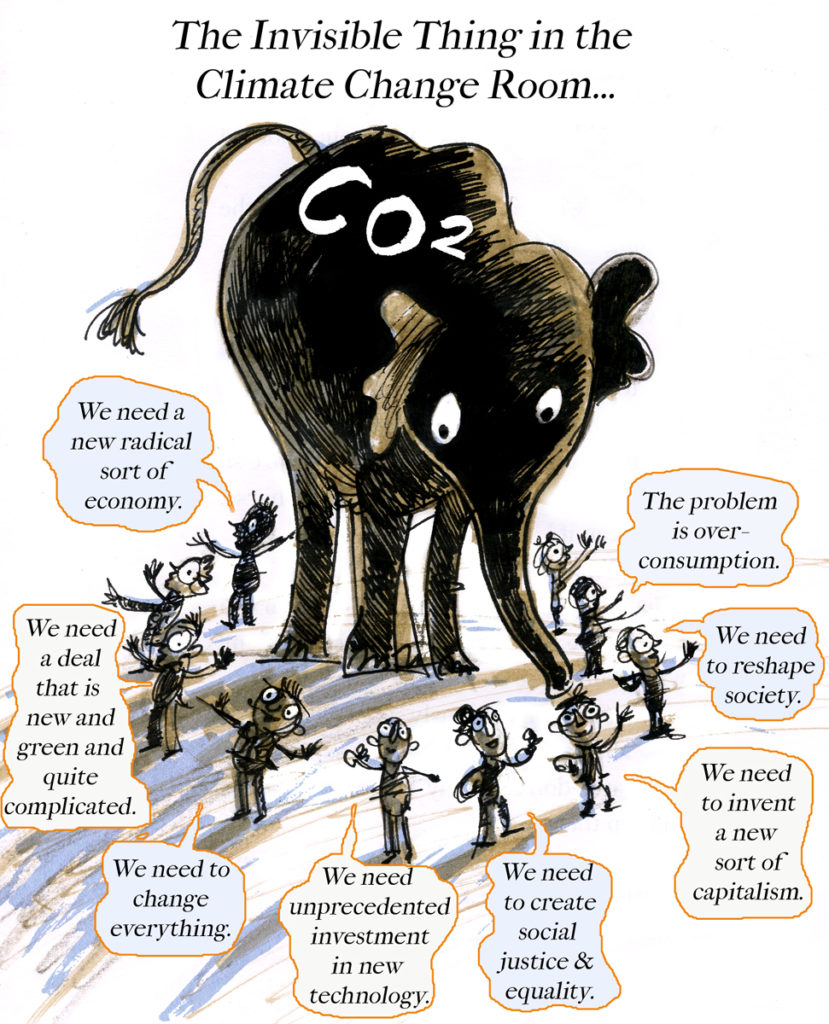
But it is possible to price carbon in a way that is fair, empowering, simple and visible.
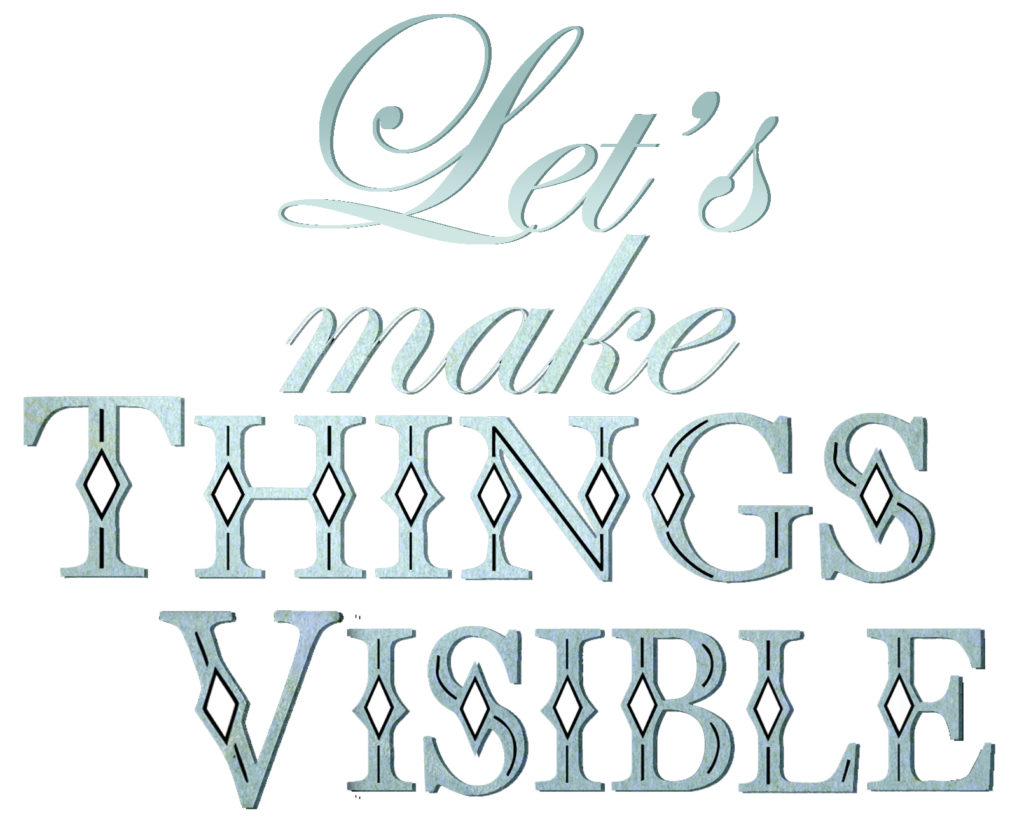
Carbon Dioxide is a difficult subject to inspire passion. Unlike plastic, it is invisible. When we emit it, we can’t see it. We can see the plastic trail that we leave, but it’s impossible to grasp what size your own carbon dioxide emissions are. But carbon dioxide is key, because the blanket of greenhouse gases is making Earth warm, melting the arctic and Antarctic and pushing temperatures worldwide out of the range of recorded history, towards a new climate that none of us or other life-forms on earth are adapted for.
But the good thing is, we CAN change this by shutting down the flood of CO2 leaking from humankind into the atmosphere.
HOW can we take action on CO2?
We can take action by putting a meaningful price on carbon, aiming towards $80-$100/tonne.
It is the nudge the world needs. A puny 5p plastic bag charge drastically reduced plastic bag use by 85%. Pricing really changes behaviour.
Our modern economy reflects countless choices, made by billions of people all over the world. A broad-based carbon price influences them all. Nothing else can.” Tim Harford
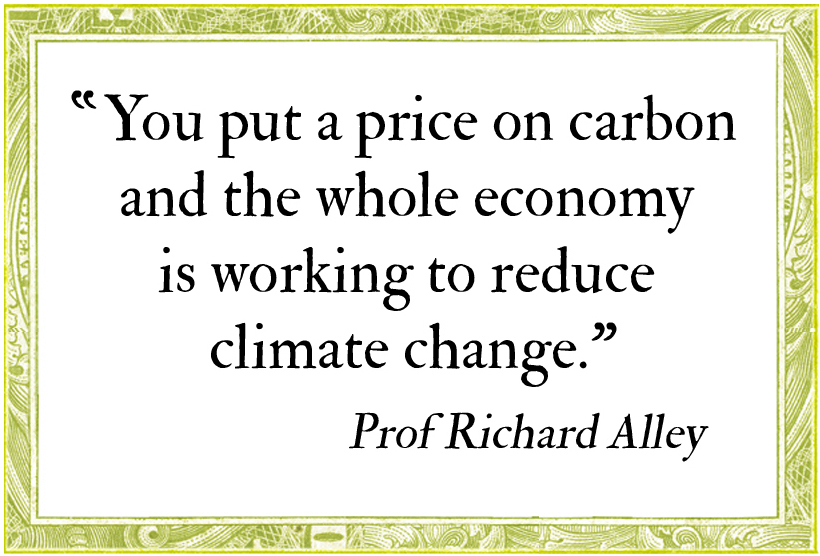
But what is the best way to price carbon?
I’ve compared different carbon pricing options. The EU Emissions Trading Scheme (which is what the UK seems to be modelling its carbon pricing system on, post-Brexit) lets the market control the carbon price (so it ends up ineffectively low) and doesn’t apply to all industries or the general public. It’s a system that is invisible and complicated.
What I’ve discovered is:
A Carbon Fee and Dividend (Climate Income) stands out as the most fair, empowering, simple, and visible way to put a significant price on Carbon.
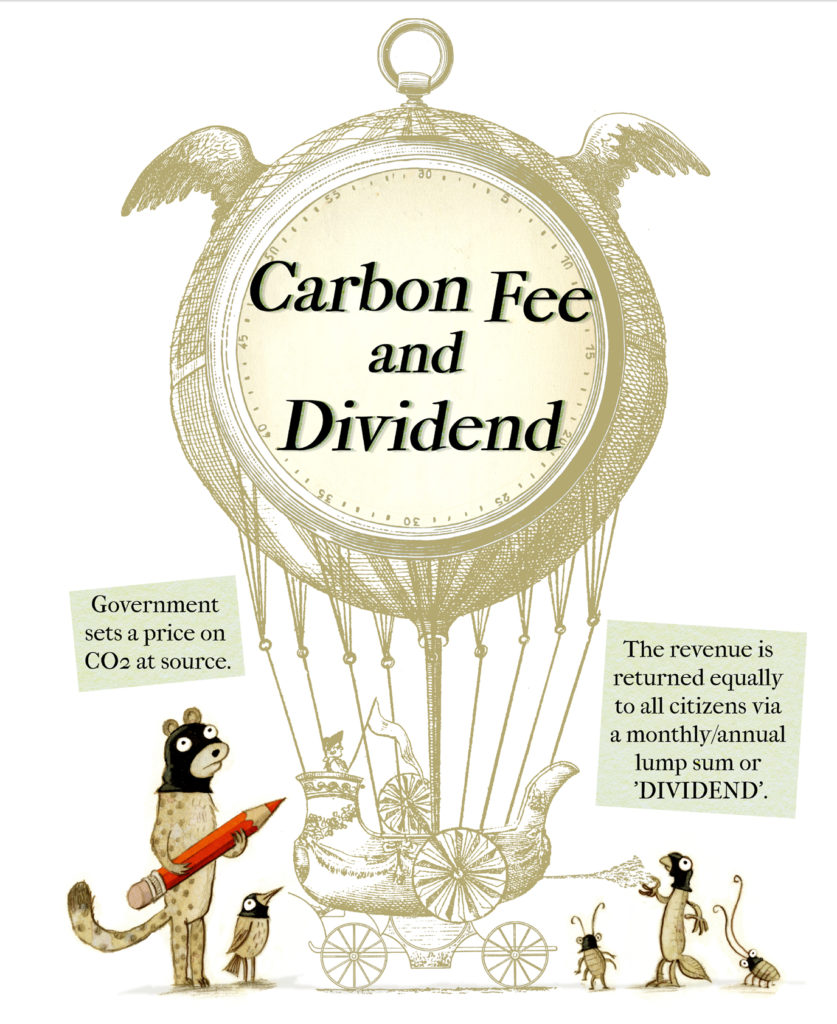
What is Carbon Fee & Dividend?
The government places a price on CO2 at source.
The revenue is returned equally to all citizens via a monthly/annual lump sum or ‘dividend’

I think it is the only way to make a carbon price that is high enough for effective change to be palatable.
There are a few good things about a carbon fee and dividend plan. Here they are.
It can appeal to people who call for social justice and want to battle inequality
The lump sum system is progressive: it really benefits lower earners most. The richest (and largest users of CO2-intensive energy) benefit least. Anders Fremstad of Colorado State University and Mark Paul of Duke University calculate that taxing a tonne of CO2 at $49 would leave 59% of Americans worse off, including 75% of the bottom half, if the revenue were used to lower personal-income taxes. By contrast, recycling the receipts as lump-sum payments (Dividends) would leave 89% of the bottom half with an average net gain of $788.
The 6 lowest income groups all break even or are better off, with the poorest getting the biggest benefits. The wealthiest, highest fuel users, are the worst off.
Compared to tax rebates, it’s demonstrably fair as all get an equal dividend.
It’s also possible to get dividends to the poorest and most marginalised sections of society, by, for example “investigating inventive ways of paying the dividend to ensure that the most vulnerable receive it. Linking the dividend to national insurance numbers would be one way to pay the dividend, but this may mean that the most vulnerable miss out. The Government should investigate whether new technology can be used to pay the dividend securely through a mobile app to ensure as many eligible people as possible receive it.” The Future of Carbon Pricing, policyexchange.org.uk
It is motivating and empowering
Through their dividend the public can support renewables in their choice of what energy to buy. The dividend is a visible sign of your purchasing power, and the public is trusted to choose how to spend it; wise choices bring a win-win virtuous spiral of energy-source-change away from fossil fuels. The dividend also gives voters an immediate interest in the fight against climate change – a lump sum arriving in your bank account is a very interesting event. All green energy sources benefit by becoming comparatively cheaper.
It sends a signal to industry that the carbon price will be a permanent policy
The Dividend, once people are used to it, is hard to withdraw by future governments (see what’s happened with UK Winter Fuel Payments) – and so acts as a pledge to industry that the carbon price will endure.
These three aspects of carbon fee and dividend mean is can appeal to: groups who want action on climate change but also social justice; the general public who will find higher fuel prices unacceptable; businesses who want a clear steer to what the carbon future will be.
Carbon is infused in all our lives and all our choices. We need to tackle climate change with a way that involves and empowers everybody, is fair and acceptable and progressive, and that also is able to set a high enough price for carbon to bring about change, in a way industry can see will not be overturned by a change of government.
Carbon Fee & Dividend: fair, empowering, simple, visible.
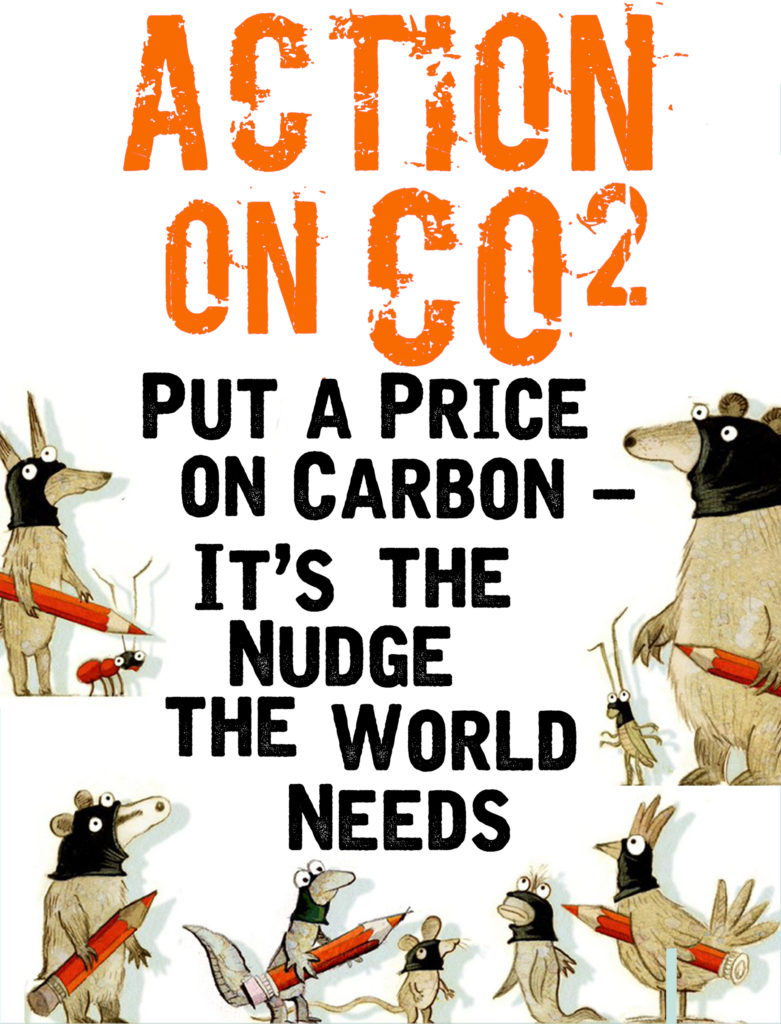
…well, it would be a disaster, wouldn’t it? But every now and then, a bit like daydreaming about what one’s Desert Island Disc choices would be, it’s nice to imagine what one would do if unwisely left in charge of things. So here are Sketching Weakly’s ruminations….
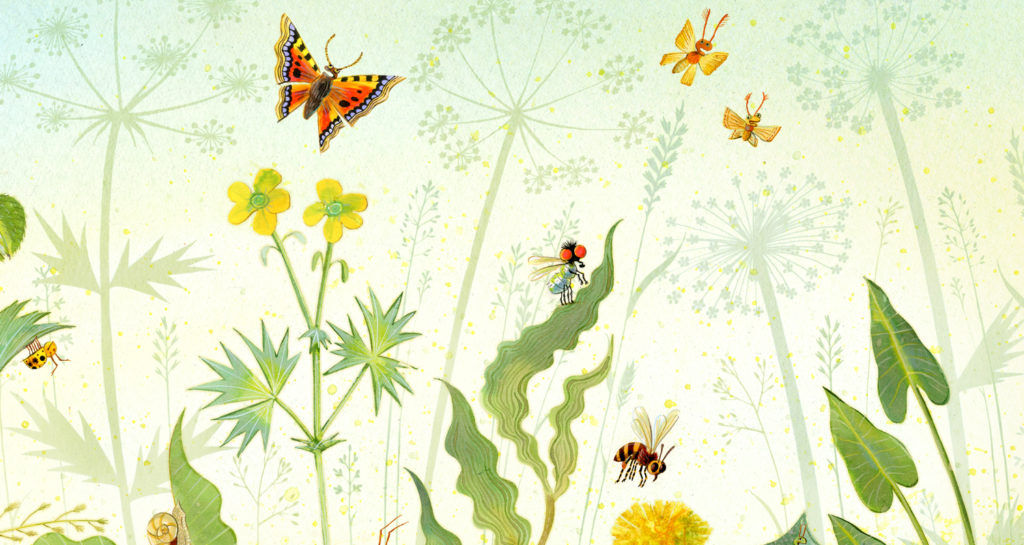
Making the visible invisible, is the usual magic trick. But making the Invisible visible, is the magic trick we need.
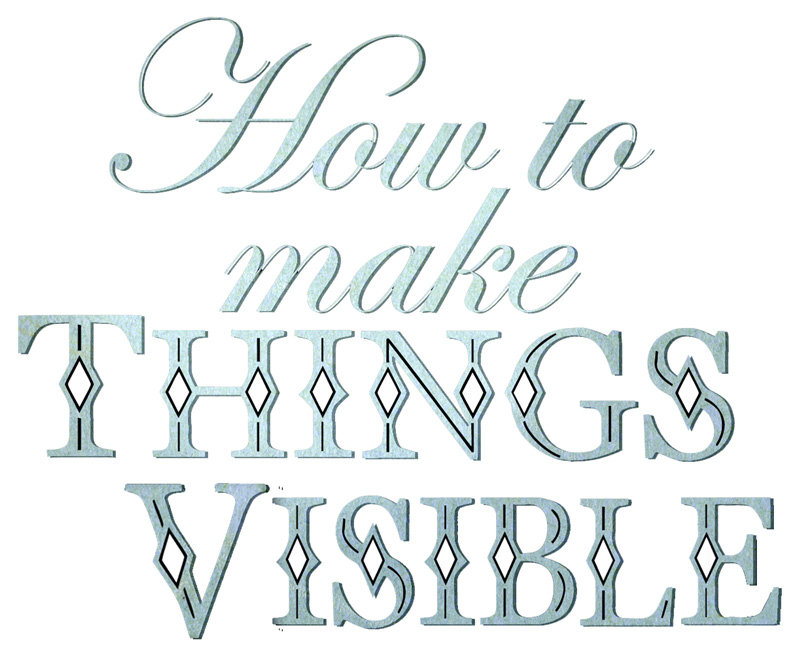
What can we learn from lockdown? What have we discovered from this strange experience of imposed isolation? To me, two things have emerged:
People will step up to a Big Ask
If people are given a clear fair rule they will follow it, accept it and be prepared to make reasonable sacrifices.
People have been willing to completely change their way of living in order to prevent the Covid19 virus rampaging through the population.
People love Nature.
To most people, nature is really important and a source of joy and wonder.
People have been treasuring their daily walks, getting to know their local patches of nature, and watching the small changes as Spring 2020 has been coming in, and transforming into Summer.
Can we use these two lessons to tackle climate change?
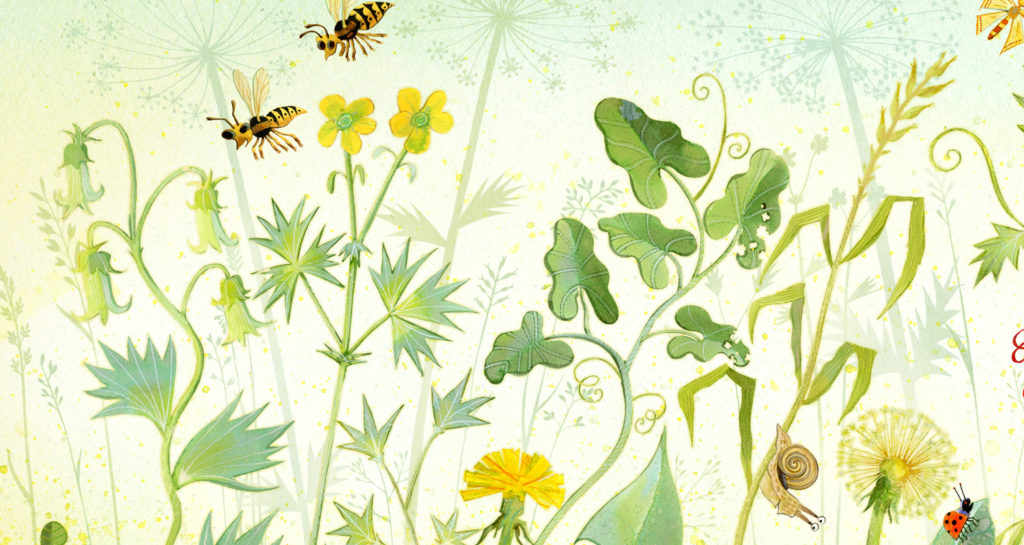
It often seems like the issues the world faces are endless, and to address the world’s problems we have to change everything. But it can help to concentrate on the two biggest existential threats to life (as we know it) on Earth. Those two threats are: loss of biodiversity, and carbon dioxide.
CO2 is invisible. When we emit it, we can’t see it. We can see the plastic trail that we leave, but it’s impossible to grasp what size your own carbon dioxide emissions are. But carbon dioxide is key, because the blanket of greenhouse gases is making the Earth warm, melting the Arctic and Antarctic and pushing temperatures worldwide out of the range of recorded history, towards a new climate that none of us or other life-forms on Earth are adapted for.
But the good thing is, we CAN change this by shutting down the flood of CO2 leaking from humankind into the atmosphere.
Action on Climate Change for me boils down to two main asks:
Less CO2 and more nature.
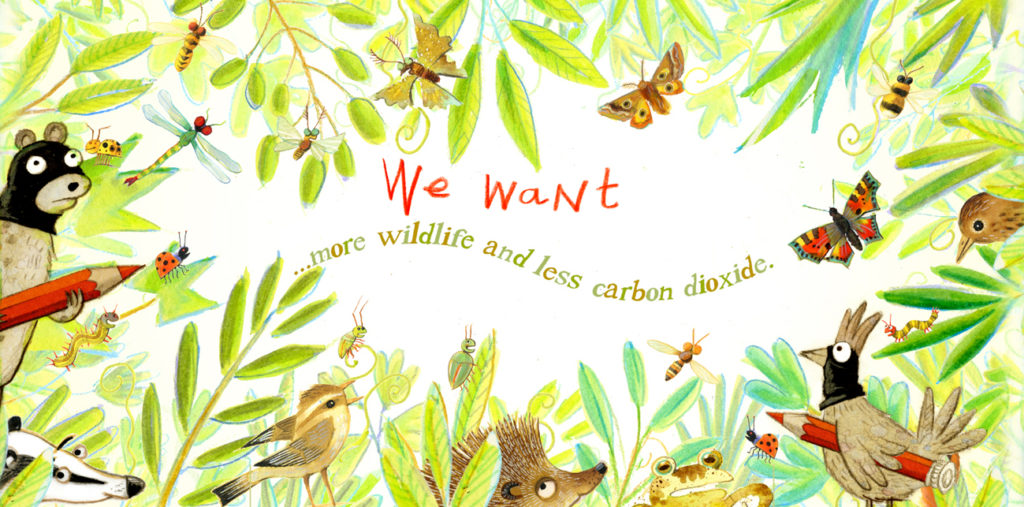
Can we use the magic trick of making the INVISIBLE VISIBLE, to make less CO2 and more nature?
Yes we can and here’s how. I’m going to do carbon dioxide first. Then I’m going to do nature. You can do them in any order you like.
WHAT DO WE WANT MORE OF? AND WHAT DO WE NEED LESS OF?
This post first appeared on Picture Book Den’s Blogspot 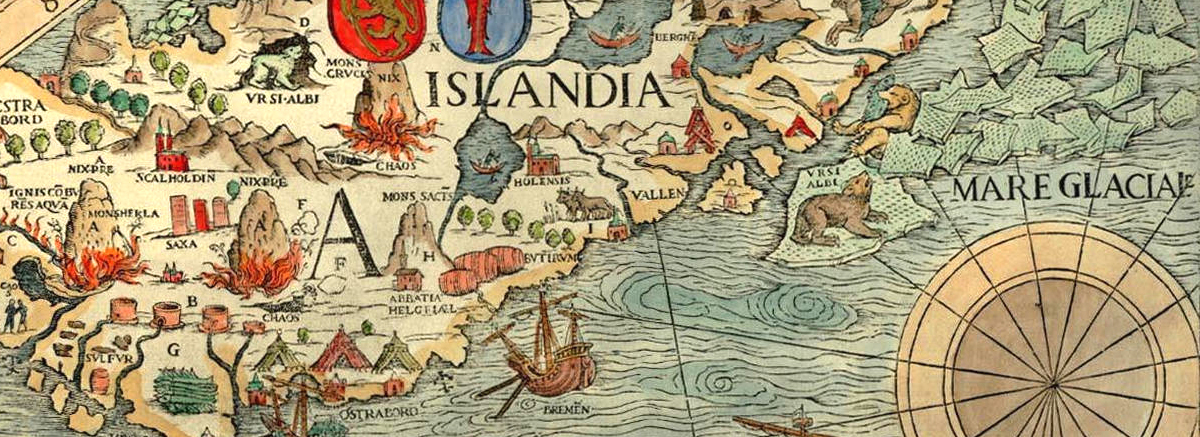 My First Maps
My First Maps
My first map-love as a child was my grandfather’s Reader’s Digest Atlas of the World. 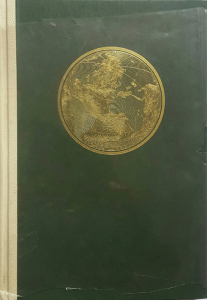 Now I own it, but I used to just visit it at my Grandpa’s house. It was really big, big enough for a small child to be lost in, and my grandpa Noel Grey had inscribed his initials NWG on all the places he had visited, prospecting for oil I suspect. Here he is at large around South America.
Now I own it, but I used to just visit it at my Grandpa’s house. It was really big, big enough for a small child to be lost in, and my grandpa Noel Grey had inscribed his initials NWG on all the places he had visited, prospecting for oil I suspect. Here he is at large around South America.
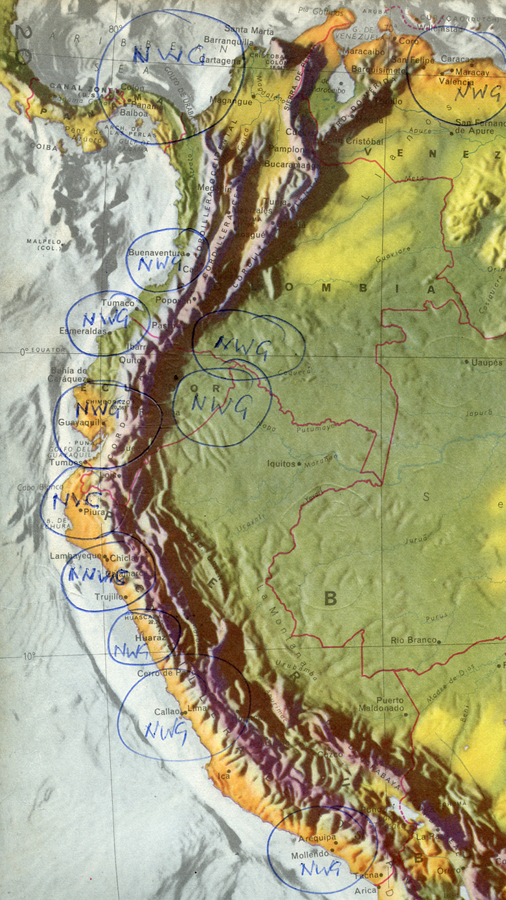
Here’s a photo he took of Ernest Hemingway with an enormous marlin – apparently they went fishing together. 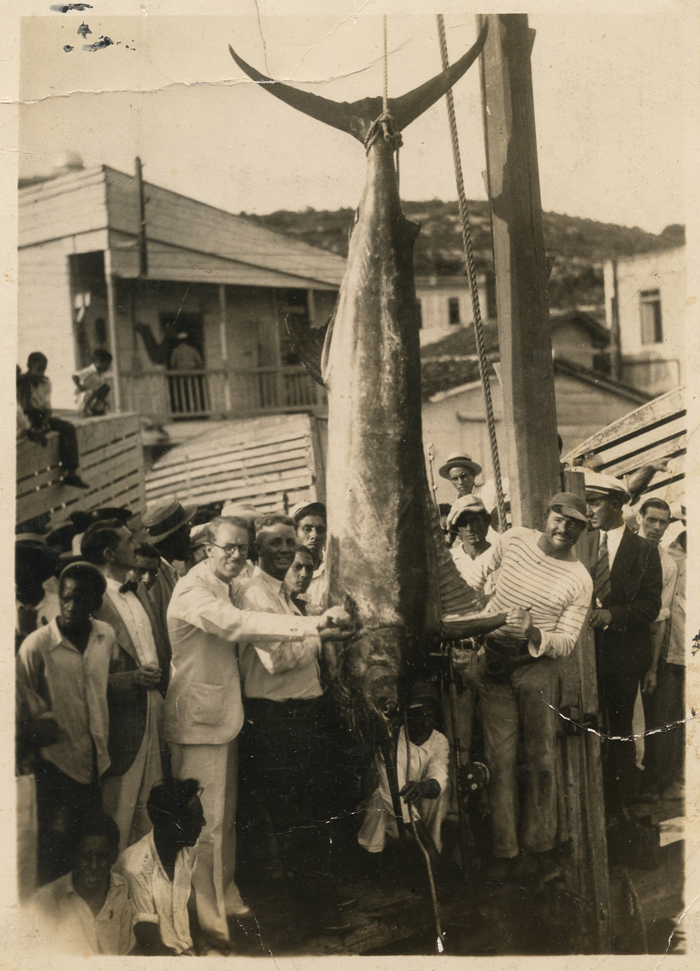 On one map he has urgently written GOLD, somewhere along the Amazon, in Peru.
On one map he has urgently written GOLD, somewhere along the Amazon, in Peru. 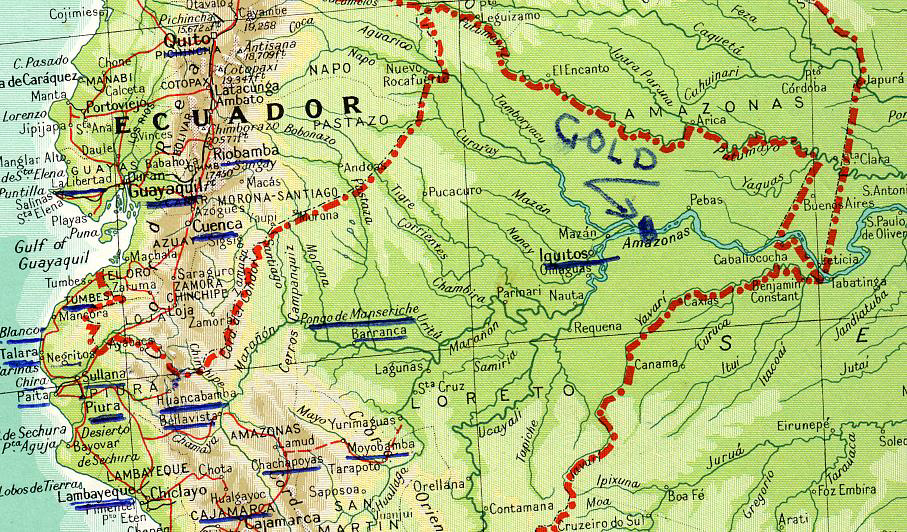
There’s a bit of a diagram too.
I started writing this post before the fires in the Amazon had beome the terrifying news they are now. From this perspective my Grandfather’s charting of ‘GOLD’ is a bit bitterly ironic; anyone with any sense now knows that the most precious treasure to be found in the Amazon is the rainforest itself
Maps of Discovery, Power and Plunder
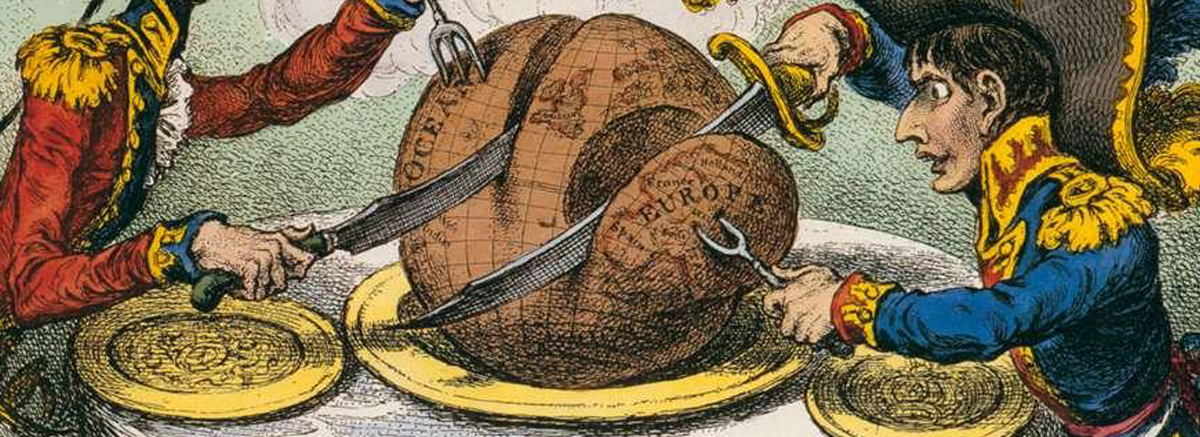
A map is a place to roam about in the imagination. A map is a record of the discovered and the undiscovered – terra incognita. A map is a plan for plundering, or a diagram of how to carve the world up, a record of ownership.
Here is the Carta marina, a wallmap of Scandinavia, by Olaus Magnus. It is the first map of the Nordic countries to give details and place names, initially published in 1539.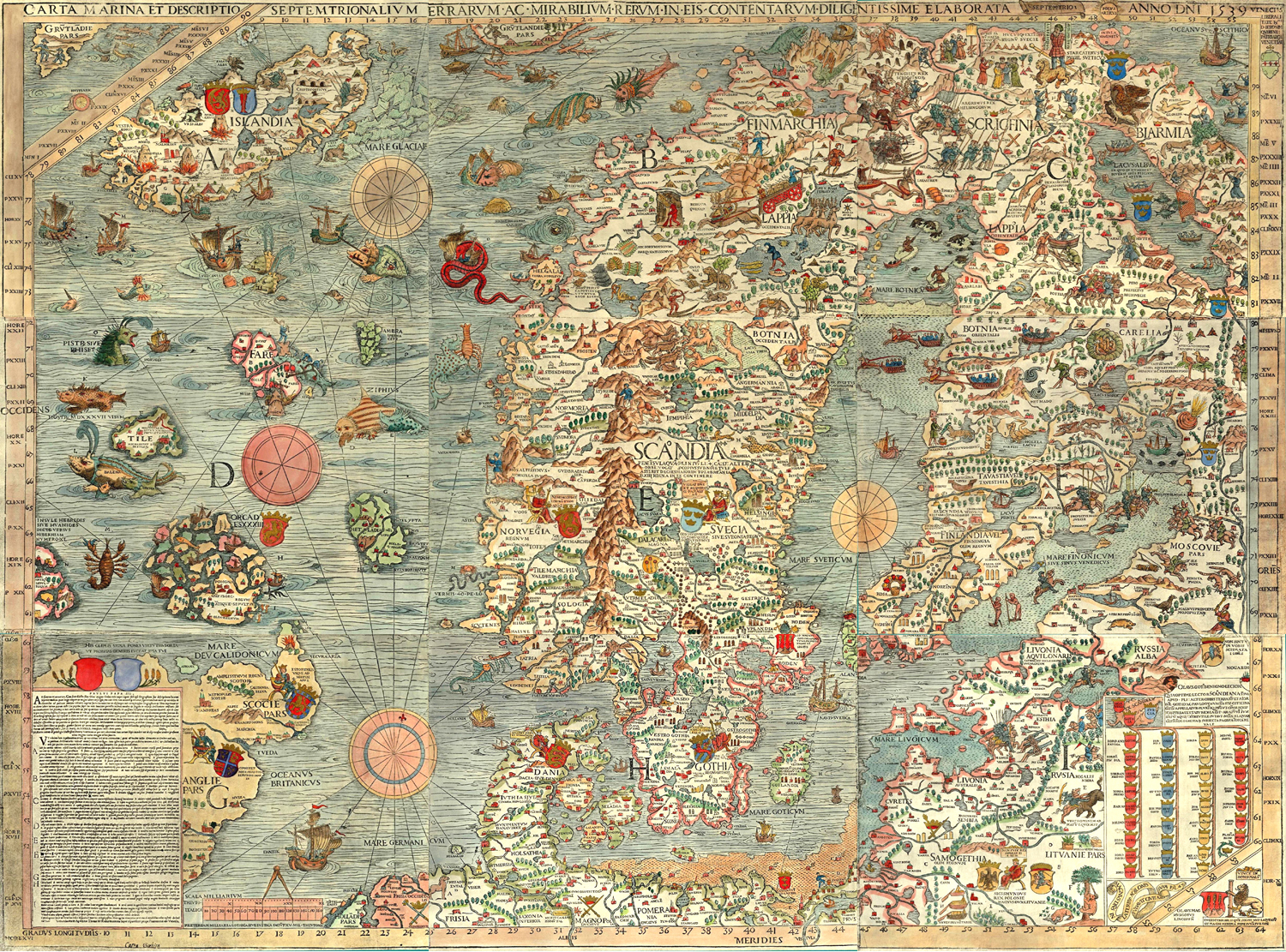
It seems to be awash with splendid mythical beasts. Did the map-maker think they were real, or was drawing the map of the far-away giving them permission to invent the most bizarre creatures they could concoct? Creatures include a literal sea-cow and sea-unicorn, whales with flowing tresses, a sea-elephant or Rosmarus and a Polypus which looks like a giant lobster. But it looks like Magnus was trying to depict what was really there – the land animals are fairly realistic, and many of the sea-creatures could be reinventions of existing ones: the sea unicorn: a narwhal, the Rosmarus: a walrus, the Polypus perhaps an octopus. Because they’re water beasts they are hard to get the measure of without diving equipment. Here are a selection of map-beasts:
You can explore the monsters here:
‘I wisely started with a map and made the story fit,’ JRR Tolkien once wrote.
In older children’s books, a map may well be the only illustration. The map is often a charting of the story journey.
When inventing the Hobbit story JRR Tolkein started with drawing Thror’s map.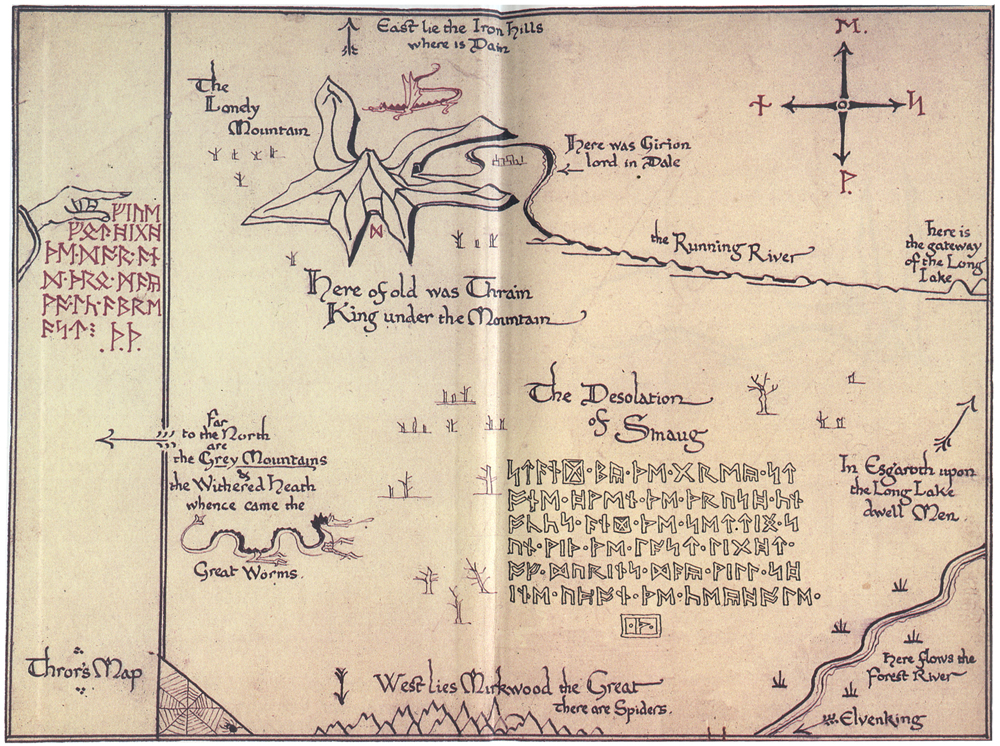
Drawing the map was part of the process of creating the story.
Here’s the map from Winnie the Pooh, drawn by Christopher Robin, with a bit of help from Ernest Shepard,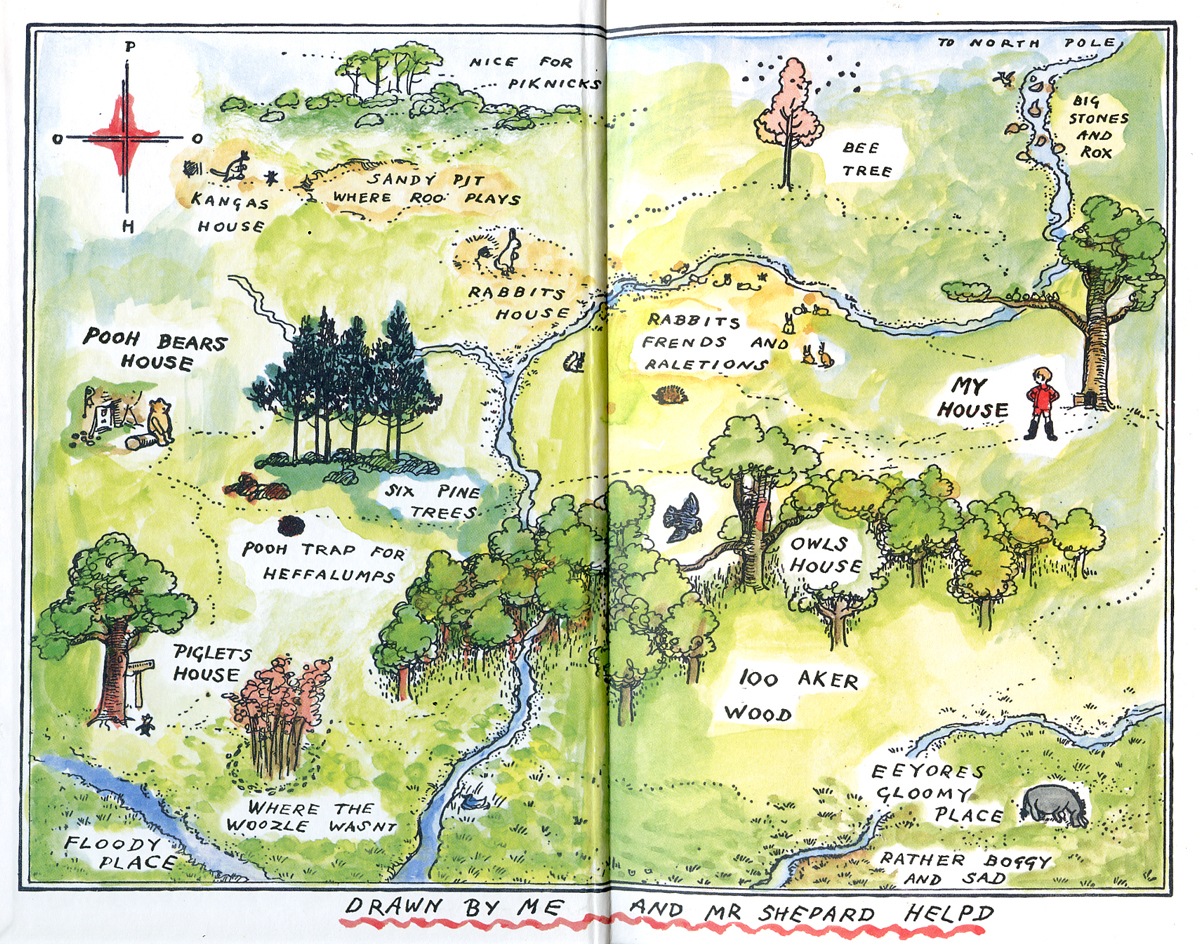
and the map from the beginning of the Narnia book of the Horse and his Boy, mostly desert (by Pauline Baynes.)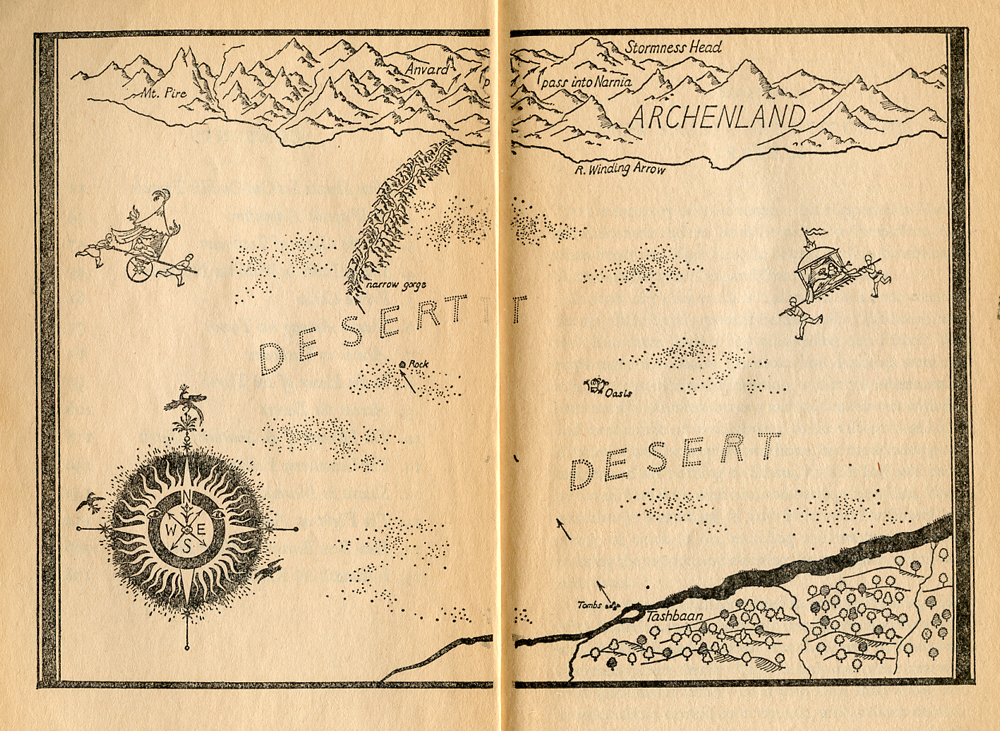
As it was sometimes the only picture in the book I would return to the map again and again, and trace my protagonist’s journey and mull over the places on the way.
And maps lend a touch of reality – a promise that the story may take you to real places.
When Gulliver’s Travels by Jonathan Swift was published in 1726 it was a roaring success but some did not realise it was fantasy.
“It is full of improbable lies, and, for my part, I hardly believe a word of it” exclaimed an eminent bishop. The Duchess of Marlborough was said to be ‘in raptures at it; she says she can dream of nothing else since she read it.’ A tale circulated about one old gentleman who, after reading the book, was alleged to have gone immediately to his atlas to search for Lilliput.
Here’s my map for Money Go Round by Roger McGough – as this book is deep in Wind in the Willows territory I had to start with communing with EH Shepard’s Willows map.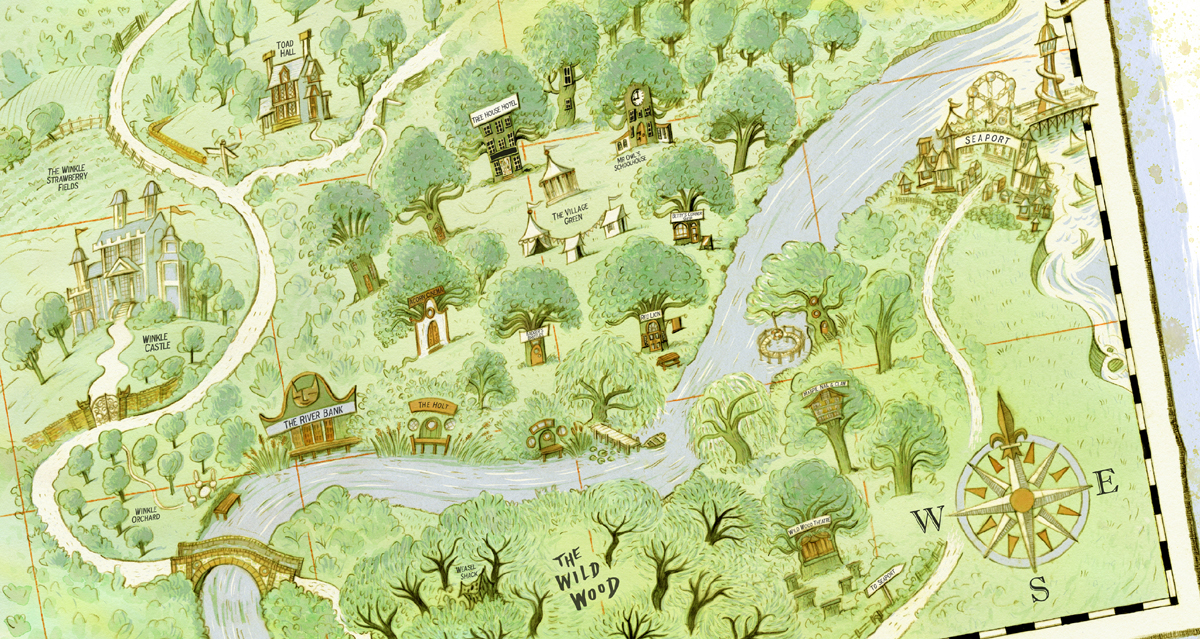
Picture Book Story Maps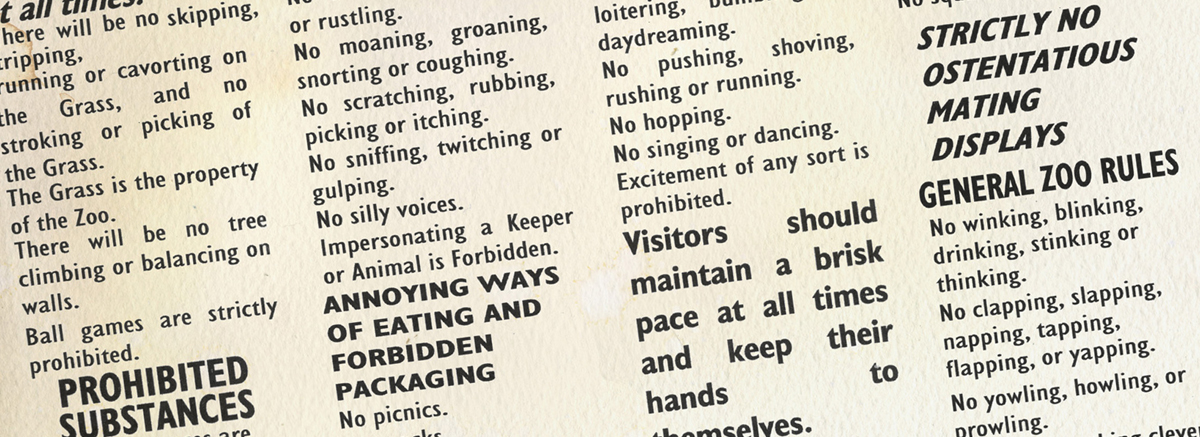
Moving to more picture book territory, a map can be a journey or a map of characters or events.
Here’s Dixie O’Day’s Map from Dixie O’Day in the Fast Lane by Shirley Hughes and Clara Vulliamy.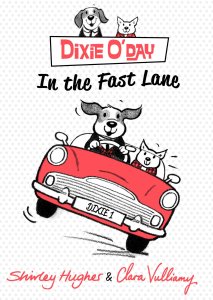
It is used by Dixie in the story and we can find where every event happens in an extremely satisfying way
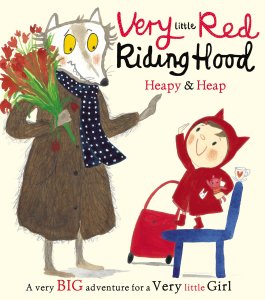 .From a map of events to a map of characters: here is the map from Very Little Red Riding Hood by Teresa Heapy and Sue Heap – the places are the people.
.From a map of events to a map of characters: here is the map from Very Little Red Riding Hood by Teresa Heapy and Sue Heap – the places are the people.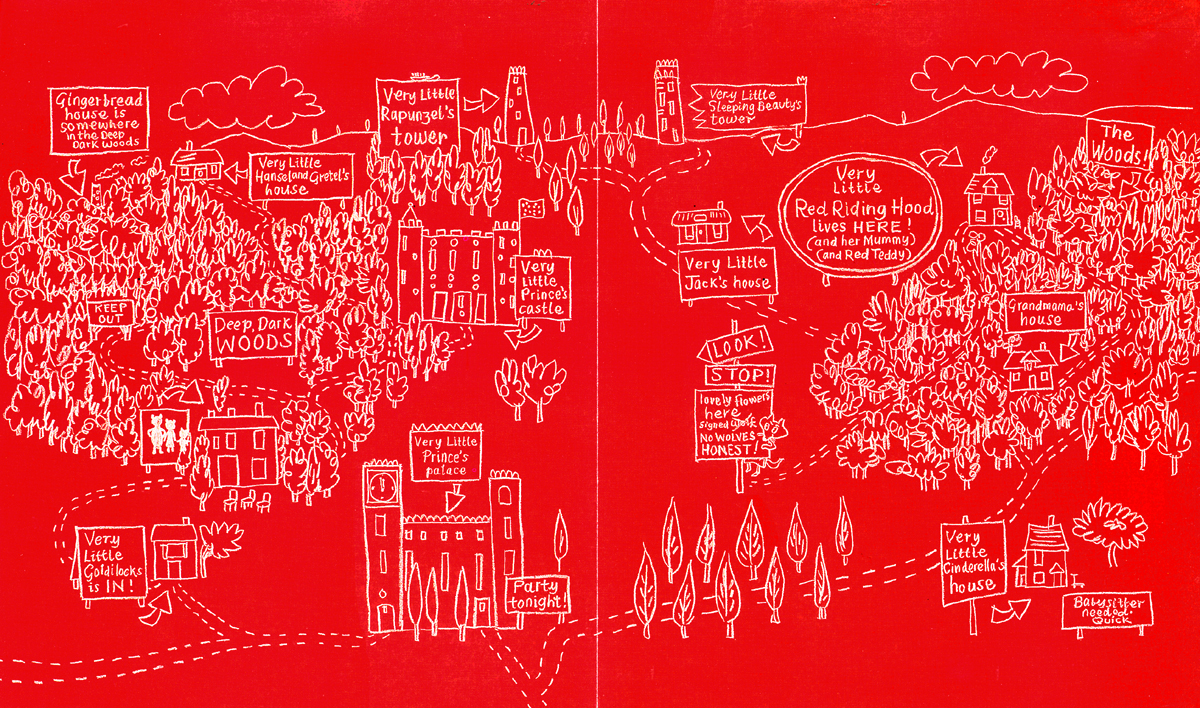
I can’t resist putting in these fresh and lovely animated spreads of the poor wolf getting more than it can deal with from Very Little Red.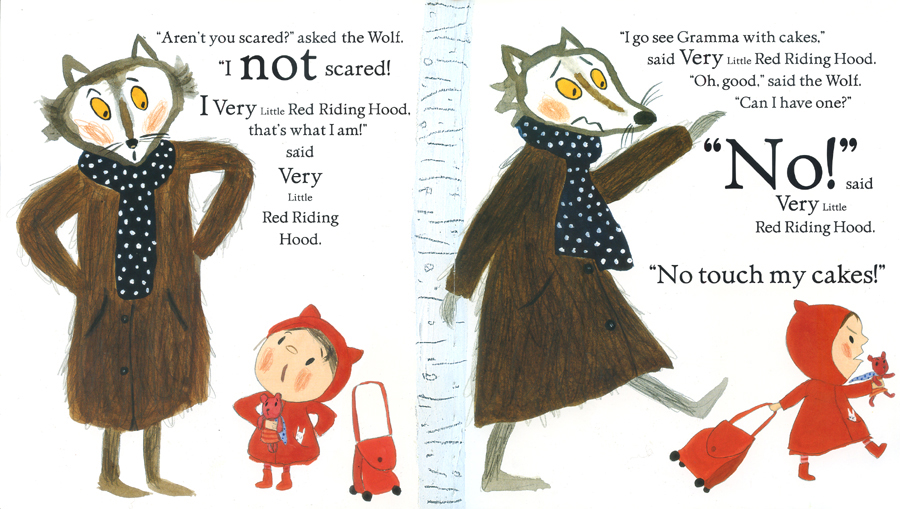
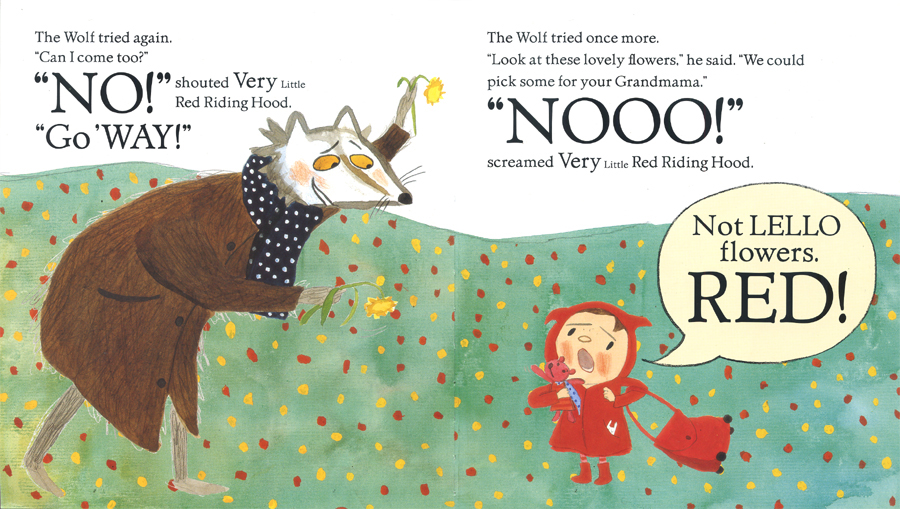
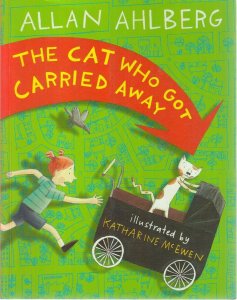 In The Cat Who Got Carried Away by Allan Ahlberg and Katharine McEwen there are three very important maps.
In The Cat Who Got Carried Away by Allan Ahlberg and Katharine McEwen there are three very important maps.
Here’s the first one.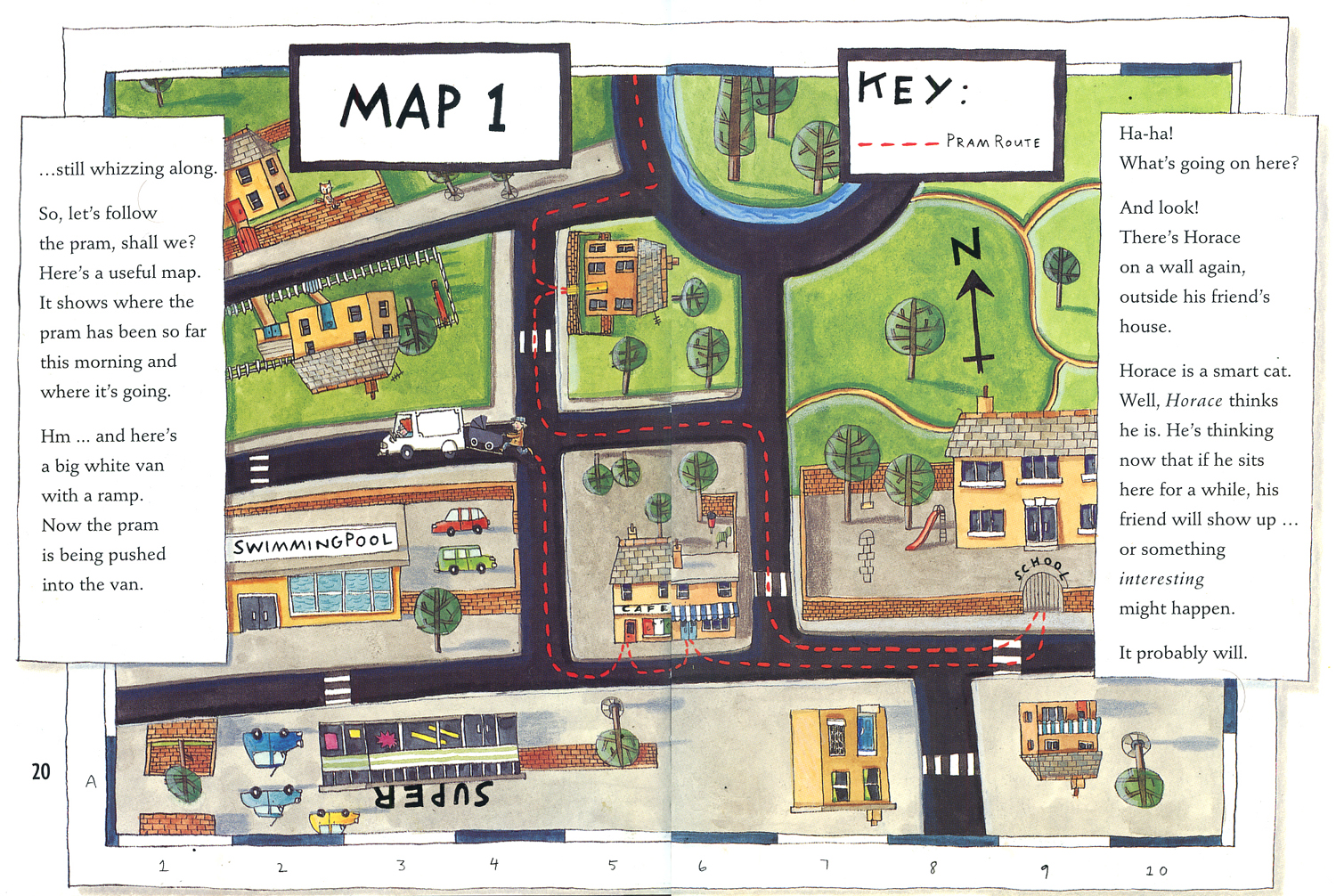
And, oh, how delicious – we can see the cars and the characters and the shady old geezer with the suspicious pram and Horace the cat. This is a useful map of a particular moment, which shows exactly where the pram is, and white van skulduggery, and the impending fate of Horace the cat.
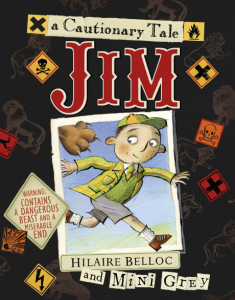 When I was making the book of Jim, the cautionary tale by Hilaire Belloc, I wanted to put in a map of the zoo where Jim meets his lion.
When I was making the book of Jim, the cautionary tale by Hilaire Belloc, I wanted to put in a map of the zoo where Jim meets his lion.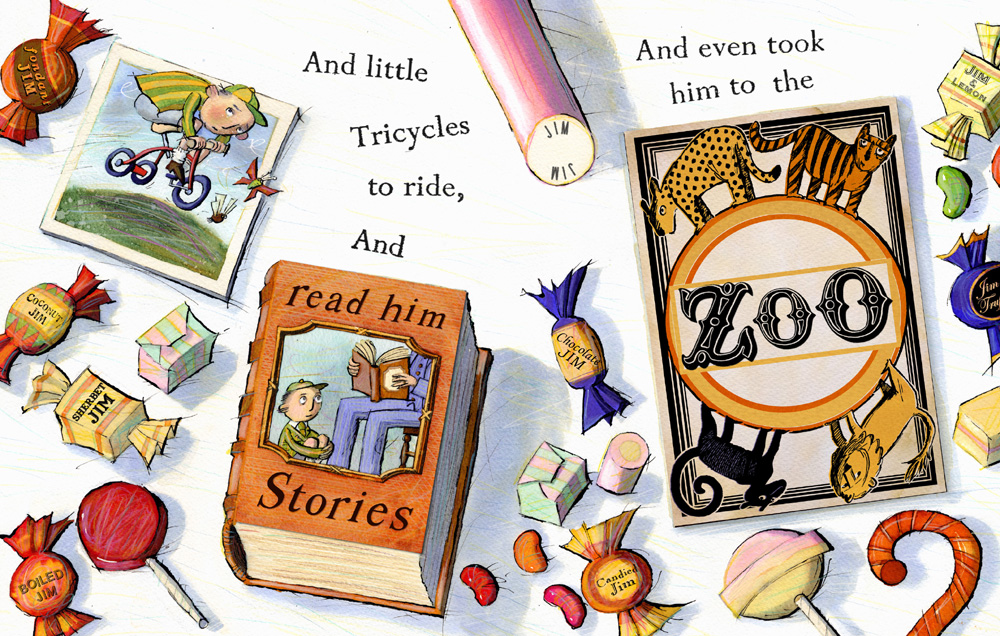
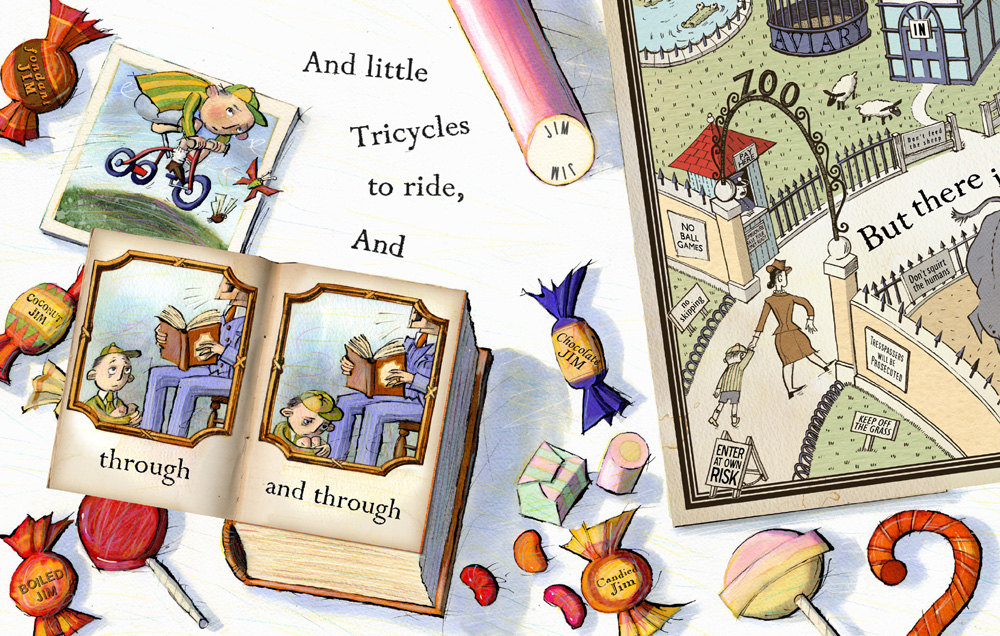
Jim has a yearning to run away, and when I was making the book there seemed to be more and more health and safety rules appearing everywhere and children seemed to be getting less and less freedom. So the Zoo Map is a map of the Safest Zoo in the World, one where everything is either shut or off-limits or prohibited.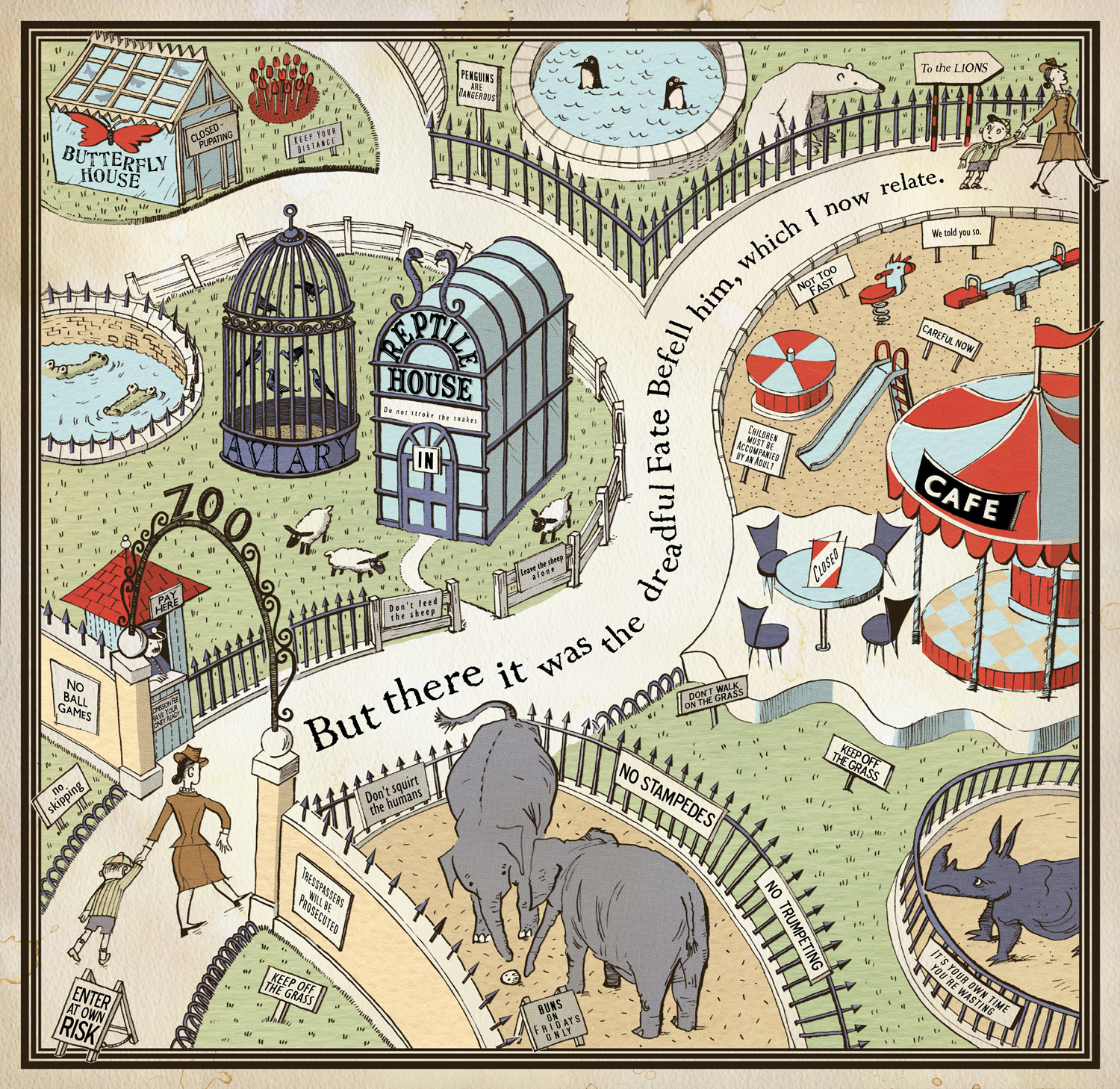
To make sure everything is completely safe, there are Zoo Rules on the back of the map.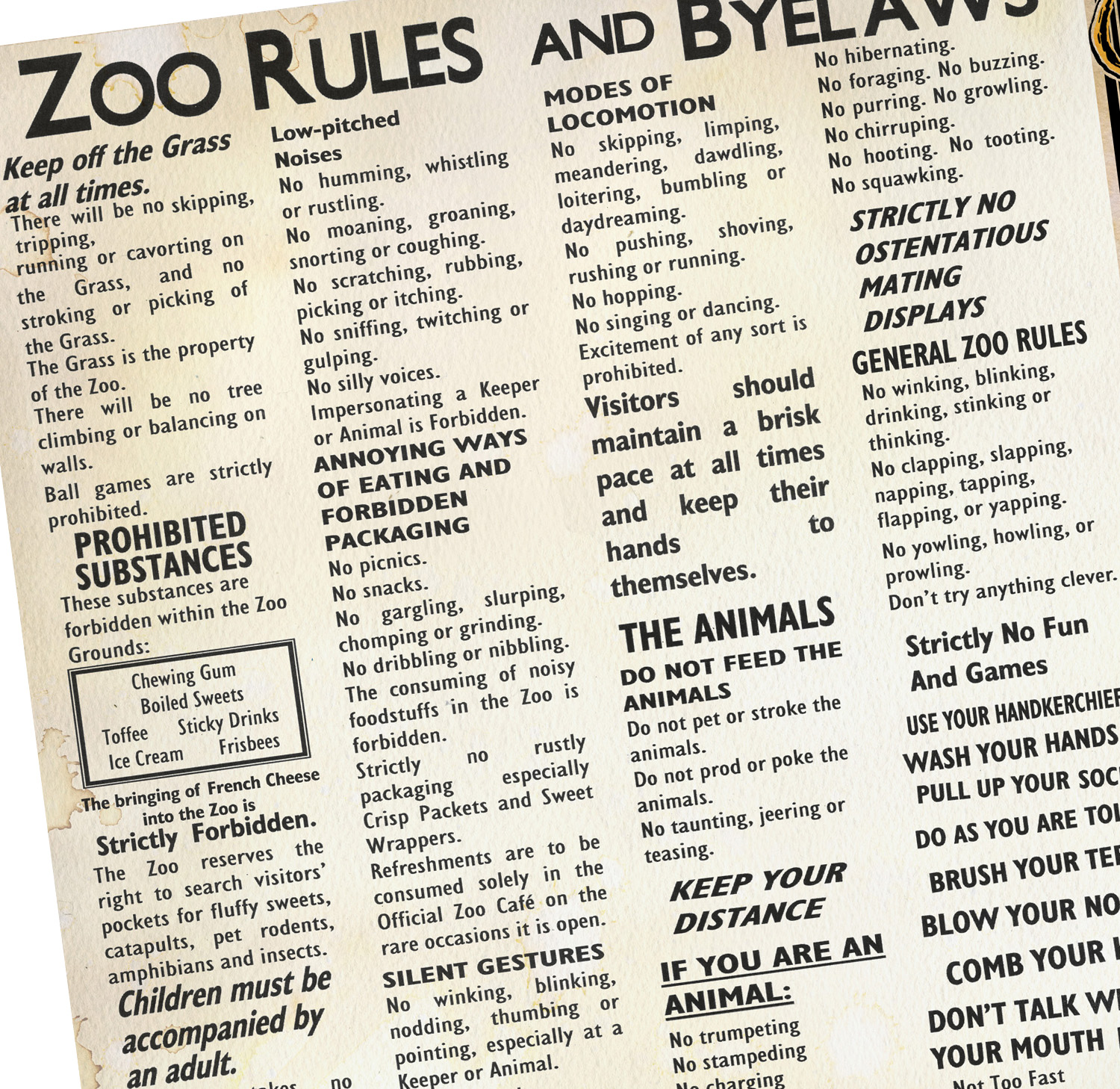
Metaphorical Maps, Maps of the Soul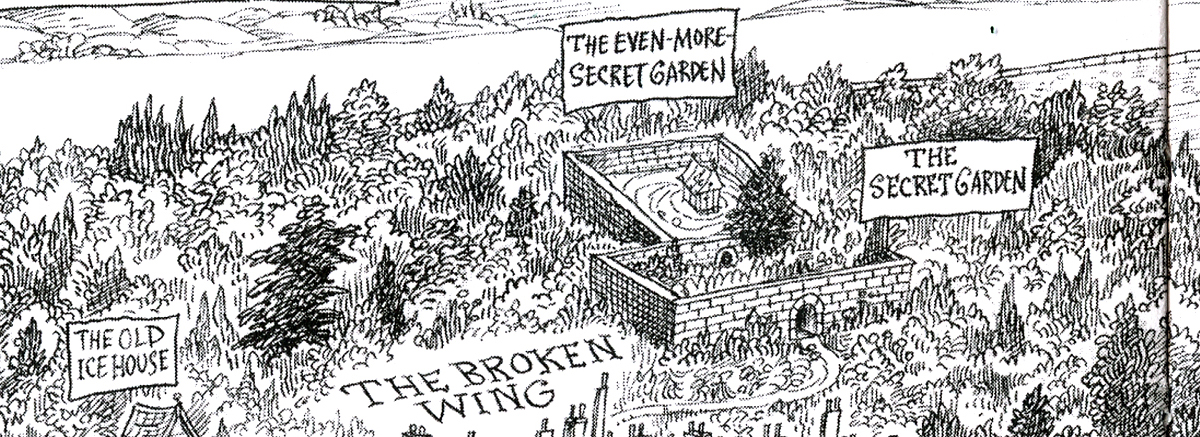
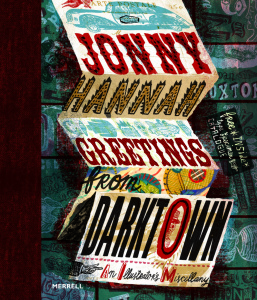 Here is Jonny Hannah’s Dark Town map from Greetings from Dark Town – complete with leviathans, Island of Profound Quotes, Sea of Impossibilities and beasts and more beasts.
Here is Jonny Hannah’s Dark Town map from Greetings from Dark Town – complete with leviathans, Island of Profound Quotes, Sea of Impossibilities and beasts and more beasts.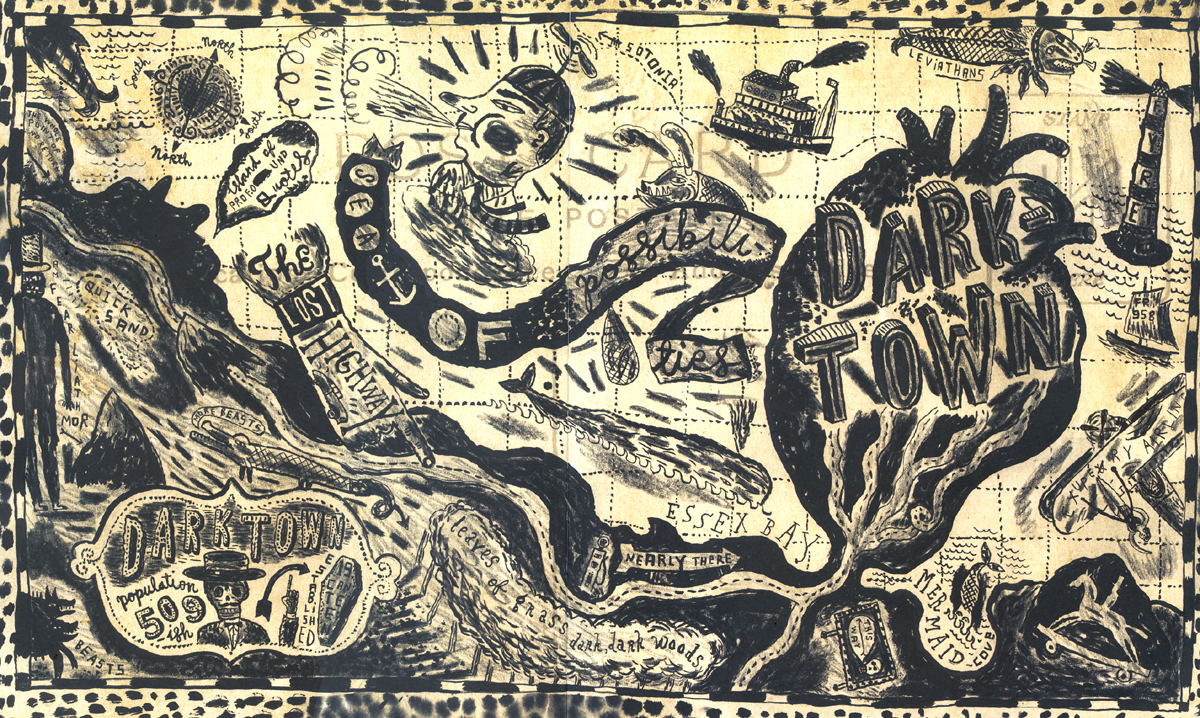
The first metaphorical map may have been for Pilgrim’s Progress, which also may have been one of the first novels (fictional prose narrative) in English. (Interestingly, other early novels include Robinson Crusoe and Gulliver’s Travels, both map-centred-adventure territory.) In Pilgrim we encounter unforgettable fictional places: the Slough of Despond, Vanity Fair, the House Beautiful, The Valley of the Shadow of Death.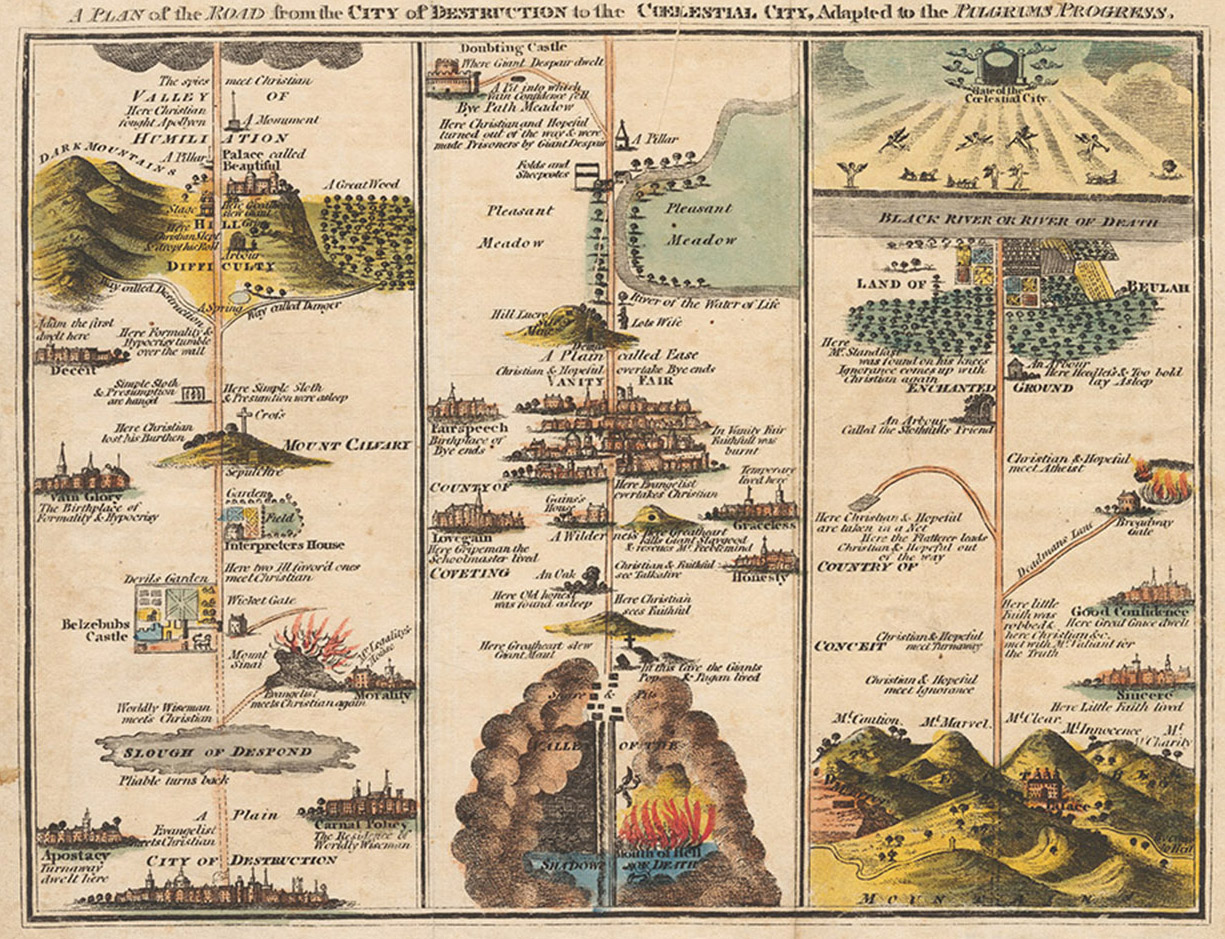
Here’s the Map of Ghastly Gorm Hall from Goth Girl, by Chris Riddell.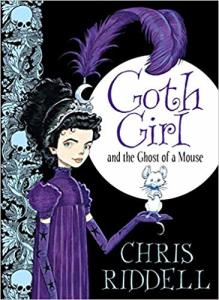
 Note the Hall has an East Wing and a West Wing, but also a Broken Wing. As well as a Kitchen Garden, the Hall is complete with Bedroom Garden and Living Room Garden.
Note the Hall has an East Wing and a West Wing, but also a Broken Wing. As well as a Kitchen Garden, the Hall is complete with Bedroom Garden and Living Room Garden.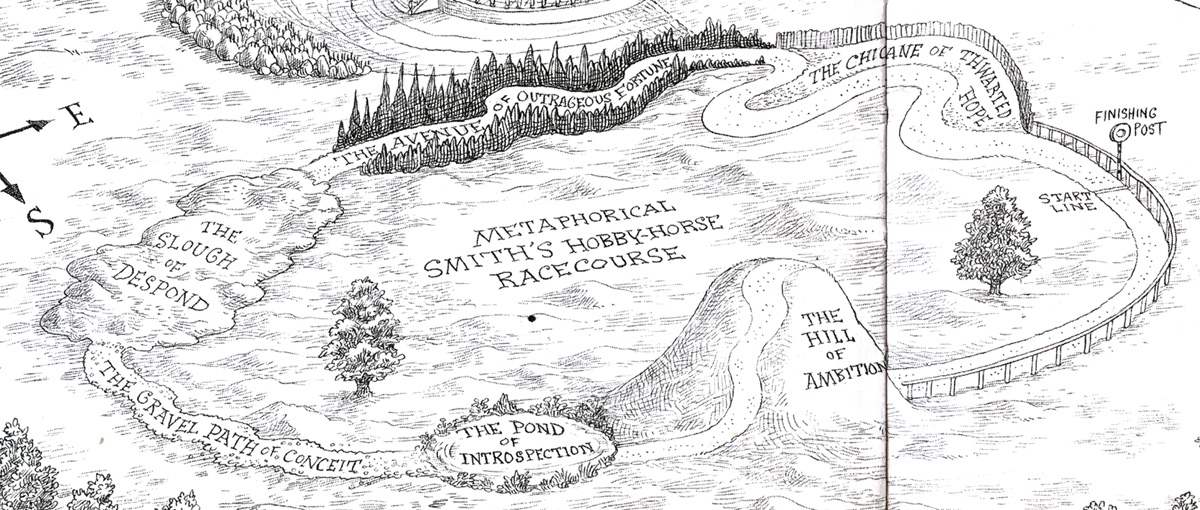
I’m planning my garden improvement already.
One can meander round Metaphorical Smith’s Hobby-Horse Racecourse – with its Hill of Ambition, Gravel Path of Conceit, and Pond of Introspection.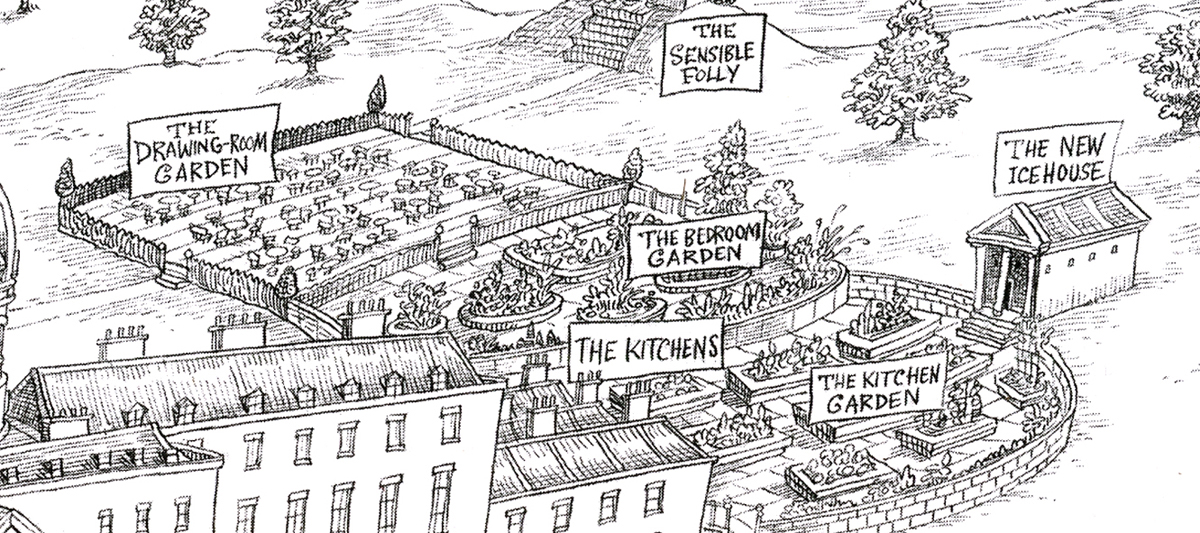
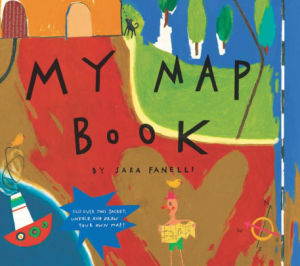 In Sara Fanelli’s My Map Book –we find a Map of my Heart, a Map of my Day.
In Sara Fanelli’s My Map Book –we find a Map of my Heart, a Map of my Day.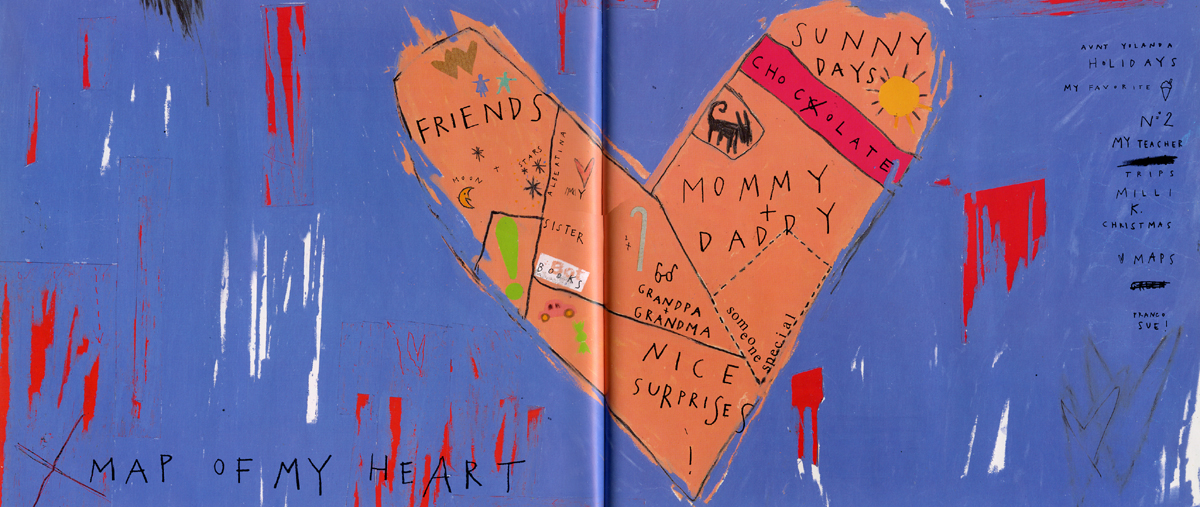
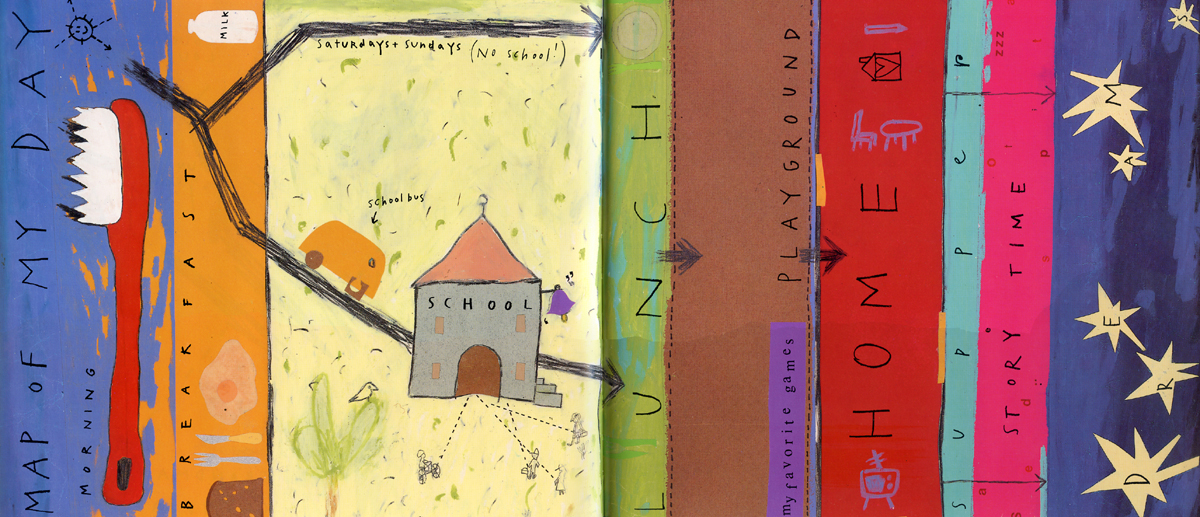
We’re wandering into maps that are states of mind, a map of how you feel, a map of time.
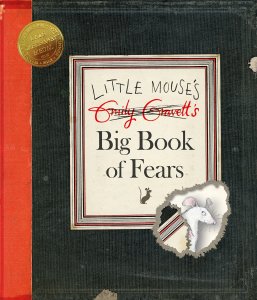 One of my absolutely favourite picture books is Emily Gravett’s Little Mouse’s Big Book of Fears. Mouse battles his terrors with the power of drawing. The book is extremely nibbled and so is Mouse’s pencil.
One of my absolutely favourite picture books is Emily Gravett’s Little Mouse’s Big Book of Fears. Mouse battles his terrors with the power of drawing. The book is extremely nibbled and so is Mouse’s pencil.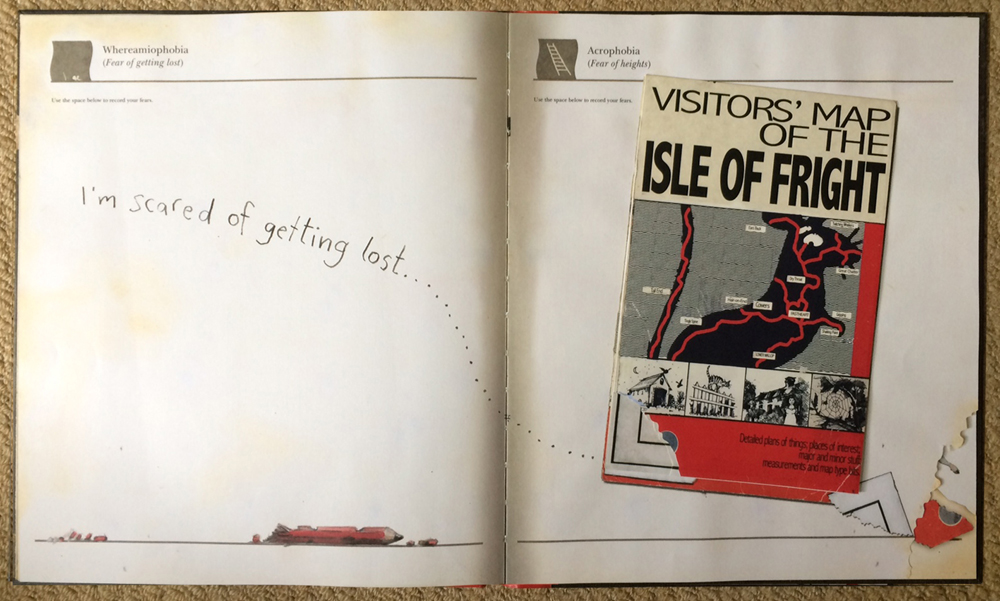
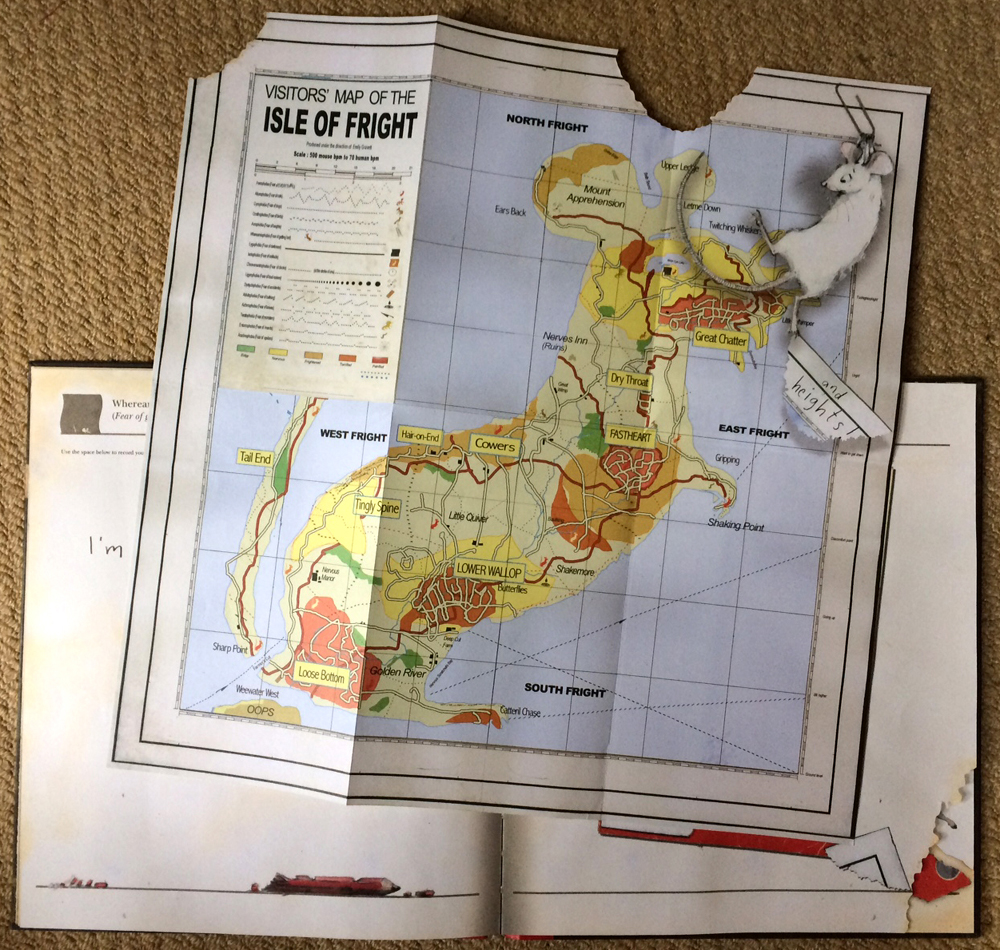
Here is the Map of the Isle of Fright, where the visitor can travel from Twitching Whiskers to Loose Bottom.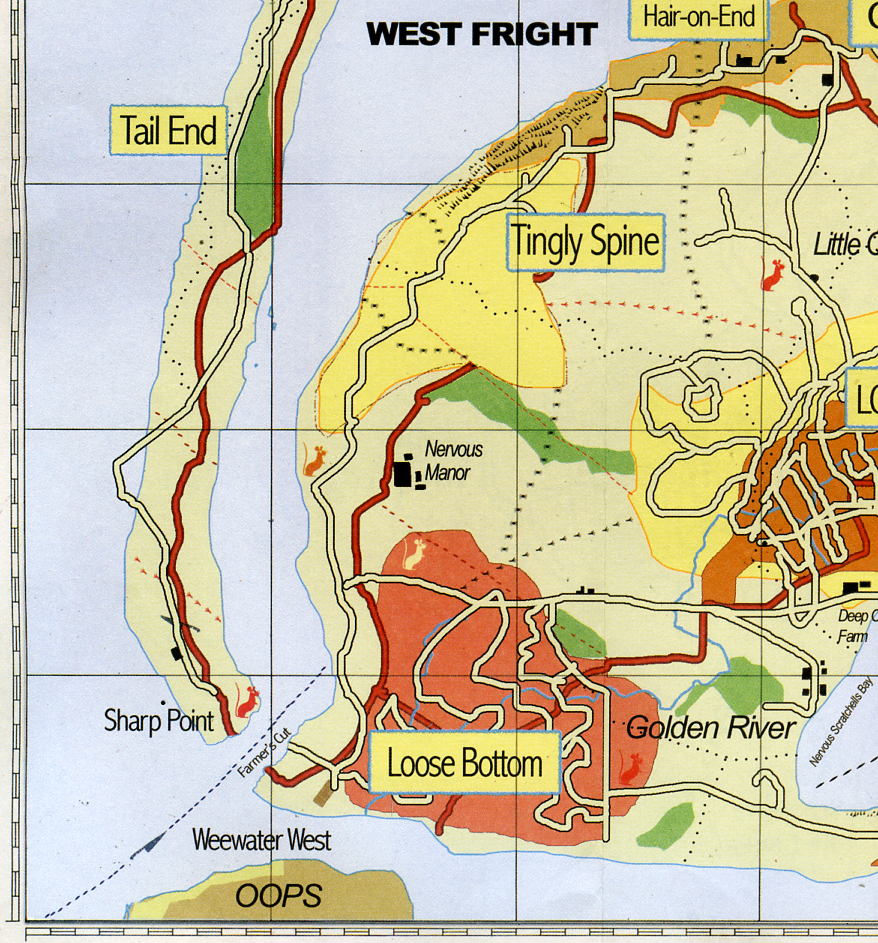
And now – Exclusive to Picture Book Den:
Cut Out & Keep: Make Your Own Metaphorical Landscape Generator.

Making a map gives you freedom to map the impossible, to lose yourself in your scale of choice.
In A Boy & Bear in a Boat by Dave Shelton – here’s a map of nowhere. It’s almost not a map at all.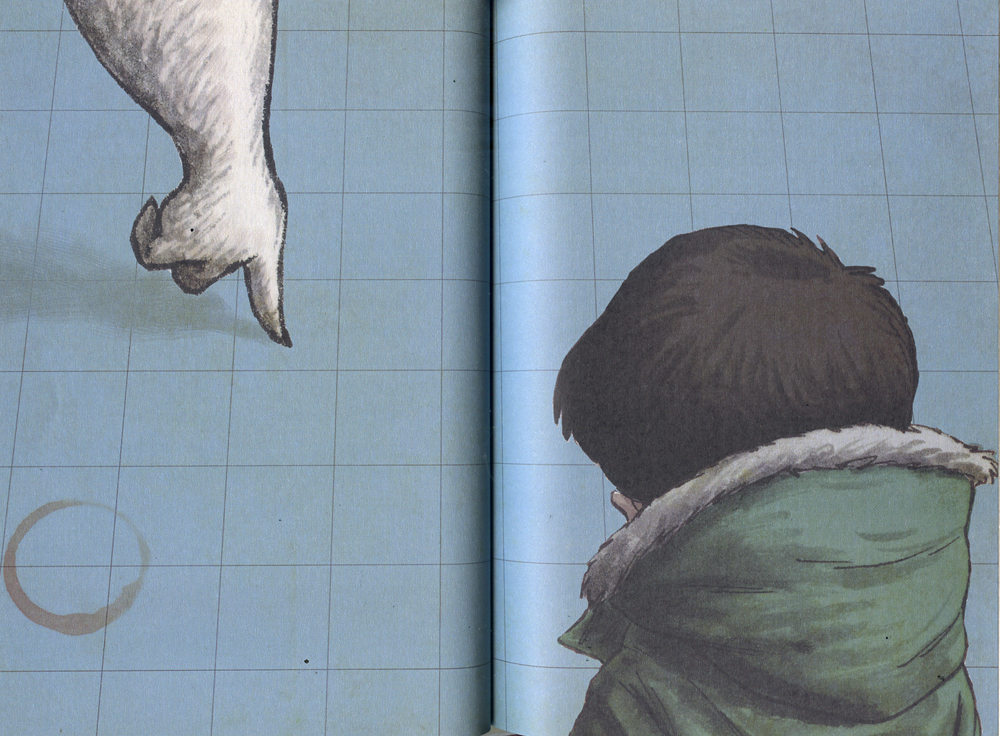
Here’s the map on the cover of the book (from the original hardback version)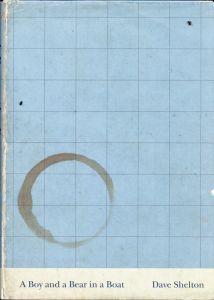
No features at all. Except a mug ring. But then, look again….squinting closely– there are two black splots.
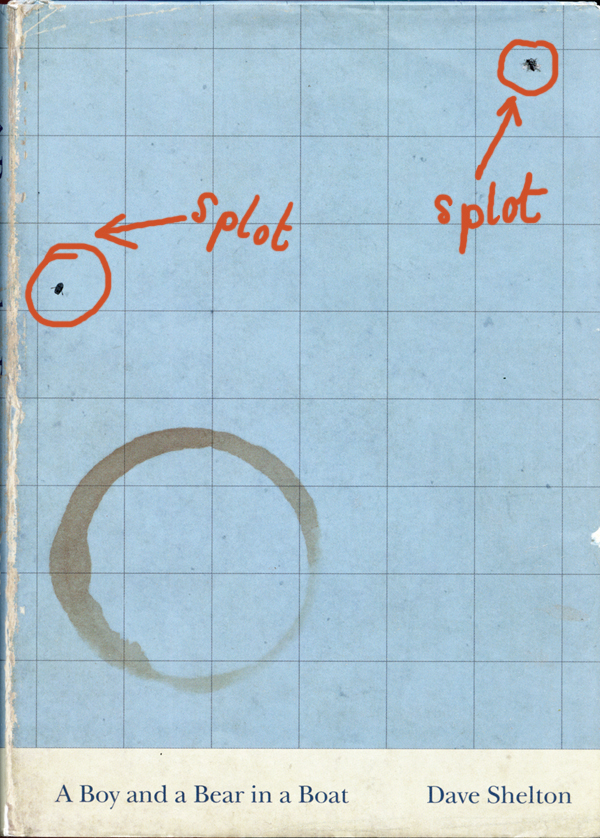
Focus in on one and it’s – yup, just a squashed fly.
Then let’s pull right in on the other splot – I definitely see oars there.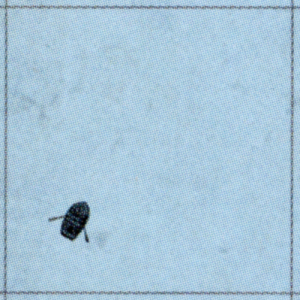
The scale of the bleak emptiness is immense, and I feel like I am falling through infinity.
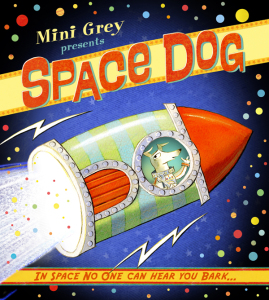 My book Space Dog started with thinking about making a space map. My son Herbie had a brilliant rocket toy. It came from the Early Learning Centre.
My book Space Dog started with thinking about making a space map. My son Herbie had a brilliant rocket toy. It came from the Early Learning Centre.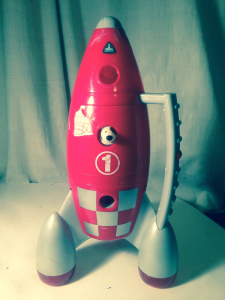
It was shaped a bit like a kettle with a handle, and you could fly it all round your home, exploring the Cistern System, the Pastaroid Belt and the Outer Spooniverse.
I wondered – what would space look like if the whole of the universe was actually everything in your house, in disguise. So here we have some Space Map Planetoids:
FryUp42 with its ketchup volcanoes, the steamy planet of Bathtime 37 and Cornflake 5 and Bottleopolis which are in the Breakfast Cluster.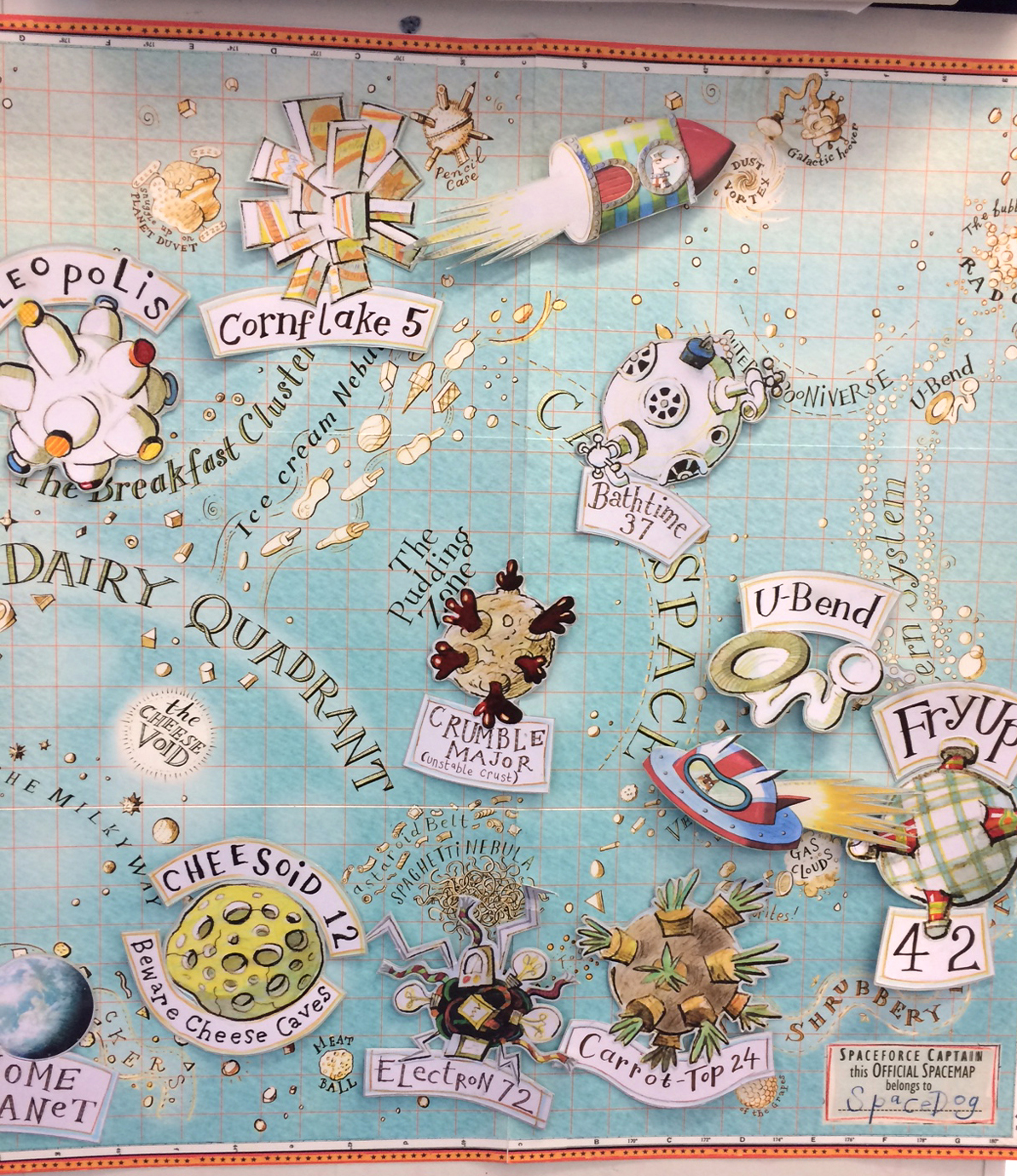
The Space Map was Space Dog’s endpapers, but, alas, they only appeared in the hardback version.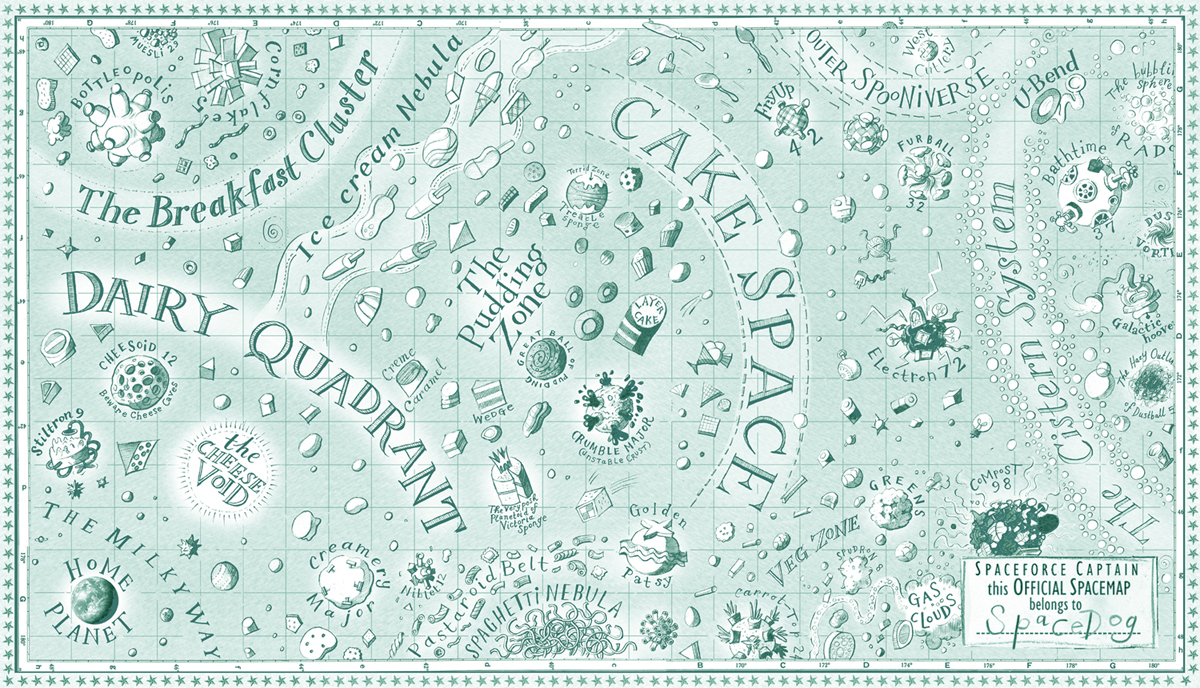
Download your own space map bits here, and make your own Space Map.
Take some words, maybe these ones which are a list of some things you might forget: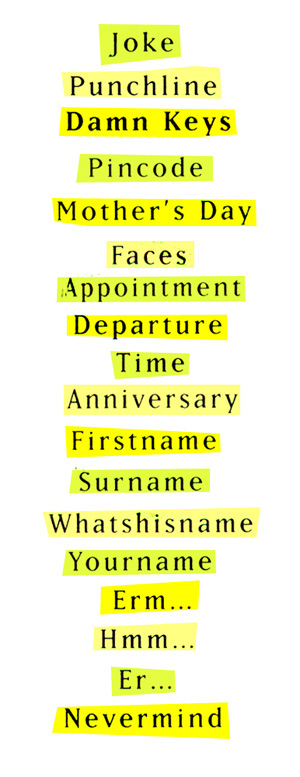
Take a diagram of some islands, maybe these ones: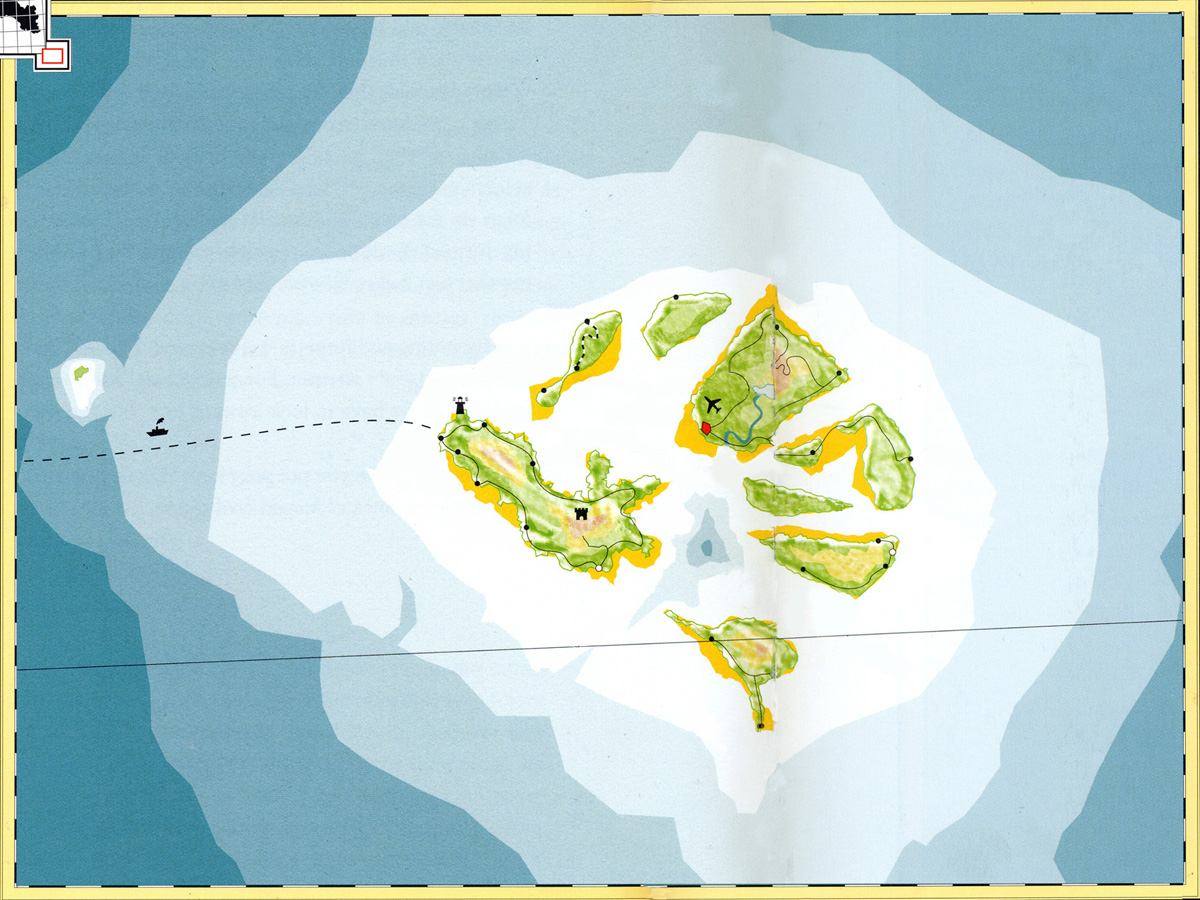
Put them both together, and what have you got?
The Isles of Forgetfulness.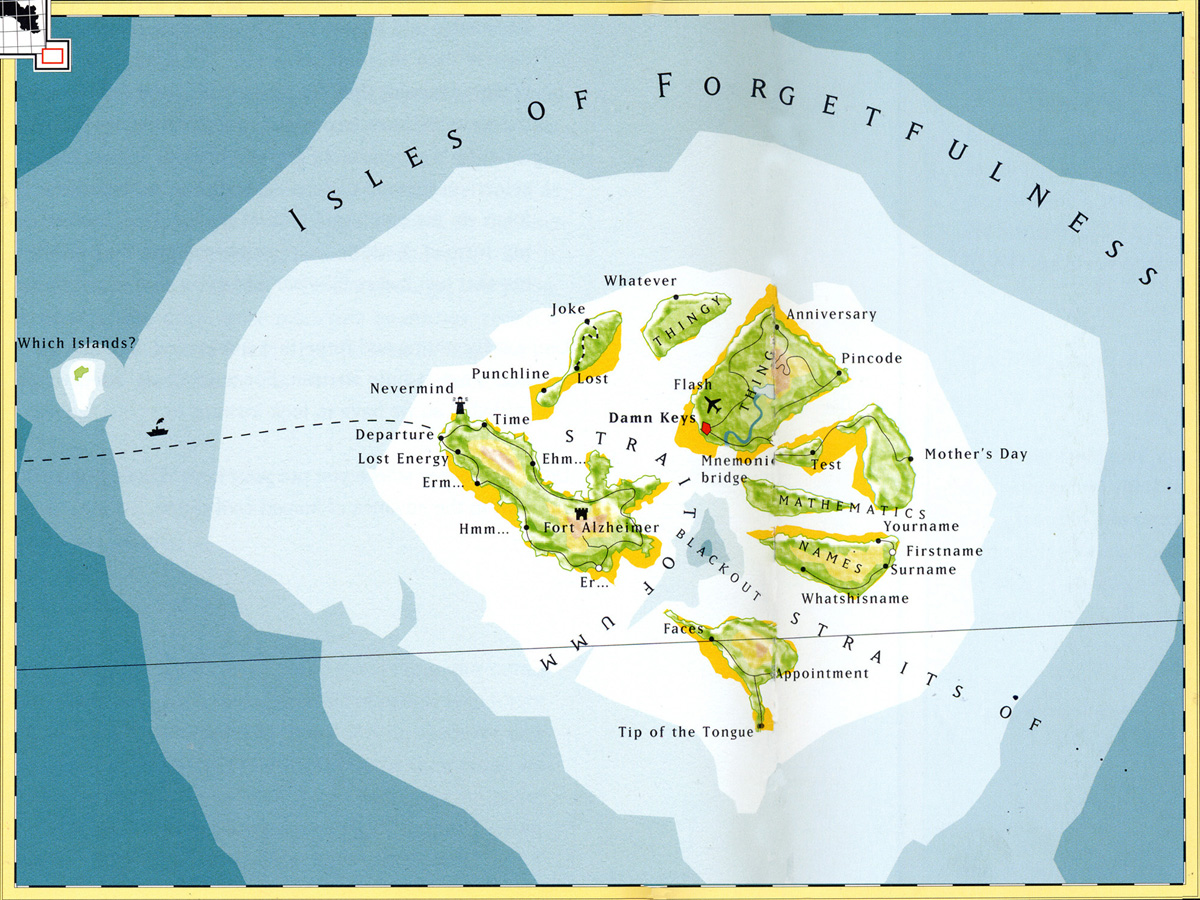
This page comes from The Atlas of Experience by Louise van Swaaij and Jean Klare, which charts the human journey through life, with maps drawn in Subjective Projection and reproduced in Unimaginable Scale.
Maps demonstrate the alchemy of words and pictures, that magic picture book double act. Words & Pictures and your imagination are doing the work of together creating a whole new thing. And because your imagination helped make it, it’s unique. So the map is words and pictures glued all together with a tremendous projection of imagination.
Falling into a Map, endless Maps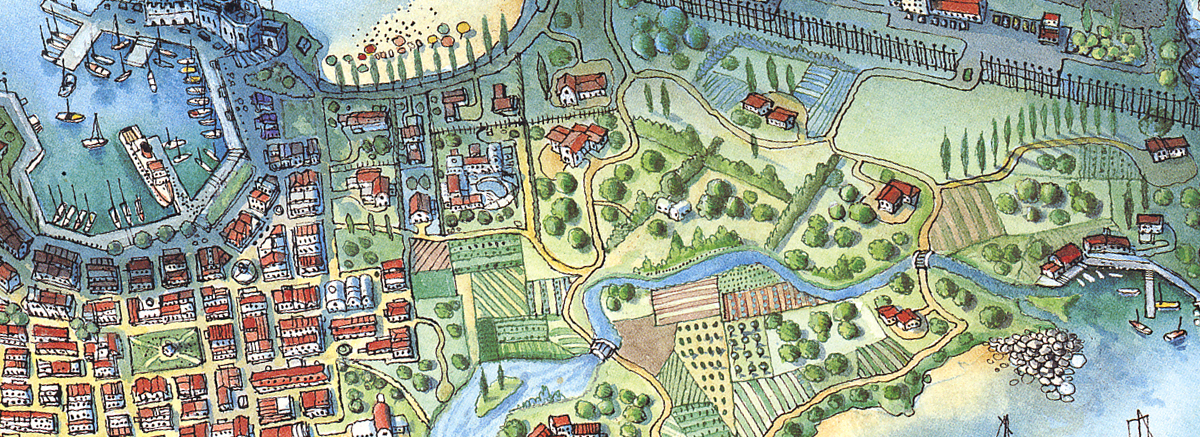
My dream is to be able to actually fall into a map and find myself in another world that I can explore. Or to find a map that I can zoom into or out of forever…from the microscopic atomic scale to the intergalactic.
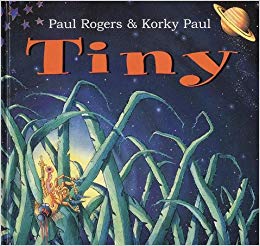 In Tiny by Korky Paul and Paul Rogers, Tiny is a flea on the back of a dog called Cleopatra living at No 72 Hilltop Road.
In Tiny by Korky Paul and Paul Rogers, Tiny is a flea on the back of a dog called Cleopatra living at No 72 Hilltop Road.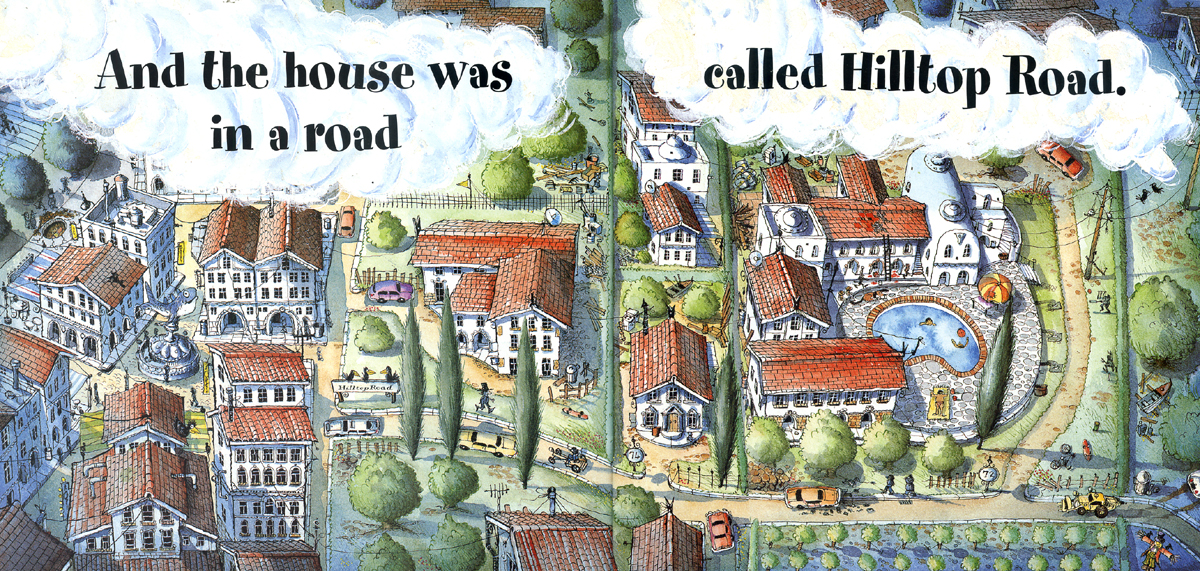
Korky Paul’s marvellously detailed pictures pan out from hairs to streets to islands to planets.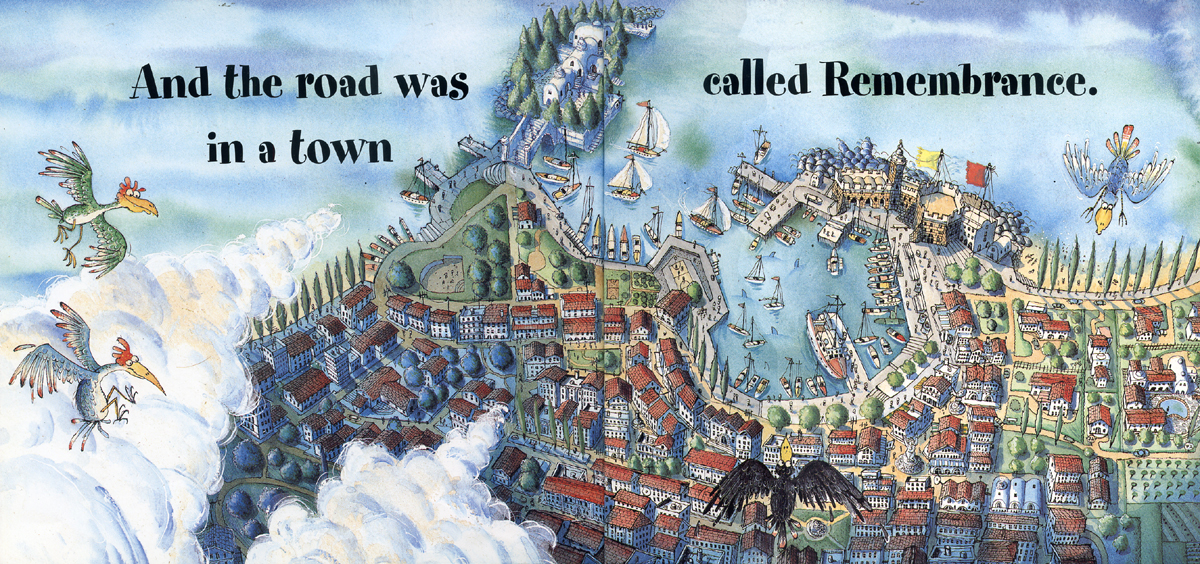
But every time I can still spot the dog, find the house still recognisable at a smaller scale.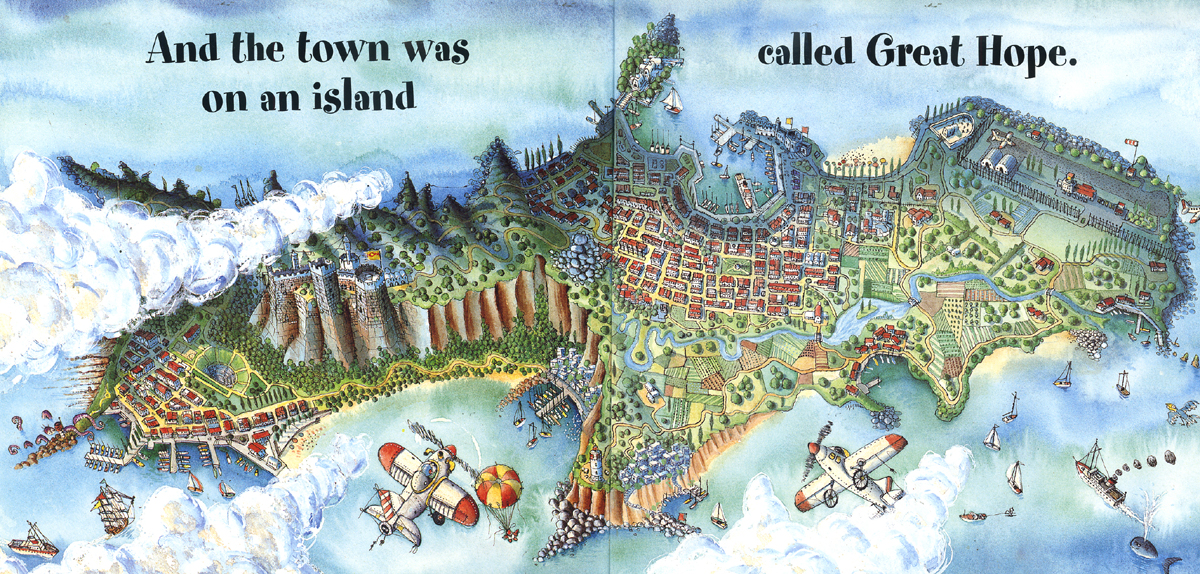
I know if I zoom back in I’ll be able to find EVERYTHING there, every bird, fish, person, dog, insect, molecule. (I love that giant octopus.)
To end with I’m going to tell you about one of the very first picture book maps I ever made.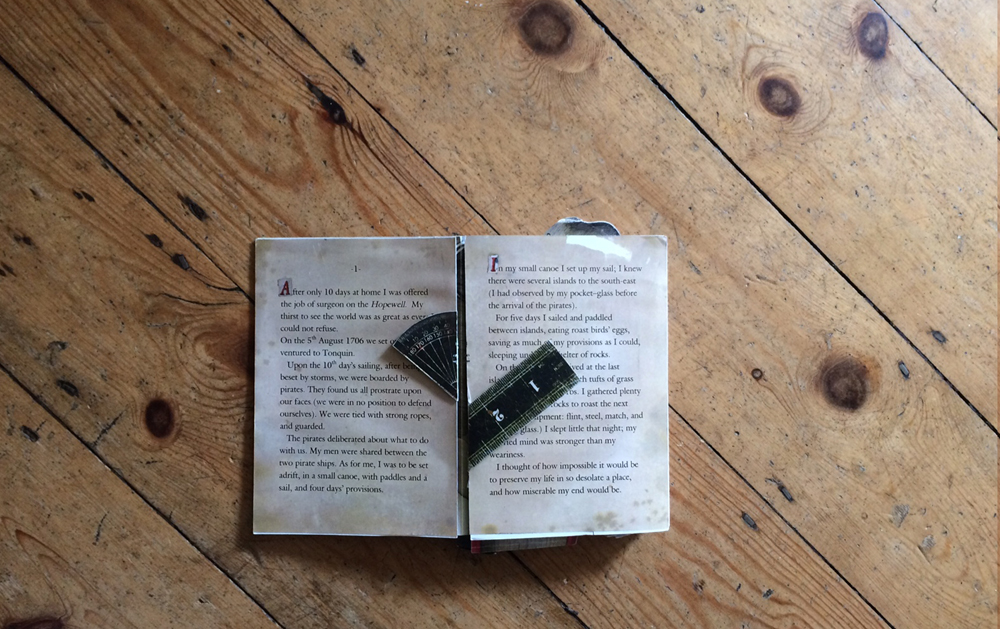
Heres the flying island of Laputa
It was for a student project, adapting Gulliver’s Travels.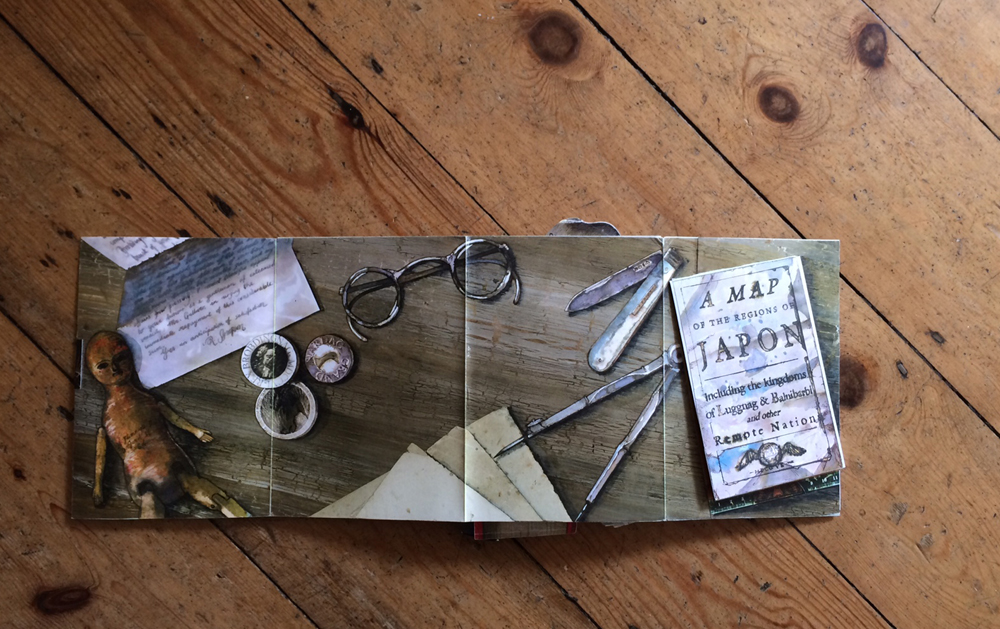
The first page opens out to show Gulliver’s desk and his map.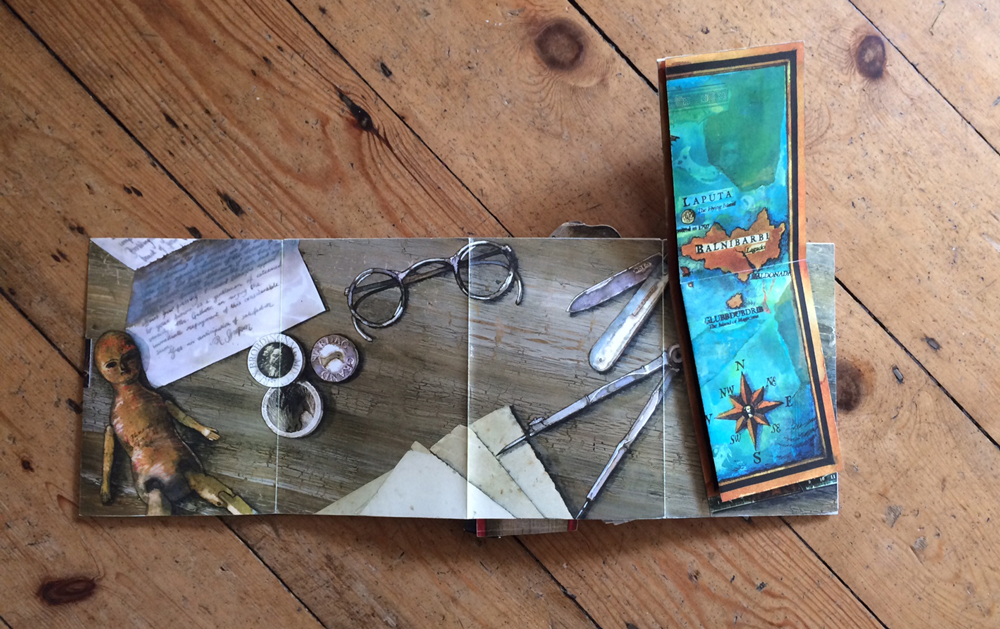
In the map you can make out Gulliver abandoned in a rowing boat, and the flying Island of Laputa about to come over and pick him up.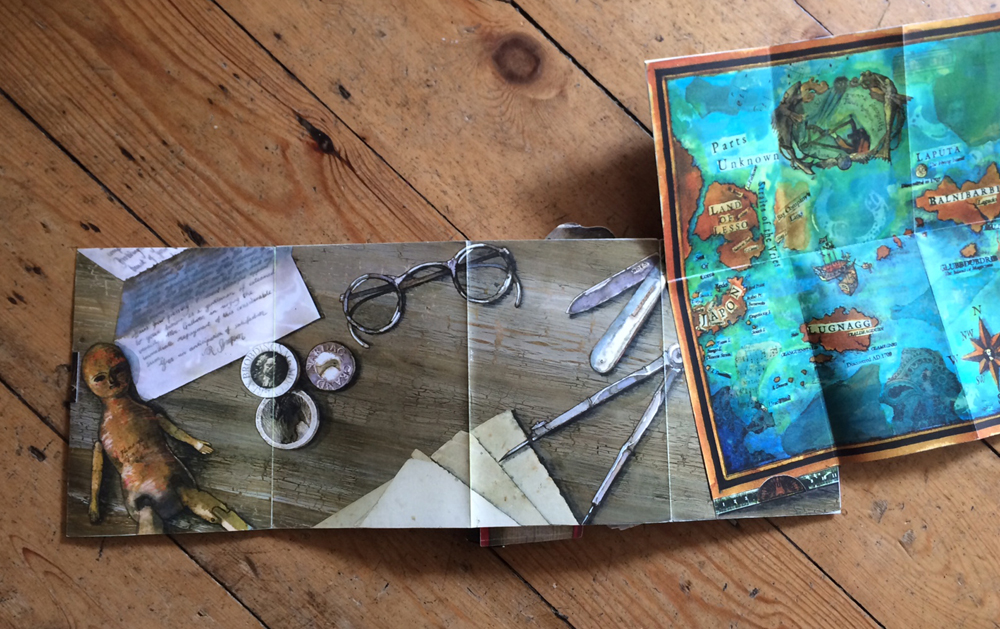
What I really really wanted was for you to be able to zoom in enough to for you to be able to see the waves rippling the water, to smell a bit of spray and hear some seabirds. I did (sort of, badly) manage to do this when I animated my book and falling into the map 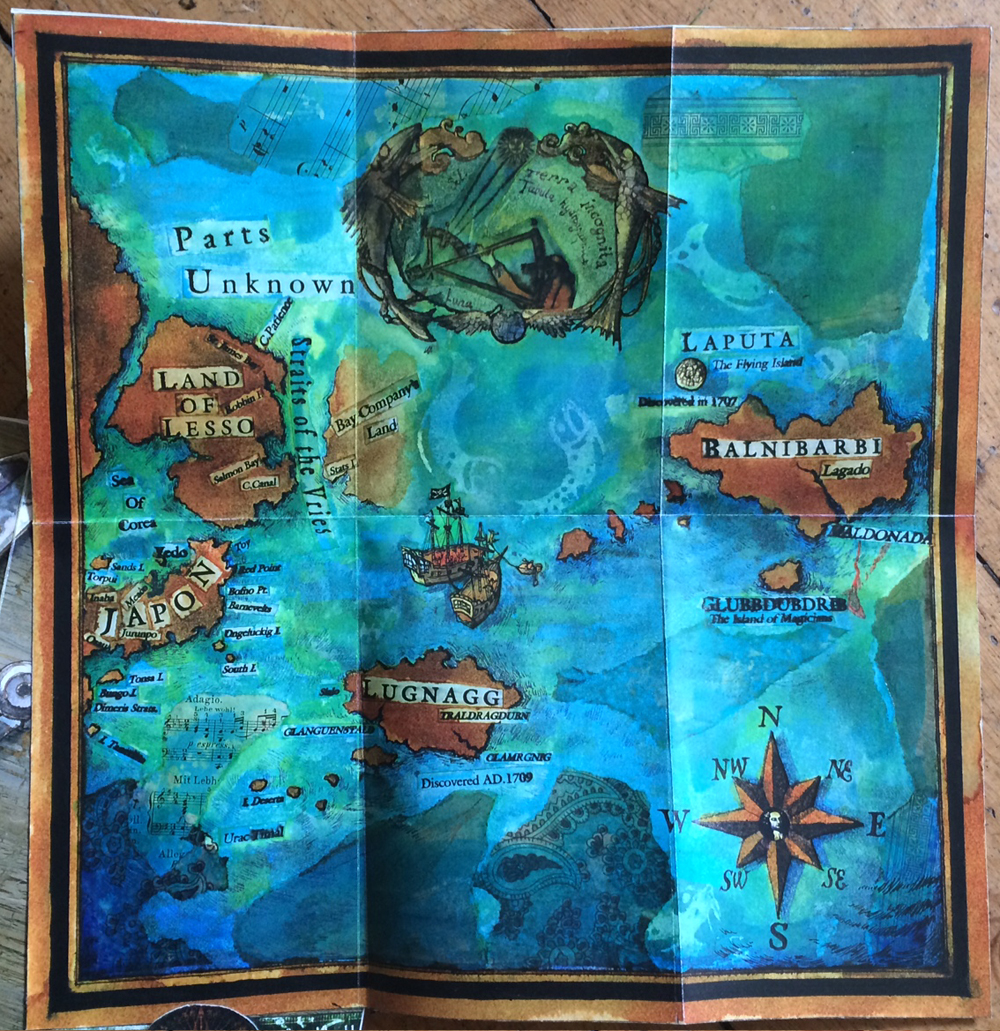 became the beginning of Gulliver’s adventures on the crazy island of Laputa.
became the beginning of Gulliver’s adventures on the crazy island of Laputa.
A map is a place to roam about in the imagination. A map is a record of the discovered and the undiscovered. A map is a plan for plundering, or a diagram of how to carve up the world. A map is a journey, a story, a cast of characters, a portal.
I’ve always been obsessed with the small world. Small worlds are where we are animators as children: the doll’s house, the micro city you made among tree roots, the box of plastic dinosaurs and farm animals ready to journey down the garden. A map is a model world, and in picture books maps can come alive, using the power of words and pictures and your imagination and mine, in yet another feat of picture book magic.
PS: Interested in maps and in Oxford? There’s an wonderful exhibition – Talking Maps – at the Bodleian Library you might like to visit. Details here.
A wander into the world of Wind in the Willows
This post first appeared on Picture Book Den’s Blogspot.
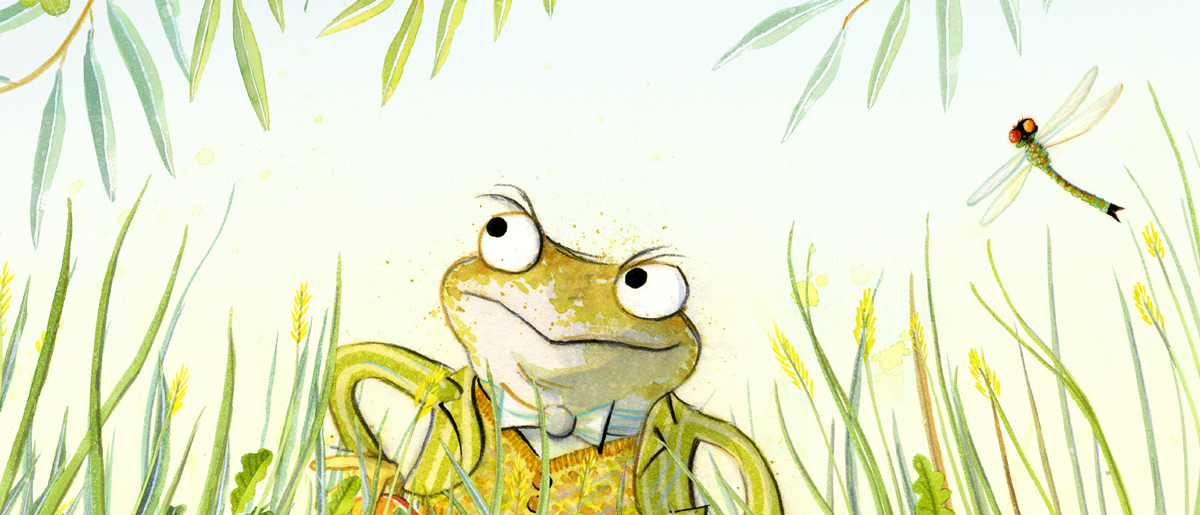 As a child I watched far too much TV. There was a show called Tales of the Riverbank. The stars of the films were real animals, who were shown moving around in miniature boats, cars, balloons and aeroplanes. I loved seeing rodents rushing downstream in rickety water-crafts.
As a child I watched far too much TV. There was a show called Tales of the Riverbank. The stars of the films were real animals, who were shown moving around in miniature boats, cars, balloons and aeroplanes. I loved seeing rodents rushing downstream in rickety water-crafts.
 I live near the river in Oxford, and there’s nothing I’d be so excited to see as a water-vole rowing a tiny boat down the Thames.
I live near the river in Oxford, and there’s nothing I’d be so excited to see as a water-vole rowing a tiny boat down the Thames.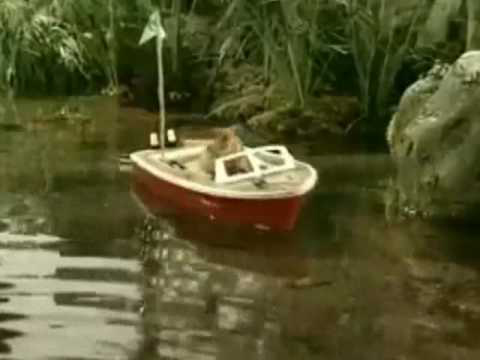
The original messing about in boats is of course in The Wind in the Willows. And I’ve recently finished making the illustrations for a story set slap-bang in Wind in the Willows territory, so in this post I’m going to have a look at Kenneth Graham’s book and some of its illustrators. I want to consider the challenges of illustrating in the Willows Zone, and how the Willows, the most comfortingly nostalgic of books, was actually shivering with premonitions of the modern world.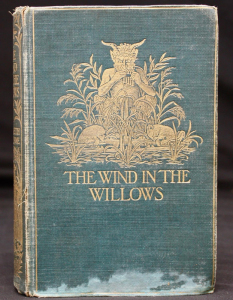
The book was published in 1908, but it wasn’t until 1931 that EH Shepard illustrated it. To me EH Shepard’s pictures are as much a part of Wind in the Willows as the text – so I was surprised to discover they weren’t there at the beginning.
Grahame didn’t live long enough to see the book released with Shepard’s illustrations, but their meeting would be reported by Shepard in a 1950s edition of the classic, as follows:
“Not sure about his new illustrator of his book, he listened patiently while I told him what I hoped to do.
Then he said ‘I love these little people, be kind to them’.
Just that; but sitting forward in his chair, resting upon the arms, his fine handsome head turned aside, looking like some ancient Viking, warming, he told me of the river nearby, of the meadows where mole broke ground that spring morning, of the banks where Rat had his house, of the pool where Otter hid, and of Wild Wood way up on the hill above the river.
…He would like, he said, to go with me to show me the river bank that he knew so well, ‘…but now I cannot walk so far and you must find your way alone’.”
Grahame was living in Pangbourne near the Thames – and at other times he lived in Cookham, also on the River Thames – so to me, the river running through the book is always the Thames – which bubbles up in Gloucestershire and flows through Oxford, Reading, Henley and Windsor and eventually becomes the great river that snakes through London on its way to the sea. Mole, on his escape from white-washing, is captivated by the river; it “chattered on to him, a babbling procession of the best stories in the world, sent from the heart of the earth to be told at last to the insatiable sea.”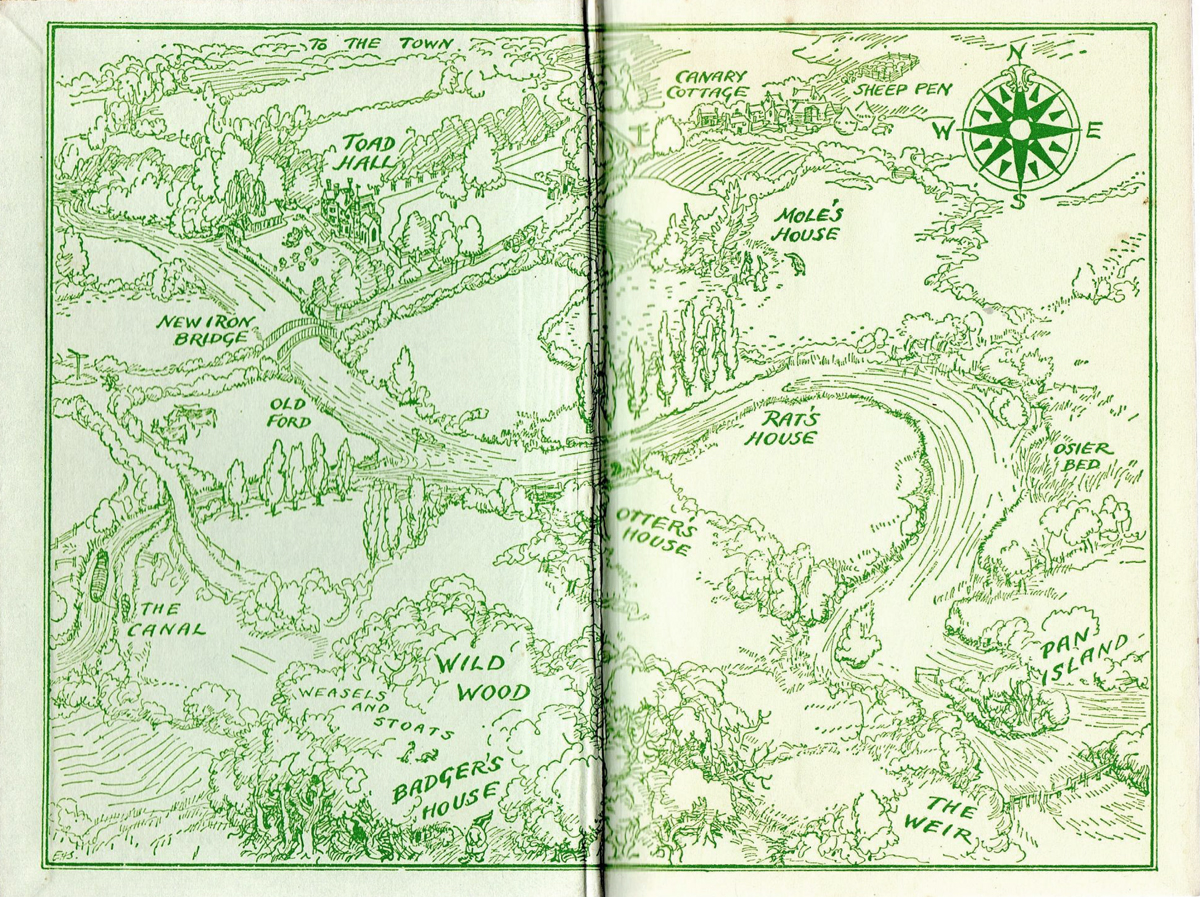
The Wind in the Willows has been rich ground for re-illustration. To me EH Shepard’s illustrations are part of its fabric, like Tenniel’s illustrations for Alice, but still both books are big enough to inspire reinvention.
And so far, in all the versions I’ve seen, the animals are wearing clothes.
Animals in Clothes
I have love-hate feelings about dressed-up animals. I really don’t like animals that seem to have human bodies under their animal heads. But if their body-shape seems to be the stumpy innocent sort of shape of an animal, then it’s OK.
Some animals seem to need more dressing up than others. As a child I used to adore these animal illustrations for the Woodland Happy Families game by Racey Helps.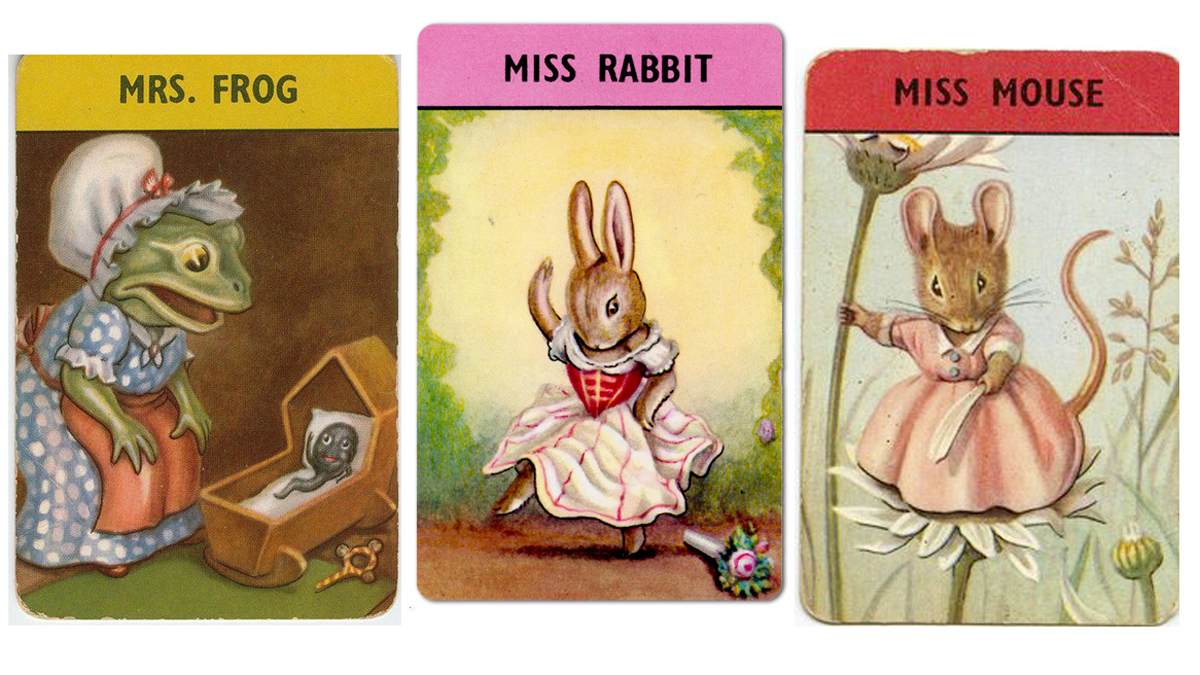
I love Mrs Frog’s expression as she gazes at her cheerily waving tadpole. My sister Jo and I used to play long and involved imaginary games with these cards as our avatars: – Jo was the glamorous Miss Rabbit and I was the slightly homelier Miss Mouse.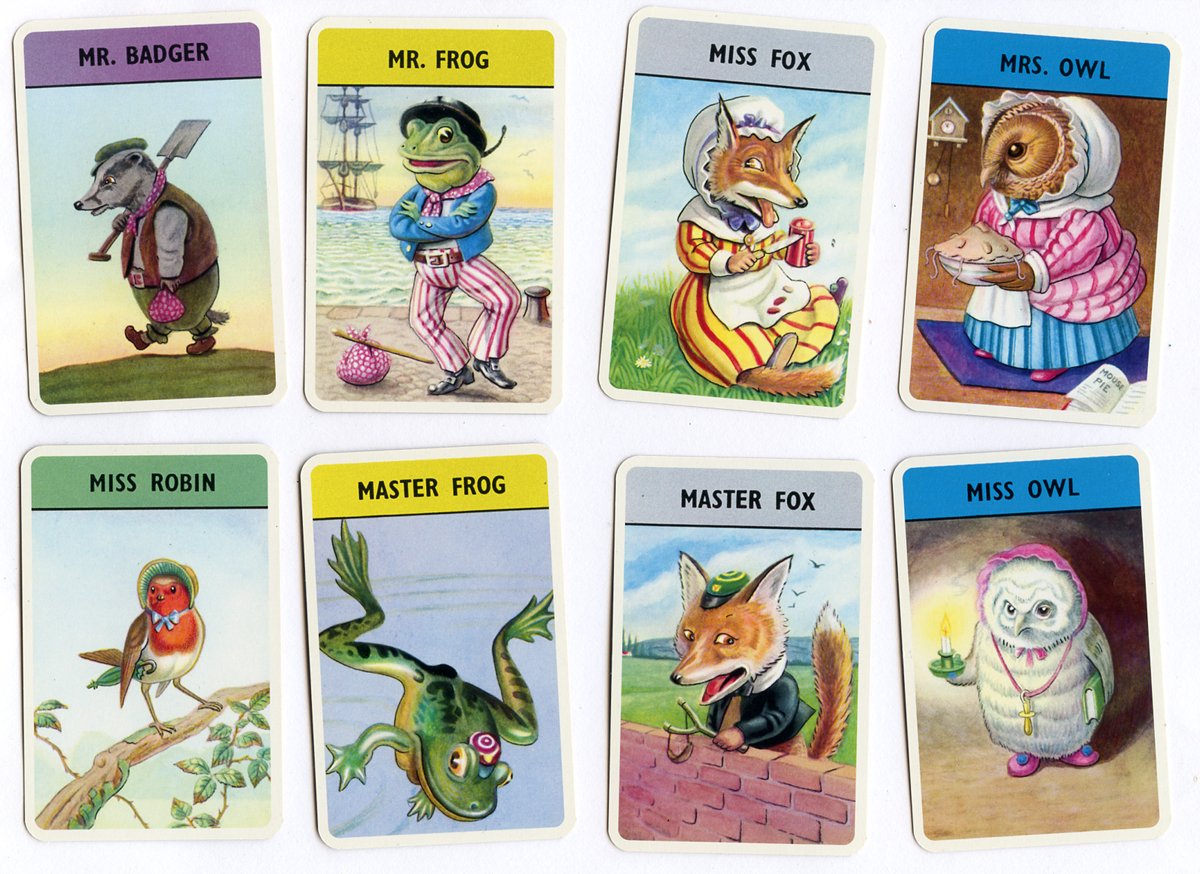
I do admire how Racey Helps’s animals are truly animal under their clothes – and have a look at Mrs Owl’s delicious pie. (Eeek. Don’t tell Miss Mouse.) The Woodland Happy Families are sometimes fully dressed complete with shoes, like Miss Fox, but other times just lightly accessorised, like Miss Robin. Master Frog is as nature intended as he goes for a swim, but Mr Frog has full sailor garb including little boots… (So how DO those flippers fit in? Better to skim quickly over questions like this when considering animal-dressing.)
With EH Shepard the main characters are completely suited and booted. But the weasels and stoats just have the odd bag and hat – so it seems the less civilised & well-behaved you are, the less you wear. But then there’s practicality too: those swimmers Otter and his son Portly don’t wear clothes either.
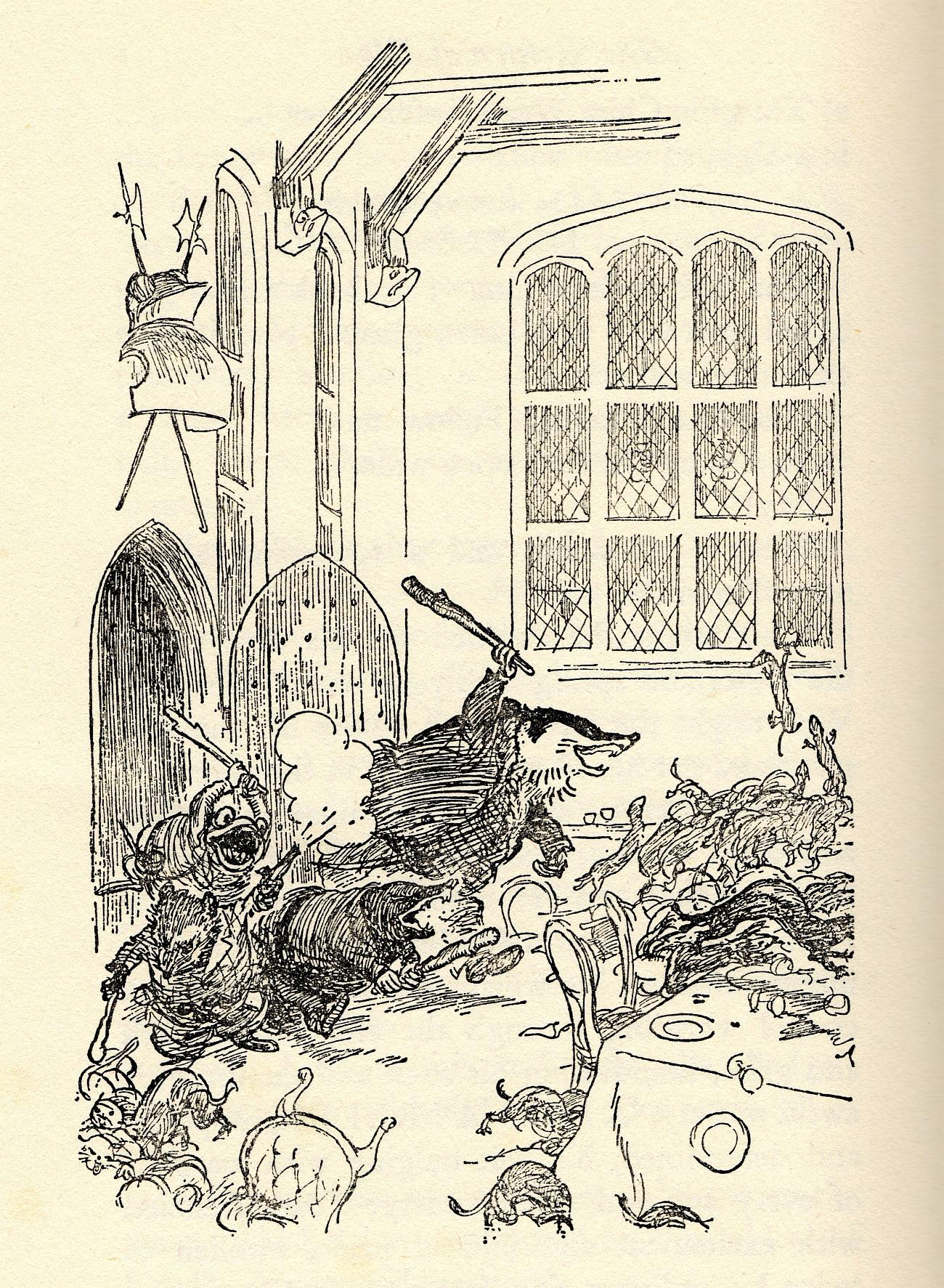 Here’s the battle of Toad Hall: Badger, Mole, Toad and Ratty are all showing their claws and teeth like proper animals on the warpath. The tiny weasels seem to have abandoned any pretence at civilisation and become pure animal as they scuttle away in terror. There is a bit of animal stereotyping in Wind in the Willows: weasels are actually brave, fierce and bonkers little animals – but in Wind in the Willows, as Ratty says: “well, you can’t really trust them, and that’s the fact.” It could be that the uprising of the less-well-dressed animal underclasses foreshadows the social upheaval of the First World War, and the unwinding of the Edwardian age of servants and huge hampers.
Here’s the battle of Toad Hall: Badger, Mole, Toad and Ratty are all showing their claws and teeth like proper animals on the warpath. The tiny weasels seem to have abandoned any pretence at civilisation and become pure animal as they scuttle away in terror. There is a bit of animal stereotyping in Wind in the Willows: weasels are actually brave, fierce and bonkers little animals – but in Wind in the Willows, as Ratty says: “well, you can’t really trust them, and that’s the fact.” It could be that the uprising of the less-well-dressed animal underclasses foreshadows the social upheaval of the First World War, and the unwinding of the Edwardian age of servants and huge hampers.
Here’s the same scene pictured by Inga Moore. Again, the weasels are just minimally accessoried and you can imagine the blood-curdling war-growls coming from Badger.
Here they are getting weaponed up for the battle.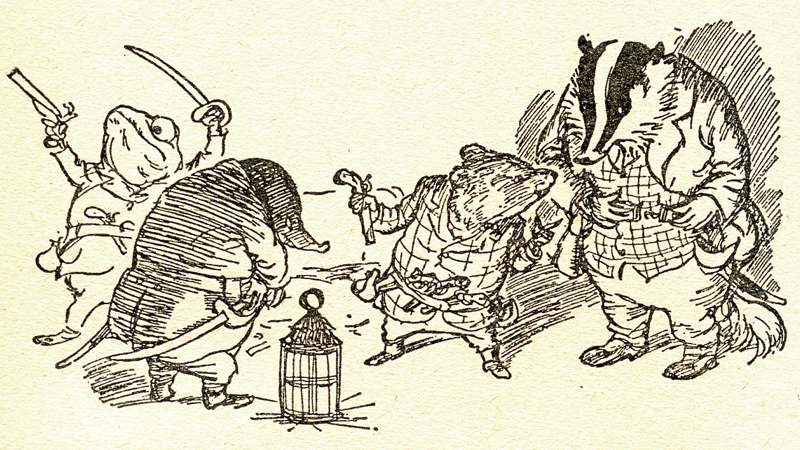
I love Mole’s hunched and determined posture.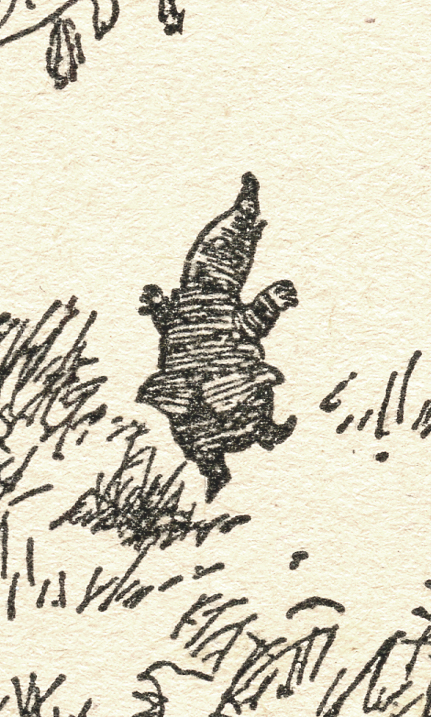
Here’s Shepard’s Mole again doing a leap, with its stumpy rounded shape, true to animal form.
Here is Inga Moore’s Mole strolling through a glorious landscape.
The Wind in the Willows was the last book Arthur Rackham illustrated.
Here’s his Ratty loading up the boat with that all-important luncheon basket. To me Rackham’s animals seem more human in form than Shepard’s, with longer limbs and more human knees and elbows.
Here’s the same scene from EH Shepard.
Some glowingly depicted scenes by Robert Ingpen.
But let’s return to the luncheon basket.
The Luncheon Basket
Here are Shepard’s Ratty and Mole stretching out after their picnic.
And here are Rackham’s animals laying out their spread.
That luncheon basket!
“What’s inside it?” says Mole…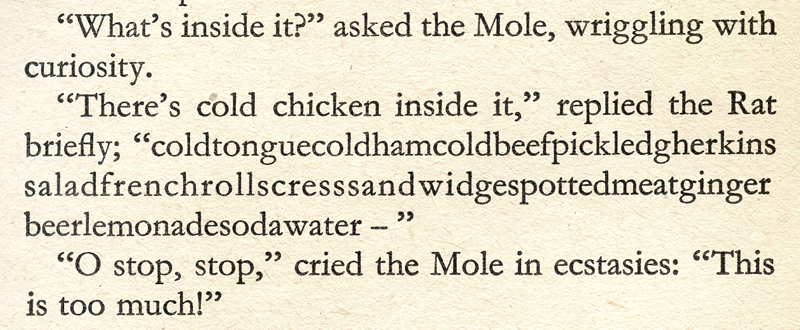
And that’s a slight problem to me, as I know that moles eat mainly worms, grubs and insects, and water voles like Ratty eat vegetation mostly. And I do believe in being true to zoology. But as an illustrator I don’t think you can avoid drawing the beautiful meat-heavy pies described in that Edwardian picnic. It just wouldn’t be doing the picnic justice if you did.
But the copy of Wind in the Willows I treasure is this version by David Roberts.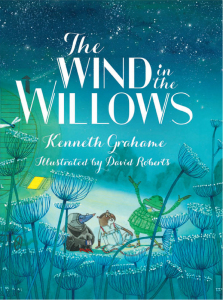
I love the carefully designed outfits: Mole’s velvety moleskin suit, badger’s tweeds and cardigan, Ratty’s Edwardian sporting whites.
The beautiful elegant Edwardian furniture, the audacious interiors…
and the pure poetry, the light and space: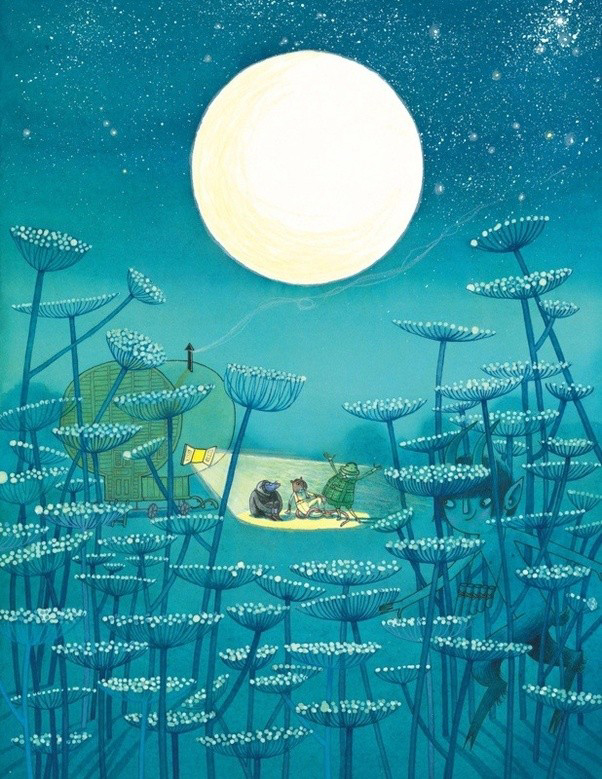
a moonlit field of cow parsley (with a hidden Pan),
mole submerged in bubbles and green water,
and this vista of willow weeping over.
But now let’s return to the very naughty Mr Toad.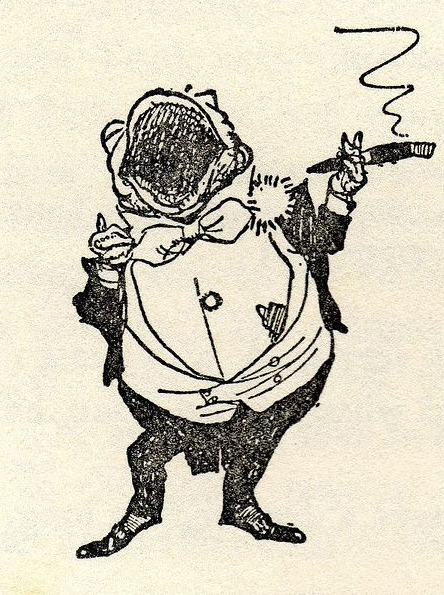
My favourite depiction of Toad has to be EH Shepard’s: irrepressible, unrepentant– a high-speed amphibian obsessed with the automobile.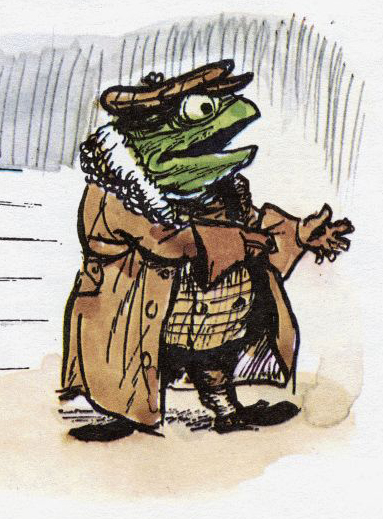
He is unsquashable, impetuous, possessed by an almost consumerist passion for the Motor Car.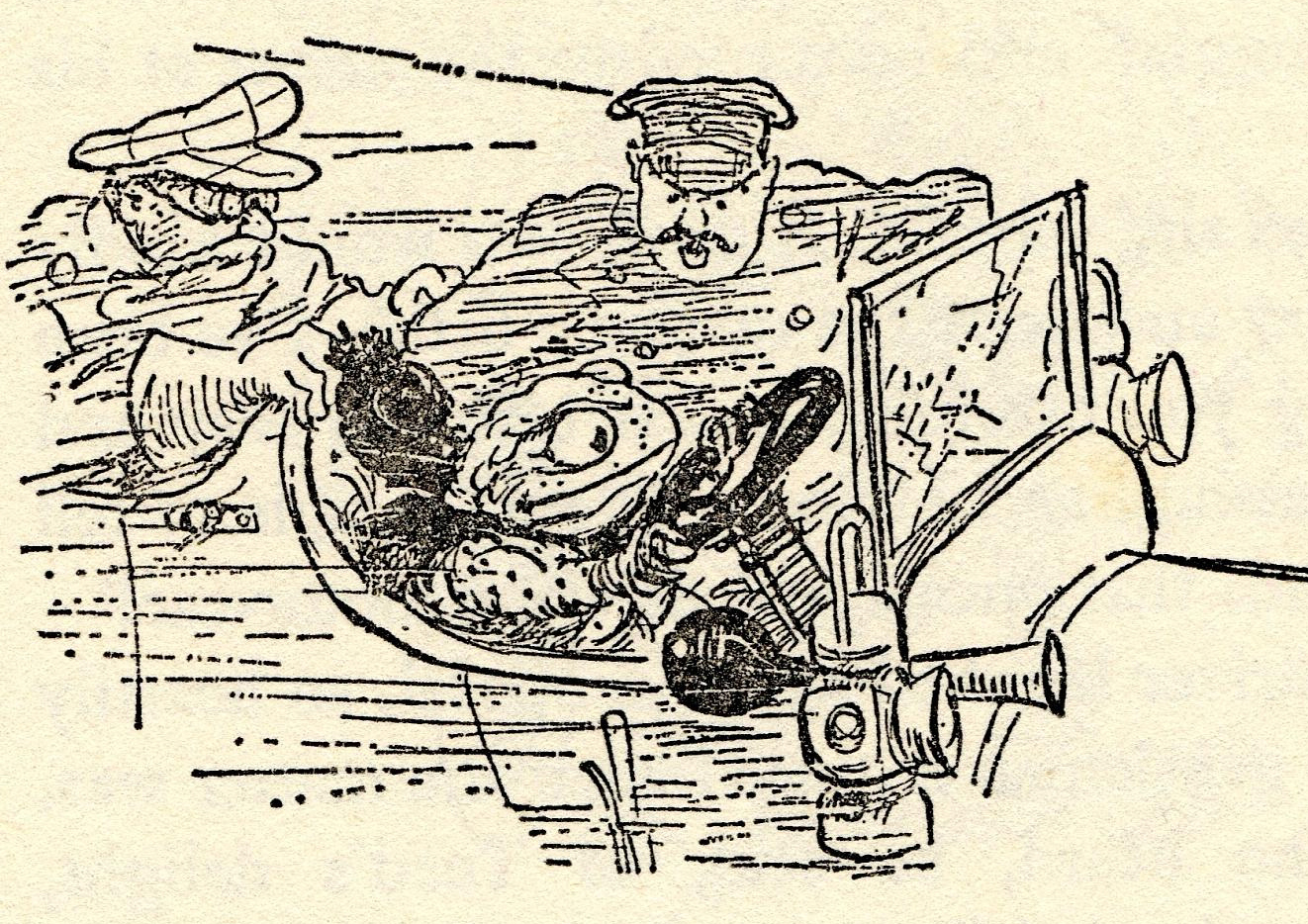
1907 saw the advent of the luxurious Rolls Royce Silver Ghost – “Silent as a Ghost, Powerful as a Lion, and Trustworthy as Time” – aristocratic motoring indeed.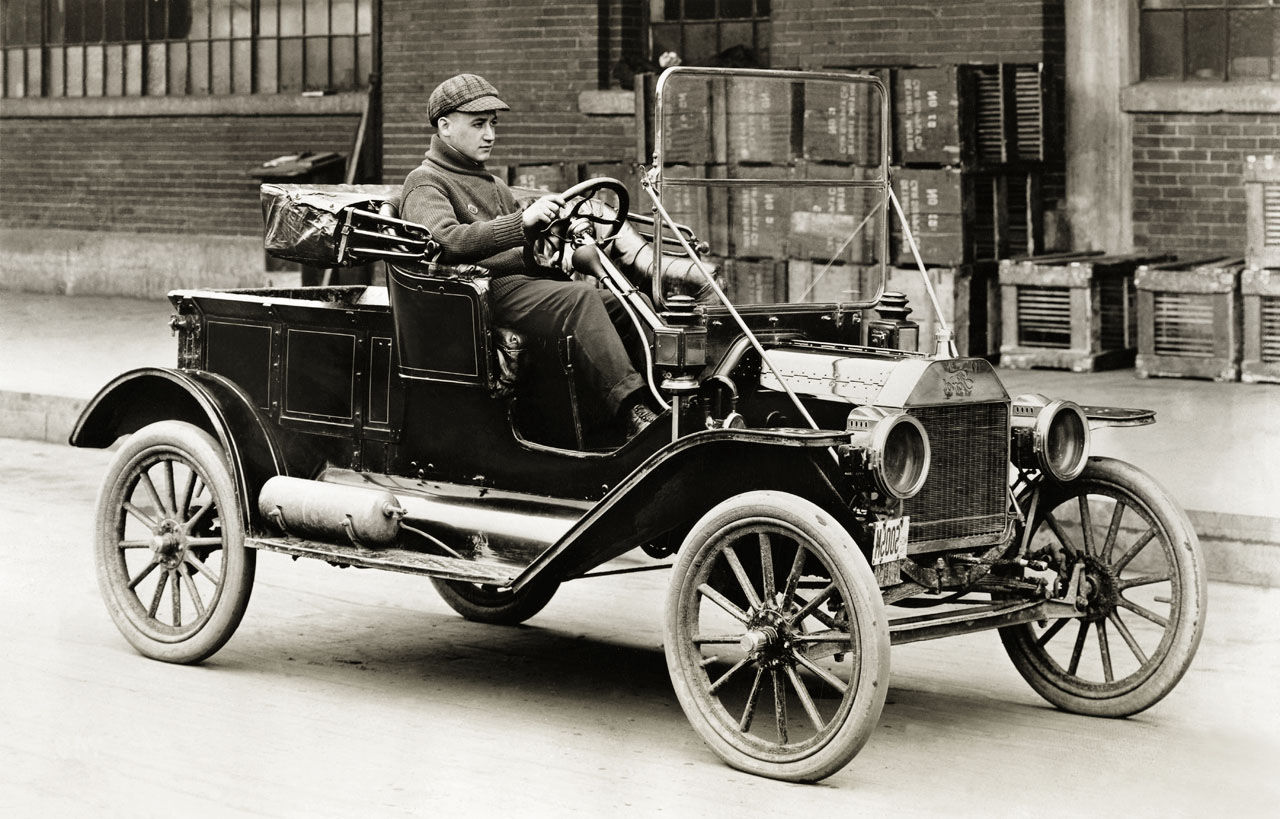
But in 1908 Henry Ford brought out the Model T Ford, bringing motoring to everybody – the coming of the car – and for the last 111 years our cars have been the blind influence in charge of shaping our landscapes.
Toad is enraptured and enthralled by the Car – “The only way to travel – here today, in next week tomorrow!”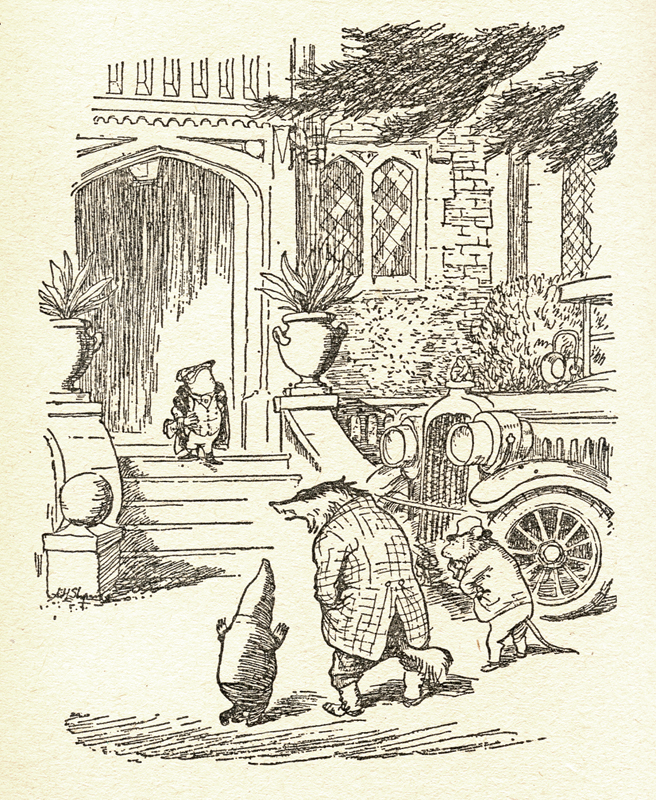
So the Willows shows this brand new force for a changing pace of life. And it’s torn between the urge to roam in dangerous places versus being safely cuddled up at home with toasted teacakes.
The Unbuilt Roads of Oxford Past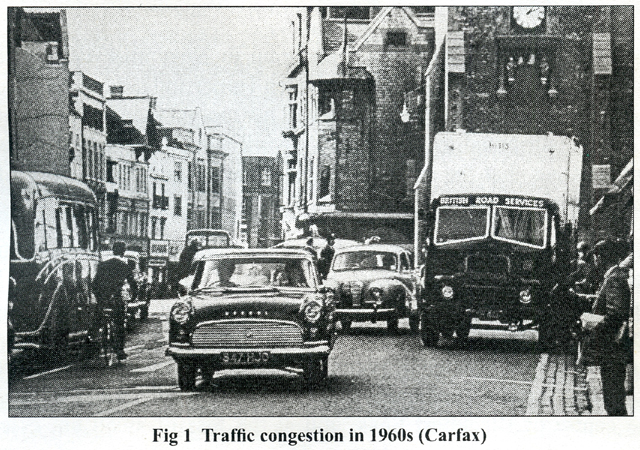
In the 1900s was the dawning of the Age of the Car, and by the 1960s the needs of car-travel was taking a major role in shaping city planning.
And in 1969 Oxford nearly had a superhighway built right through it. The city was very congested, traffic went right through the centre of it, so plans started to be hatched to make an inner relief road to speed up car travel times. Various schemes were planned, culminating in a planned motorway along the railway line and 4 lane west-east highway right through East Oxford.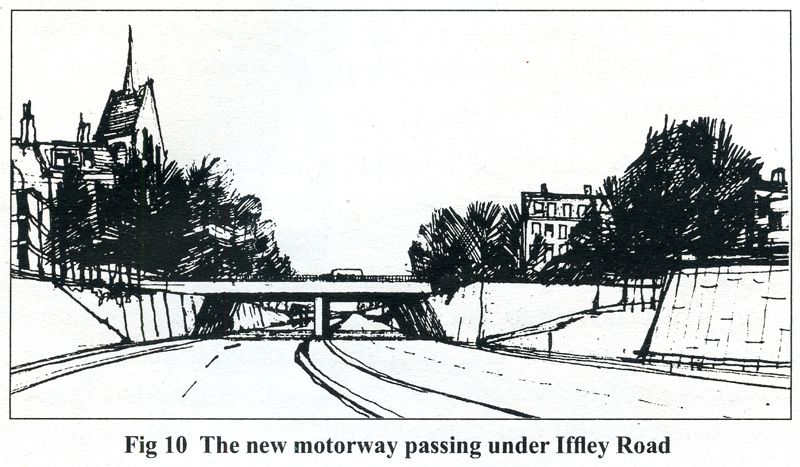
A visualisation of the road-to-be in 1969.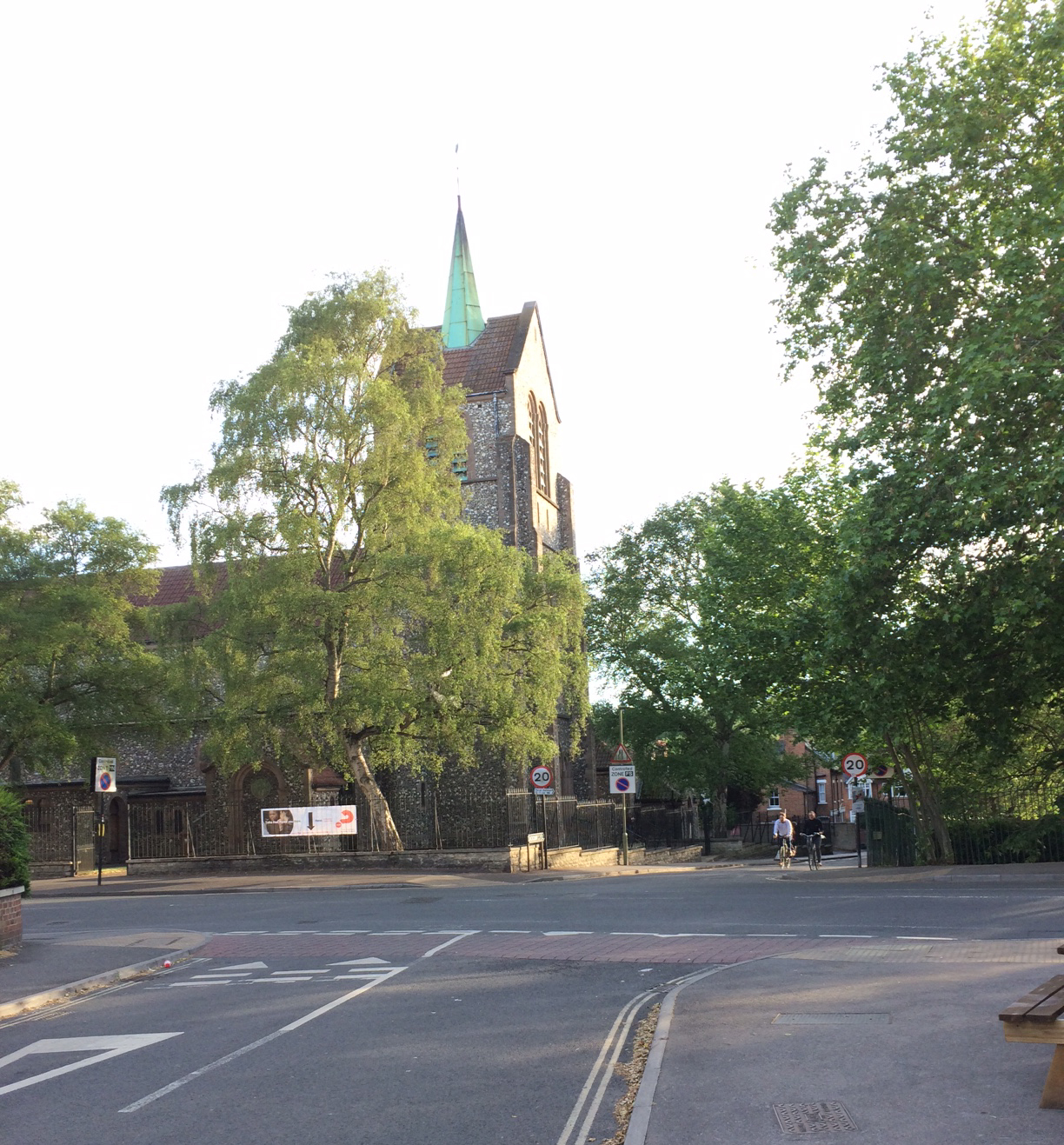
The same spot (I think!) as it is now.
I had a look at where this planned highway would have been.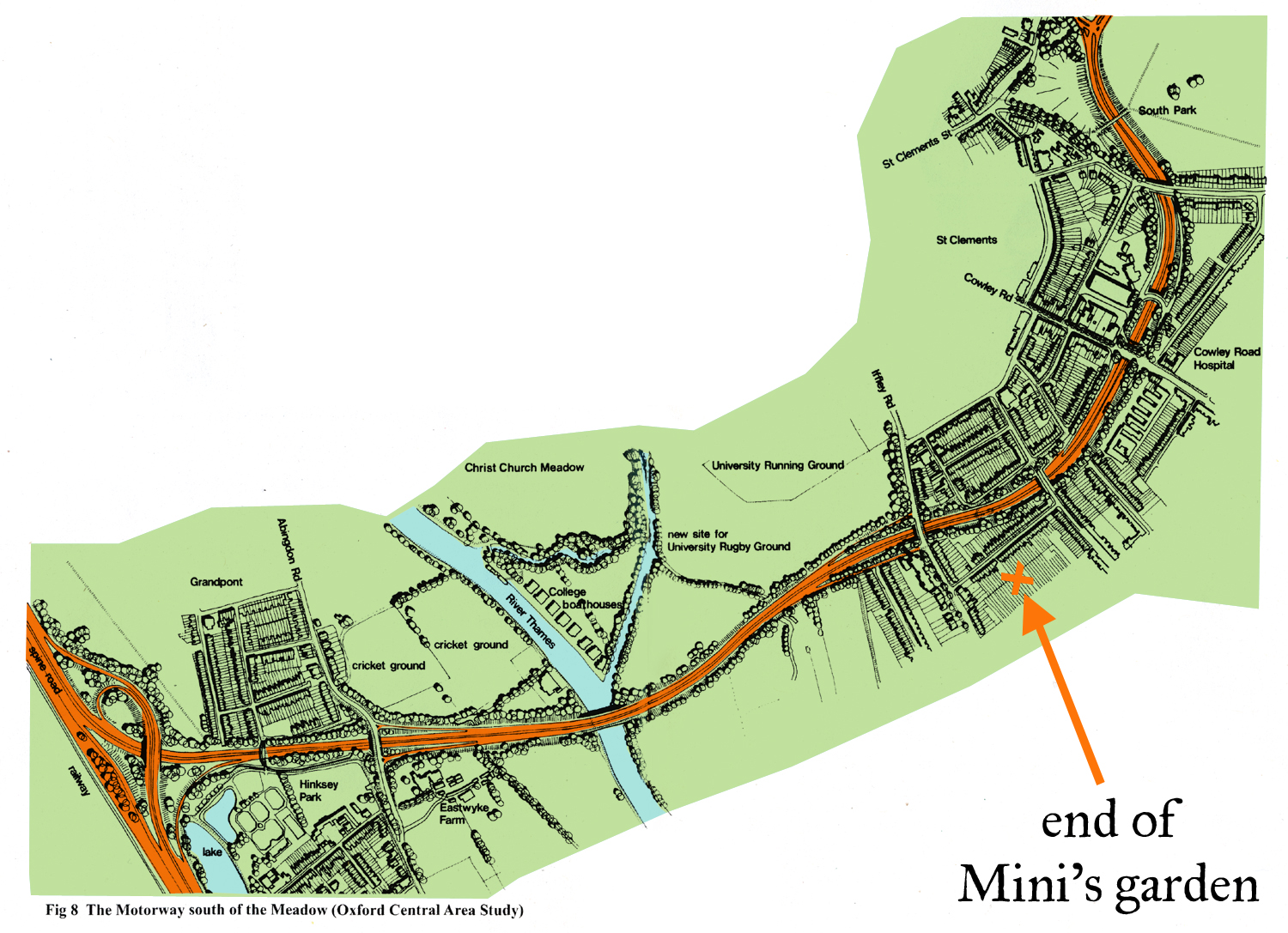
It would have been just at the bottom of our garden.
A four lane swathe of tarmac cutting through, an impassable barrier for humans and wildlife. I feel a shiver of horror for what could have been.
Planning proposals for an inner relief road hung over Oxford for almost 30 years. You can read more about the whole story here.
Luckily, in 1969, 50 years ago this year, Oxford Civic Society was formed to fight this brutal plan. They won the Battle of the Relief Road, and the planning of Oxford’s roads didn’t go with the needs of the car, but in Park & Rides and pedestrianisation.
Thank you, Oxford Civic Society!
However, Frankenstein’s monster-like, massive road-building plans refuse to stay buried. There’s now the hulking zombie of the proposed Oxford-Cambridge Expressway haunting the future.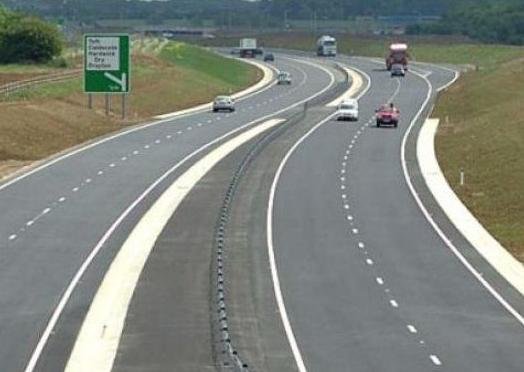
Back to the Riverbank
I have recently finished being in the zone of Wind in the Willows.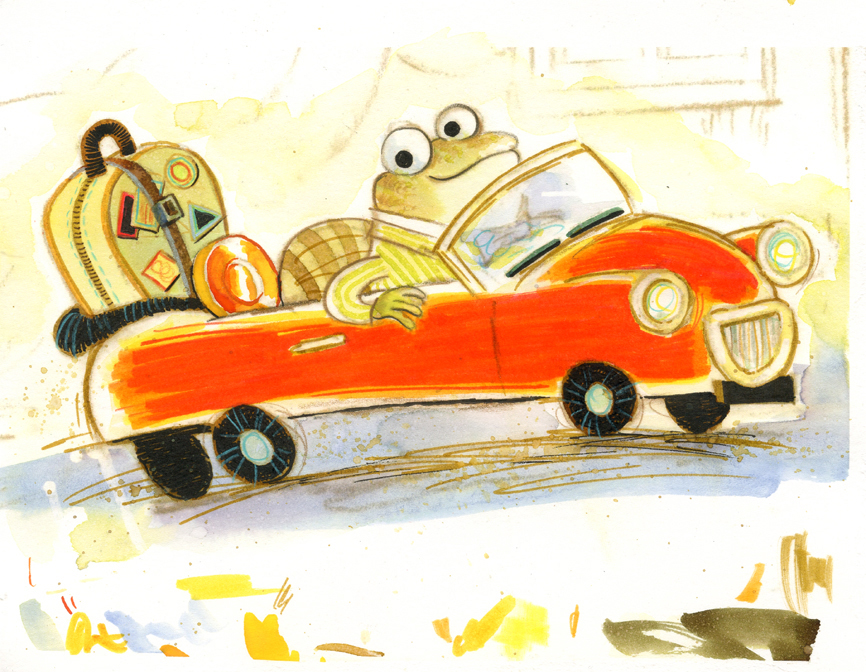
I was illustrating a story by the poet Roger McGough (who has adapted Wind in the Willows for the stage.) The story is called Money Go Round, and is all about the journey of a coin through the paws of all the animals who live along the riverbank – and it starts with the naughty amphibian, Mr Toad.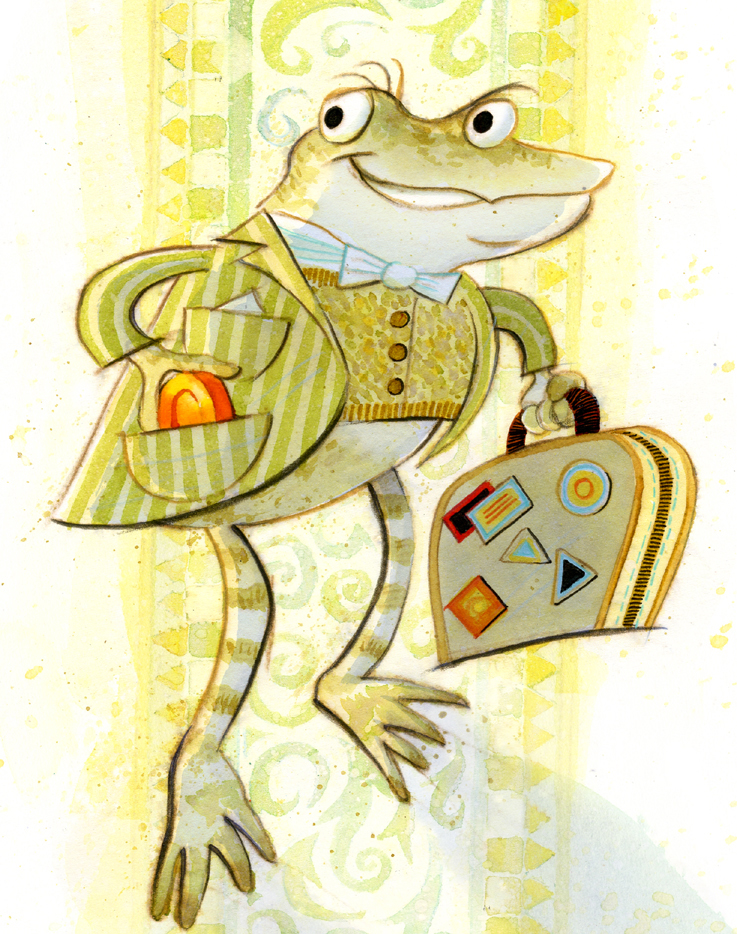
Our mole is female and runs a hotel,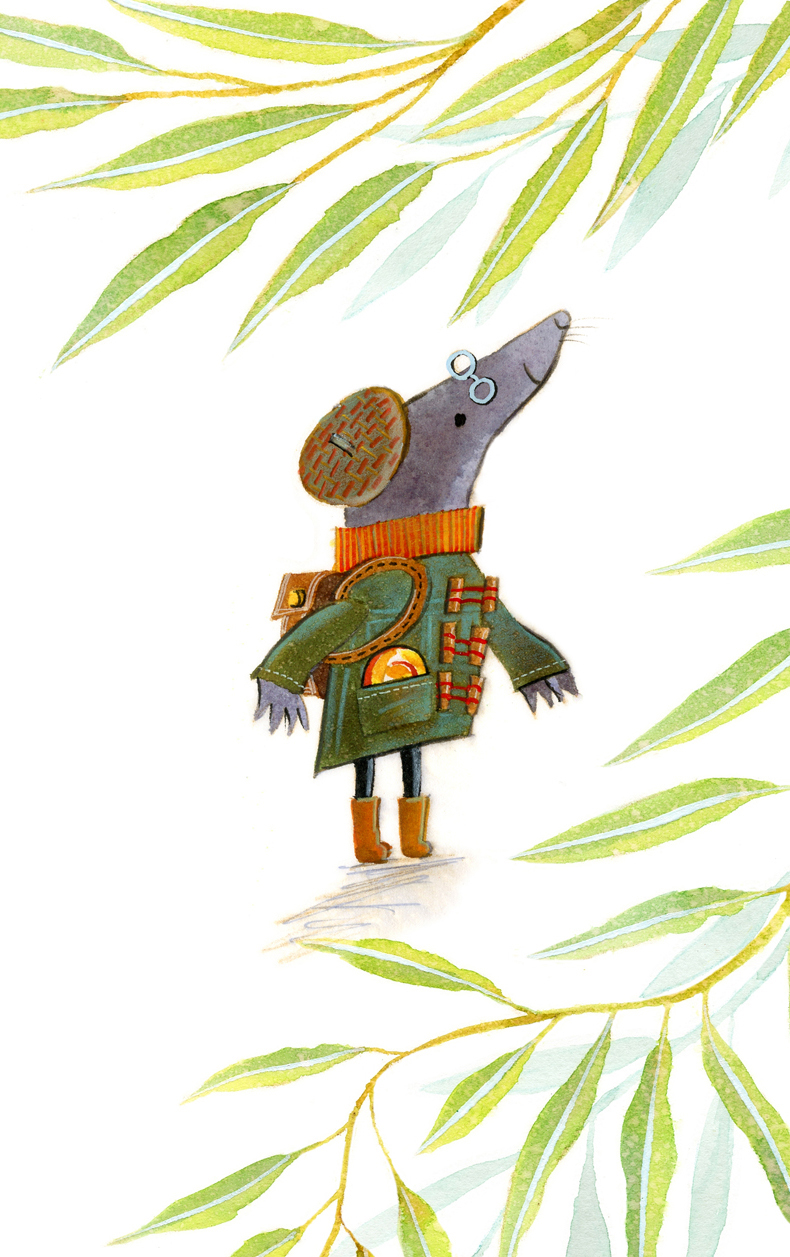
and there’s a painter-decorator stoat, a shack of weasels, and a magpie preening parlour. 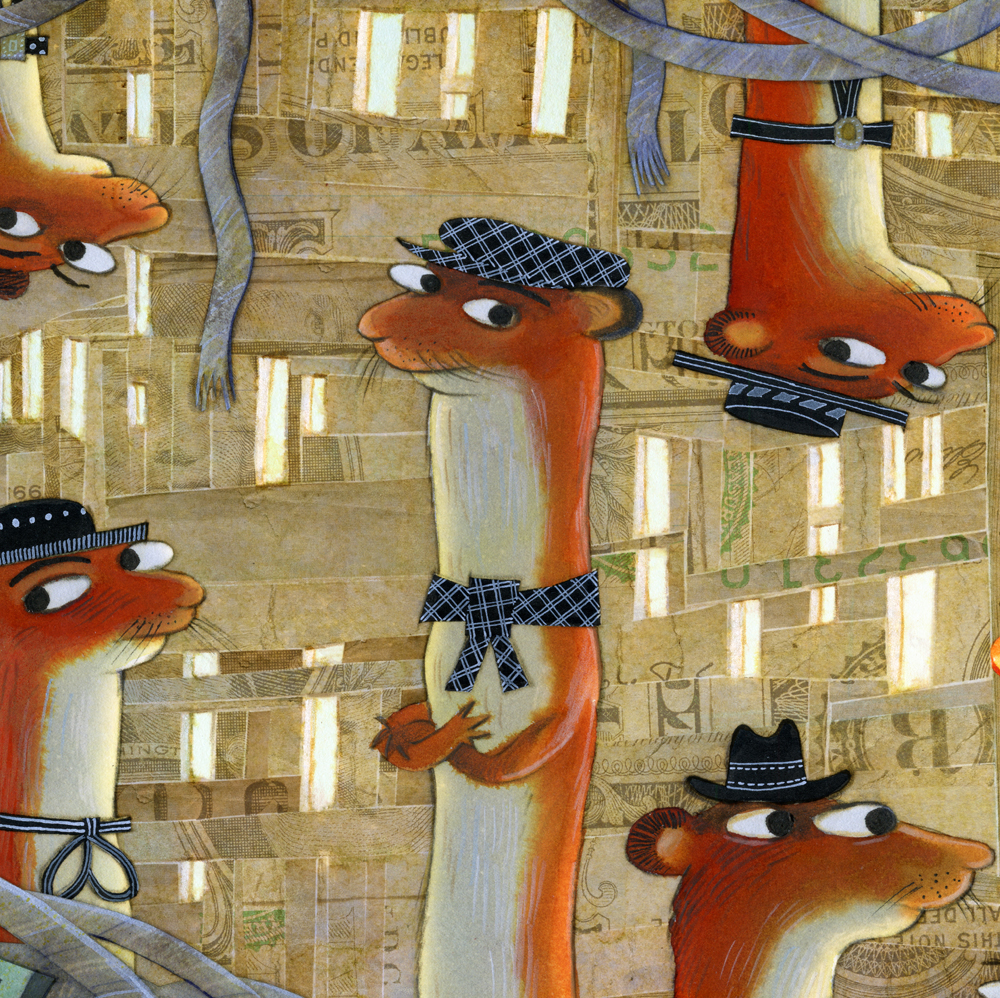
Working out how much to dress the animals was a dilemma I haven’t really had before. Here are character sketches.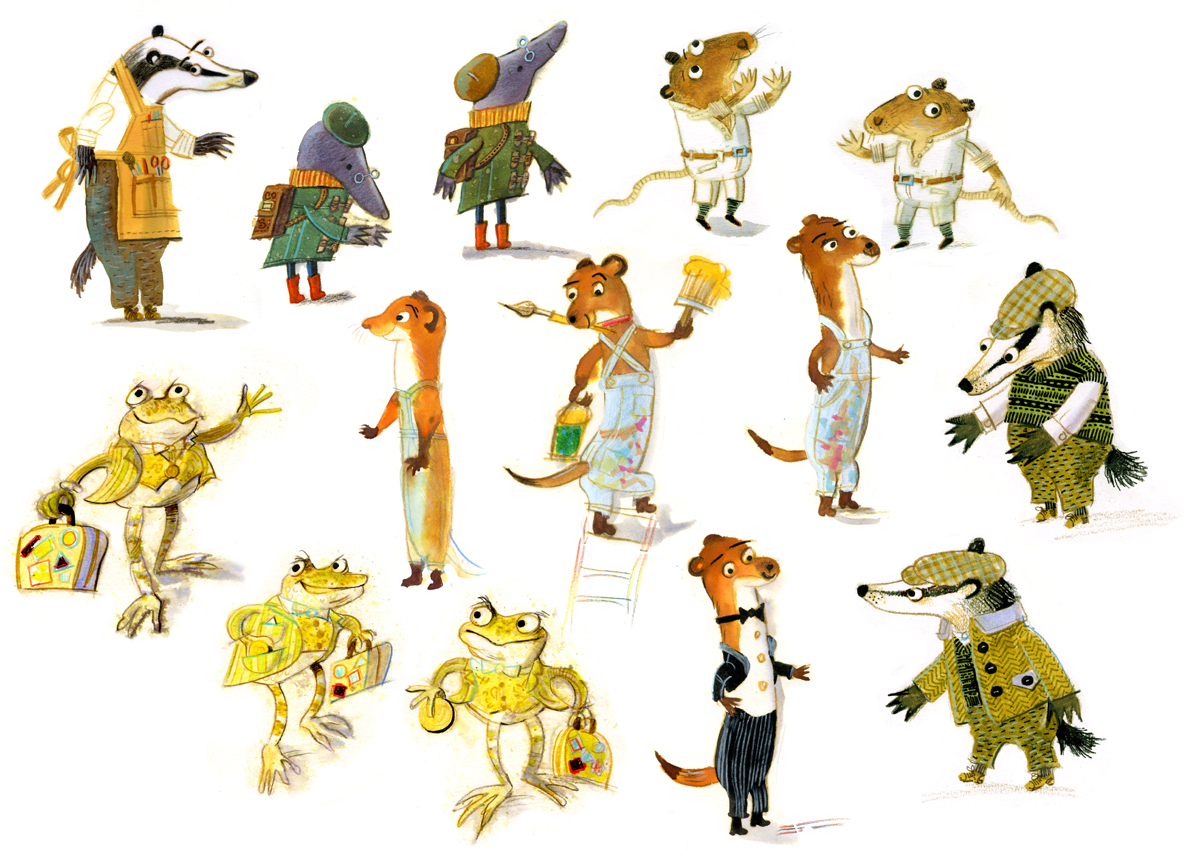
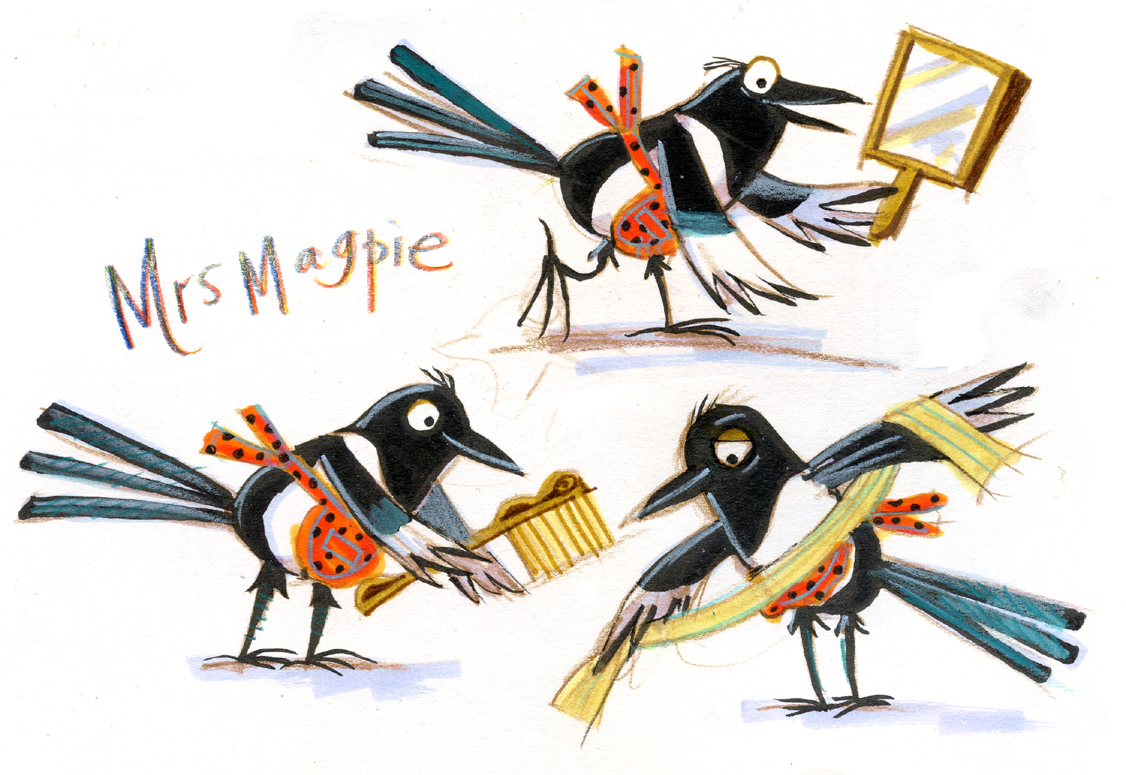
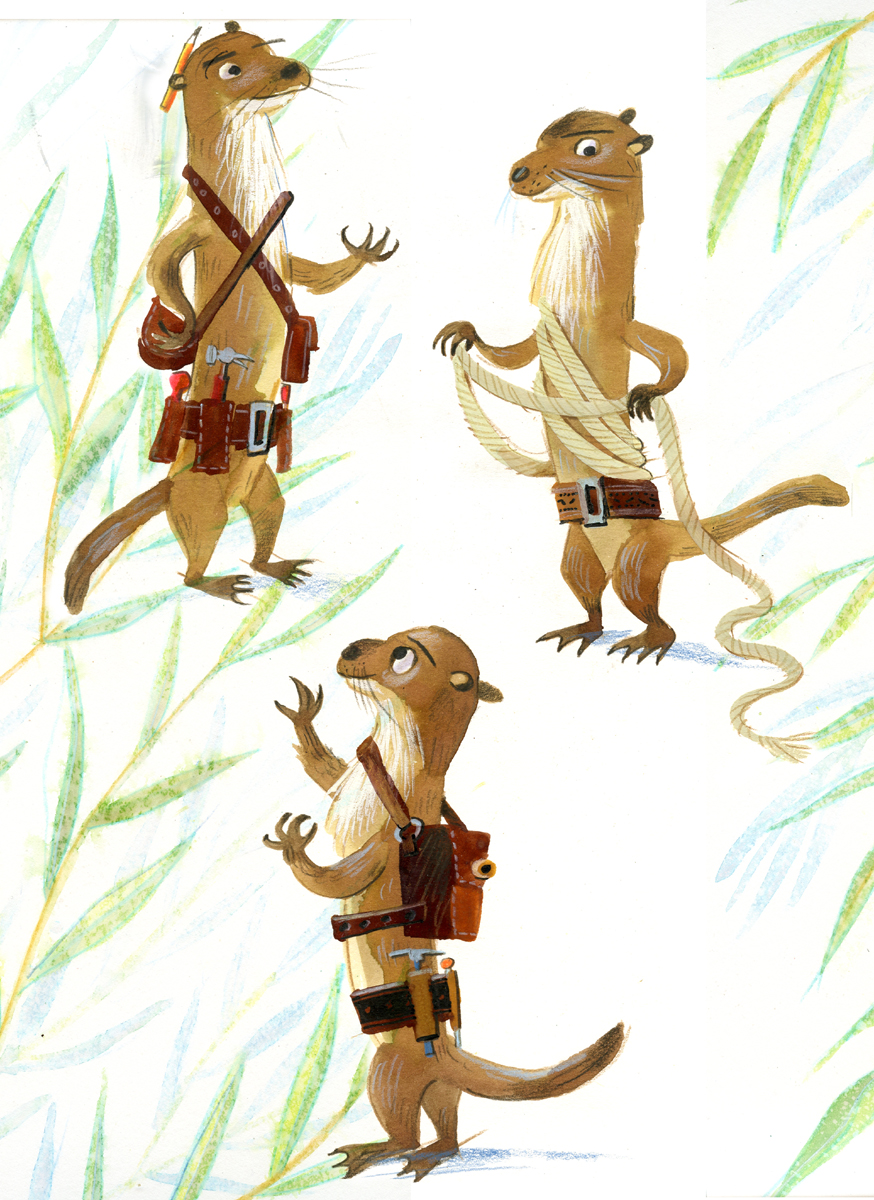 Most of all I wanted the river and the willows to flow through the pictures. So, to finish, here’s my favourite character, Walter Rat, in his boat, the Bootle:
Most of all I wanted the river and the willows to flow through the pictures. So, to finish, here’s my favourite character, Walter Rat, in his boat, the Bootle:
And here’s a PS:
The last picture shows how confused you can get when you are not good at left/right/backwards/forwards. I live near the river and I know you row with your back to where yiu are facing, but I still originally drew Ratty like this:
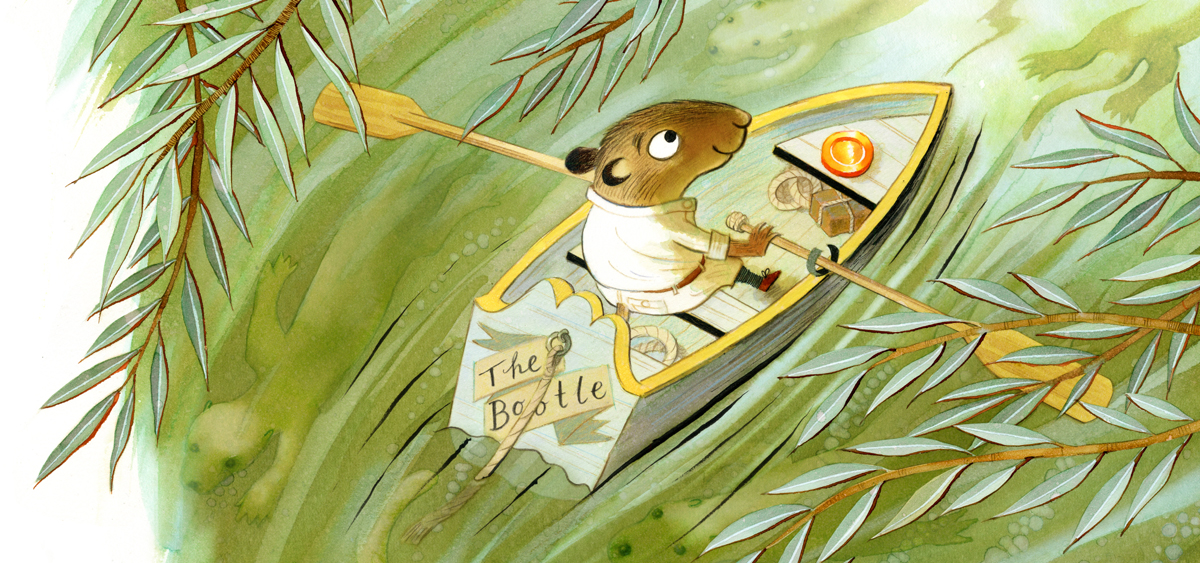 which looks right to me, because I’m thinking Ratty is coming towards me, out of the picture. BUT HE’S NOT!!! So many thanks to the fantastic Dave Shelton for gently pointing this out. And Dave Shelton should know these things, because he is the maker of the marvellous book A Boy, A Bear and a Boat.
which looks right to me, because I’m thinking Ratty is coming towards me, out of the picture. BUT HE’S NOT!!! So many thanks to the fantastic Dave Shelton for gently pointing this out. And Dave Shelton should know these things, because he is the maker of the marvellous book A Boy, A Bear and a Boat.